











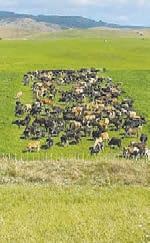










































Graze. Grow. Mate. Monitor. Page 1 inside Vol 22 No 15, April 22, 2024 View online at farmersweekly.co.nz $4.95 Incl GST
Up 1.8 tDM/ha on last season and an extra 24,657 kgMS in the vat



200t reduction in palm kernel, 82t DM less baleage fed - more than $100K in savings
Additional 5% in pasture harvested this season


Virtual fencing
Pasture management
Animal guidance
Heat detection
Animal health
Lifted 6WICR from 72% to 80%


Halter for dair y. Get started for 37% cheaper.
To learn more or chat with someone in your region go to halterhq.com
Kayne Smith, Southland
Jono and Kerri Robson, Hawkes Bay
Teagan Gray, Waikato
Dan Blair, Canterbury
Delays at EPA hamstring NZ tech uptake

GRINDING delays in New Zealand’s approval process for agrichemicals are prompting global companies to question if a viable market for new products still exists here. It also has leaders in the agrichemical and primary sector warning that NZ is becoming a backwater for adopting new crop and animal treatments, leaving it unable to respond to changes in trading partners’ regulations on chemical use.
Their frustration has been reinforced by a recent independent report on the performance of the Environmental Protection Authority (EPA), which is tasked with overseeing the approval of new agri-chem products.
Conducted by Australian firm Sapere, the report highlights how delays in getting approval for products has blown out to be almost three times longer than it was 10 years ago.
Getting a new product over the line now takes over three years, having taken 400 days in 2013. It includes spending more than 330 days in a “pre-application” queue.
In 2021-23 eight applications for new products took 1048 days, compared to 14 applications taking 402 days in 2014.
Dr Liz Shackleton, CEO for Animal & Plant Health NZ, said
the decline has come only over the past decade, with NZ now falling far from being a world leader in balancing good regulatory practice alongside timely releases of new treatment technology.
She said she gets feedback on a weekly basis from companies saying it is no longer viable to bring a product here if waiting times remain this lengthy.
She said there also appears to be a preoccupation at the EPA with re-assessing existing, older type chemicals over new product assessment.
“There is four times more resources allocated to re-assessing existing substances, versus approving new substances.
“Typically, the EPA would have re-assessed two to three products a year. This past year they reassessed 10.”
The Sapere report supports this, finding the EPA’s approval for new treatments has fallen from 47% of all decisions in 2013 to only 13% in 2023.
That comes despite relatively steady demand over the 10 years from companies seeking new product approvals.
The decline also comes as a new generation of “biological” crop treatments are replacing many older synthetic chemicals globally.
“And we have members here asking ‘How have these treatments that have got through approval in bigger, more resourced markets
Continued page 3




Bar may be set for rural advisers

Cowboy’s chickens come home to roost
Royalburn Station in Central Otago has attracted plenty of interest on Seasons 1 and 2 of Nadia’s Farm. One of its growing ventures involves chickens and their eggs, and Jodie Humphries is the former cowboy vet nurse in charge of them.
PEOPLE 18




Other A&P shows unlikely to follow New Zealand Agricultural Show’s lead in cutting back.
NEWS 3
Business is blooming on sunflower farm
A roadside sunflower-selling venture has blossomed into a full-time tourist business for Deanne and Phil Crowder.
ARABLE 22-26
New research says agriculture and NZ have to plan for alternative proteins.
NEWS 4
BONUS HONDA BATTERY KITS WITH SELECTED FARM BIKE



S*
The opening of the duck-shooting season is Christmas in May for Phil Weir.
OPINION 19

* Offer valid until 30/06/2024. Available while stocks last at participating Honda dealers only. Offer only available on payment with Farmlands Card. Farmlands terms and conditions apply. For full terms and conditions and to view selected models go to hondamotorbikes.co.nz.
hondamotorbikes co nz
1
Vol 22 No 15, April 22, 2024 View online at farmersweekly.co.nz $4.95 Incl GST
10
SECTORFOCUS
Richard Rennie TECHNOLOGY Regulation
EDITORIAL
Bryan Gibson | 06 323 1519
Managing Editor bryan.gibson@agrihq.co.nz
Craig Page | 03 470 2469
Deputy Editor craig.page@agrihq.co.nz
Claire Robertson Sub-Editor claire.robertson@agrihq.co.nz
Neal Wallace | 03 474 9240 Journalist neal.wallace@agrihq.co.nz
Gerald Piddock | 027 486 8346 Journalist gerald.piddock@agrihq.co.nz
Annette Scott | 021 908 400
Journalist annette.scott@agrihq.co.nz
Hugh Stringleman | 09 432 8594 Journalist hugh.stringleman@agrihq.co.nz
Richard Rennie | 027 475 4256
Journalist richard.rennie@agrihq.co.nz
Nigel Stirling | 021 136 5570 Journalist nigel.g.stirling@gmail.com
PRODUCTION
Lana Kieselbach | 027 739 4295 production@agrihq.co.nz
ADVERTISING MATERIAL Supply to: adcopy@agrihq.co.nz
SUBSCRIPTIONS
0800 85 25 80 subs@agrihq.co.nz PRINTER
Printed
SALES CONTACTS
Andy Whitson | 027 626 2269
Sales & Marketing Manager andy.whitson@agrihq.co.nz
Andrew Fraser | 027 706 7877
Auckland/Northland Partnership Manager andrew.fraser@agrihq.co.nz
Jody Anderson | 027 474 6094
Waikato/Bay of Plenty Partnership Manager jody.anderson@agrihq.co.nz
Palak Arora | 027 474 6095
Lower North Island Partnership Manager palak.arora@agrihq.co.nz
Omid Rafyee | 027 474 6091
South Island Partnership Manager omid.rafyee@agrihq.co.nz
Julie Gibson | 06 323 0765
Marketplace Partnership Manager classifieds@agrihq.co.nz
Andrea Mansfield | 027 602 4925
National Livestock Manager livestock@agrihq.co.nz
Real Estate | 0800 85 25 80 realestate@agrihq.co.nz
Word Only Advertising | 0800 85 25 80
Marketplace wordads@agrihq.co.nz



our pioneering spirit tells us nothing’s out of reach

News in brief Assurance
Horticulture New Zealand is seeking government assurance that any changes to the Resource Management Act will not put vital domestic fruit and vegetable production at risk.
The organisation wants a range of amendments to proposed reforms, including recognition of the national importance of protecting highly productive land for primary production.
Fixed price demand
Fonterra’s first two fixed milk price events for the 2024-2025 season saw an estimated combined 800 farmers send in applications.
The first event in March saw 100 farmers apply for a fixed milk price offering of $8.09/kg MS. The most recent event in April saw 700 farmers apply for a total of 33 million kg MS with 30 million kg MS made available. This offering was for $8.51/kg MS.
Funding support
Projects working on improving New Zealand beef herd genetics and eliminating the effects of facial eczema will receive $1.7 million from the NZ Meat Board.
The Informing New Zealand Beef genetics project will receive $700,000 and up to $1m will be allocated to the Eliminating Facial Eczema Impacts project. The decision follows consultation with sheep and beef farmers on how to distribute interest and dividends generated from the Meat Board’s $79m reserves fund to industry good projects.
Financial workshops
Farmers are being encouraged to take more ownership of their farm business finances by getting involved in Rabobank Financial Skills Workshops.
The free one-day workshops are facilitated by Lawrence Field from Rural Field Consultants and are open to both clients and non-clients of Rabobank. Six workshops have already taken place this year, with a further 24 scheduled over the remainder of 2024.
Back in 1860, exporting meat to the other side of the world seemed about as easy as nailing gravy to the ceiling. But a few determined kiwis took the bull by the horns and now our grass-fed beef and lamb is sought-after all around the globe.

At AFFCO, we see the same pioneering spirit alive and well in farmers today. We’re playing our part too – exploring every opportunity to take New Zealand’s finest farm-raised products to the world.



WWW.AFFCO.CO.NZ 0800 233 2669
WAVE200472 AFFJ200472 NZ Farmers Weekly Strip Ad FA.indd 1 24/08/22 3:22 PM 2
Zealand’s
information
New
most trusted source of agricultural news and
Contents
SLICED: More cuts to science funding will move NZ even further below the OECD average for science R&D spend, says Lincoln’s Professor Jon Hickford. STORY P7 News . . . . . . . . . . . . . . . . 1-15 Opinion . . . . . . . . . . . 16-19 People . . . . . . . . . . . . . . . . 20 Technology . . . . . . . . . . . . 21 Sector Focus . . . . . . . 22-26 Federated Farmers . 27-30 Real Estate . . . . . . . . 31-32 Marketplace . . . . . . . 33-34 Livestock . . . . . . . . . . 34-35 Markets . . . . . . . . . . . 36-41 Weather . . . . . . . . . . . . . . . 42
Advertise Get in touch
PUBLISHERS
and Cushla Williamson Phone:
Farmers Weekly is Published by AgriHQ PO Box 529, Feilding 4740, New Zealand Phone: 0800 85 25 80 Website: www.farmersweekly.co.nz ISSN 2463-6002 (Print) ISSN 2463-6010 (Online)
Dean
027 323 9407 dean.williamson@agrihq.co.nz cushla.williamson@agrihq.co.nz
by Stuff Ltd Delivered by Reach Media Ltd
Thrifty A&Ps keep the show on the road
 Neal Wallace MARKETS Events
Neal Wallace MARKETS Events
NO OTHER A&P show society has so far followed the New Zealand Agricultural Show in Christchurch in deciding to hold a dramatically reduced event this year.
Rachel Walker, the president of the Royal Agricultural Society, which represents 90 agricultural & pastoral societies, said no other societies have advised of their intention to cancel or run a pruned-back event.
An expected a tsunami of cancelled shows after covid never happened, and she said some have bounced back quickly as rural communities rallied in support.
Walker said the circumstances of each society differ. Some own their land and buildings and some operate events all year round.
“They all have very different operating models.”
BACKWATER:
Dr Liz Shackleton, CEO of Animal & Plant Health NZ, says more multinational companies are doing a double take about NZ’s lengthy approval delays for new crop and animal treatment products.
The common denominator all societies are struggling with is a declining number of volunteers, she said.
Entities approached who run successful shows and agricultural events concurred that a comparison with Canterbury is not possible as each situation differs.
A common factor they gave for their success is containing costs.
The Canterbury A&P Association board last week announced it will limit this year’s show to livestock judging and competitions in the hope a revamped public event will return next year.
Board chair Stewart Mitchell said disruption from two covidimpacted years plus a financial loss last year were factors in the decision.
A business model in which 12 months of costs are hopefully recovered from three show days is unsustainable, he said. Mitchell said the association’s financial reserves are limited and it cannot sustain the risk of another

Continued from page 1
still experiencing such a delay here?’”
Shackleton’s concerns are echoed by Foundation for Arable Research CEO Dr Alison Stewart.
She said she has spent the past decade trying to get greater awareness about what the delays mean for crop and pastoral farmers.
“One issue we have is the report clearly shows how the EPA is underfunded, receiving about $5 million a year.”
The Sapere report authors found that NZ’s EPA receives about a quarter of the funding that its Australian and United Kingdom equivalents get when allowing for the primary sector’s value to the economy.
Despite injecting a further $1m into the EPA in the last budget, the report highlights NZ is “well short”, and continuing funding failure brings escalating losses in innovation, primary sector productivity, and limits our ability to transition to “greener” chemicals including biologicals.
Stewart agrees with the report authors that simply increasing
loss this year but is working with the show’s General Committee to consolidate revenue and reserves and planning for a return in 2025.
The board is also completing a governance review and is close to agreement with the Christchurch City Council on land over which the association holds a 100-year lease; it will transfer it to the council for public use.
The chair of the Upper Clutha A&P Society board, Keith Cooper, said this year’s event in Wanaka attracted 44,000 people and it is considering whether it has space for more people and exhibitors.
Cooper said the secret is containing costs.
“You can’t increase the entry fee or people will not turn up and I believe we have pitched site fees at a level that attracts exhibitors.”
A small number of staff are paid on contract as needed and the society does not own its grounds.
The other focus is providing a point of difference for the predominantly urban audience, one that celebrates agriculture and rural communities.
Peter Nation, the New Zealand National Fieldays Society chief executive, said a common factor with field days and A&P shows is that running either is difficult.
Fieldays has bounced back from covid, which he attributes to loyal supporters and the efforts of staff creating an event that resonates throughout NZ and around the world.
“We make a big effort to stay on point and to stay relevant,” he said.
He said covid taught the society resilience and the need to be able to pivot.

CHALLENGING: Canterbury A&P Association board chair Stewart Mitchell says the association cannot sustain the risk of another loss this year.
Andy Thomson, a co-owner of AgFest West Coast, said to be successful events need to be innovative and satisfy the expectations of exhibitors and the public.
“Unless both are in sync, you will come unstuck.”
Thomson said AgFest is run on the smell of an oily rag, without any frills.
fees paid by companies seeking approval would not solve the funding problem.
“If we increase the fees it is going to potentially put off these large multinationals coming into a small market like NZ. It comes down to a bigger issue of government’s commitment to support and facilitate new products coming to NZ to improve agricultural productivity.
“If they are [committed to that], then they need to re-think the business model for the EPA.”
Shackleton said the agri-chem industry wants to work with the government to help expediate the country’s uptake of new treatment technology before NZ gets left any further behind.
One option is the “rule of 2” approach. This streamlines new product approval here when two large approved overseas countries have already approved a product for release in their own markets.
“We need to consider options. When you are trying to say you are a global innovator, and it is a five- to nine-year period for approval, then that is a real challenge.”
You can’t increase the entry fee or people will not turn up and I believe we have pitched site fees at a level that attracts exhibitors.
Keith Cooper Upper Clutha A&P Society
Funding crunch cited for EPA drag
 Richard Rennie TECHNOLOGY Regulation
Richard Rennie TECHNOLOGY Regulation
DR CHRIS Hill, the Environmental Protection Authority’s general manager for hazardous substances and new organisms, makes no secret of the fact that constrained funding has slowed the agency’s work.
In a written response to Farmers Weekly questions, he acknowledged the EPA works in the context of limited funding and resourcing.
Despite industry concern over EPA delays, it also appears it is unlikely to be up for additional funding this Budget round.
Hill confirmed the EPA was not invited to bid for additional Budget funding this year.
“Inevitably, we have struggled to keep pace with the number of new applications. Funding constraints have made recruitment and retention of staff challenging,” he said.
The EPA did receive an additional $1.1 million in last year’s Budget and was moving to employ seven extra staff over two years, with three on board now.
Post-covid staff turnover of 25% had also resulted in a need to recruit and train new assessment staff.
Asked how much additional funding would be required to bring the EPA into line with Australia and Canada, he cited the Sapere report’s comparison.
This shows the NZ authority received only a quarter of the amount that the organisations
in Australia and United Kingdom receive, when allowing for primary sector’s economic contribution.
A spokesperson for Minister for the Environment Penny Simmonds said the minister is seeking advice from her officials on this and will be investigating further.
“She will be able to make more fulsome comments on this in due course,” the spokesperson said.
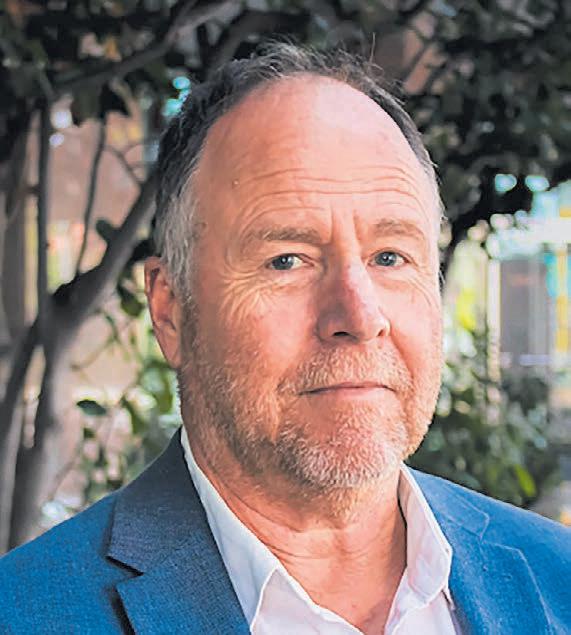
LIMITS: The Environmental Protection Authority’s general manager for hazardous substances and new organisms, Dr Chris Hill, says it is unlikely to be up for additional funding this Budget round.
3 FARMERS WEEKLY – farmersweekly.co.nz – April 22, 2024 News 3
‘NZ has to plan for alternative proteins’
 Gerald Piddock TECHNOLOGY Exports
Gerald Piddock TECHNOLOGY Exports
NEW Zealand needs to prepare for significant changes to its food export markets as food technology improves and alternative proteins emerge.
This new technology could significantly impact pastoral land use change with one scenario predicting a 35% reduction in dairy land holdings, according to a new report, Protein Futures: Future scenarios for land use in Aotearoa New Zealand.
The study was undertaken by researchers from the University of Otago and Lincoln Universitybased AgriBusiness Group, who presented their findings at a webinar organised by Our Land and Water.
The researchers developed four scenarios based on different rates of technological advancement for the main alternative protein technologies, with associated growth in consumer demand.
The first of these scenarios acts as a conservative, “business as usual” baseline. The second has precision fermentation take off while demand for plant proteins continues at current growth. The third sees plant-based products take off while the barriers facing precision fermentation and cellular meat products are eased, but not completely eliminated, and the final scenario has all alternative proteins take off.
Economic and environmental modelling showed the NZ economy is not immune if alternative proteins take up 10% and 22% of the overall market by 2035, the AgriBusiness Group’s Stuart Ford said.
NZ must develop a strategy that has us participating in the global
alternative proteins market if we want to continue to grow our GDP while at the same time improving our nutrient loss and greenhouse gas emissions performance.
“New Zealand has to go with it rather than ignoring it,” he said.
When looked at from a land-use change perspective, dairy is the big loser if precision fermentation takes off in Scenario 2, losing 35% of land, affecting the financial viability of dairy farms.
Beef production, however, lifts 22% under this model.
Arable land holdings would also lift by 12% on the back of demand for crops such as sugarbeet used in the fermentation process.
What can NZ do to prepare for it? I think at the moment, watch this space.
Under the third scenario, dairy and sheep farming land would decrease by 15% each, beef by 8% and arable land by 37% as farmers switched to legume production.
Under Scenario 4, where all proteins take off, there would be a 29% decrease in land for sheep farming, 35% for dairy and a 21% increase in arable farming.
Forestry land also increases by 40% in the third scenario and 75% in Scenario 4, encompassing 1.7 million hectares.
“Economically, Scenario 2 is the worst result with a loss of dairying to substantially poorer land uses,” he said.
It would see a $7.994 billion loss to the economy.
Scenario 3 is the best and would see a $6.9bn gain as farmers switched to growing crops and

$2.6bn in value was added to the economy.
The fourth scenario is in between the others as it balances out land-use shifts with a large portion of previously agriculturally productive land converted into forestry.
From an environmental perspective, Scenarios 2 and 3 are similar in terms of nitrogen, phosphorus and greenhouse gas reductions, while the fourth scenario has the largest environmental gains.
University of Otago Professor Hugh Campbell said any one of these scenarios would have significant impact.
“These are complex impacts. This isn’t like the NZ wool industry being substituted out of existence by an industrialproduced, more agile and cheaper competitor with artificial fibres.
“This is a situation where, yes, there is potential for significant substitution in some traditional land-based areas but the alternative isn’t simply out-competing them on production and efficiency. It also has significant environmental performance implications.
“If you look at NZ under Scenario 4, this development alone meets our GHG reduction requirements for agriculture.”
Campbell said if any of the scenarios occur, it would represent a significant downsizing for the livestock footprint as these new technologies substitute out production that would have made dairy ingredients.
AgriBusiness Group director Jon Manhire said dairy ingredients would be the first to go if this technology could create these products at a lower price.
“That would put at risk our exports in that space.”
While it would have impacts,

GROWTH: NZ must develop a strategy to participate in the global alternative proteins market if the country wants to continue to grow its GDP, a study says.
it would not necessarily mean bankruptcy for companies such as Fonterra.
Professor Rob Burton of the Norwegian Centre for Rural Research said Fonterra had already invested in two precision fermentation companies, calling its approach to this issue sensible. Burying heads in the sand would be the biggest mistake that could be made with this technology, he said.
“What can NZ do to prepare for it? I think at the moment, watch this space.”
Milk forecasts firm as GDT marks time

Hugh Stringleman MARKETS
Dairy
THE Global Dairy Trade market took a breather in the second April auction, the GDT index increasing by only 0.1%.
To make up the index, anhydrous milk fat prices rose 1.7% and whole milk powder was up 0.4%, but on the downside were cheddar minus 8.5%, mozzarella minus 3.8%, and butter minus 1.4%.
Buying activity was very much subdued, results were in line with analysts’ expectations and both bullish and bearish factors were at play, according to NZX dairy analyst Rosalind Crickett.
“Front of mind for this GDT event was the escalating situation in the Middle East, and the implications for purchasing.
“While the Middle East buyers upped their quantities of WMP, they were down across all other products, lowering their total volume bought, both on the last event and last year,” Crickett said.
Westpac chief economist Kelly Eckhold said not much changed in terms of the mix of buyers in the auction.
“Chinese buyers pulled back a touch, but southeast Asian buyers took up a bit of slack.
“Overall prices remain around long-term averages.”
However, the Westpac forecasts of farmgate milk prices have firmed up.
“Futures markets have generally consolidated, making our $7.90 current season and $8.40 2025 season milk payout forecasts look neutral risk-wise.”
I think if we’ve learned... we absolutely cannot be too open and too transparent. We need to make sure that farmers are with us every step of the way.


“
Farmers Weekly managing editor Bryan Gibson for our weekly podcast covering the big issues in the food and fibre sector. It’s rich farming news for time-poor farmers. 4 FARMERS WEEKLY – farmersweekly.co.nz – April 22, 2024 News 4
Kate Acland, Beef + Lamb NZ chair Advocating for the loud and the quiet LISTEN NOW Join
Professor Rob Burton Norwegian Centre for Rural Research
BioLumic gets $5m to fatten up ryegrass
 Gerald Piddock TECHNOLOGY Pasture
Gerald Piddock TECHNOLOGY Pasture
AGRICULTURE biotech company BioLumic has received a $5 million investment from AgriZeroNZ to develop a highproducing, low-emissions farm pasture using ultraviolet light.
Founded in New Zealand, BioLumic is known for its UV light treatments that are applied to plants as seeds to regulate their genetic expression and unlock their natural genetic potential.
The treatments have been found to significantly improve plant performance across 12 crops including corn, soybeans and rice – driving double-digit yield gains, improved quality and enhanced immunity to pathogens.
Animals with high-fat diets –such as grain-fed cattle in more intensive barn farming operations overseas – have lower methane emissions.
Studies have found that a 1% increase in lipids (fat) content of feed will reduce methane emissions by ~5%.
The funding will enable
BioLumic to apply its technology to ryegrass with a goal to increase fat content and subsequently reduce methane emissions from animals that consume it.
BioLumic is targeting a 2-3% increase in the lipids content of ryegrass to drive methane reduction by over 12%.
Based in Palmerston North and with offices in the United States, BioLumic was founded in 2013 by Dr Jason Wargent, the company’s chief science officer and a professor in Plant Biology at Massey University.
Wargent said the same UV process will be used on ryegrass – it will be treated with the UV light during its seed stage prior to bagging for use. There are also plans for testing the plants out in the paddock.
“We’re going to go into farm trials and one of the KPIs will be persistence in a perennial ryegrass.”
Funding from AgriZeroNZ was part of BioLumic’s capital raise to enable application of its suite of products to address major sources of greenhouse gas emissions.
“We’ve developed light recipes
from billions of potential options that, with a precise application, can significantly increase plant performance across a range of crop varieties and growing conditions,” Wargent said.
“We’re confident we can achieve similar results in ryegrass with a focus on reduced methane, and we’re really pleased to be working with AgriZeroNZ to develop this important solution for New Zealand to put farmers at the forefront of low emissions pasture farming.”
AgriZeroNZ chief executive Wayne McNee said it could deliver a simple solution to reduce emissions on NZ’s pasture-based farms.
This in turn would help meet global customer demands for emissions reduction, protect trade agreements, and achieve New Zealand’s climate goals.
“Pasture is the foundation of the business for Kiwi farmers, so a pasture solution to curb methane and boost productivity will be an important option in their toolkit to reduce emissions.”
The announcement comes after the a2 Milk Company, ANZ Bank New Zealand and ASB Bank joined

ENLIGHTENING: Dr Jason Wargent, BioLumic founder and chief science o cer, observes rice seedlings under UV light. The more lipids in feed, the lower the emissions from the animals eating it.
AgriZeroNZ as shareholders in early April.
In announcing the new shareholders at an event at Parliament, Agriculture Minister Todd McClay said the government would match the new private sector contributions dollar for dollar, bolstering the AgriZeroNZ fund by $18 million.
We’re confident we can achieve similar results in ryegrass with a focus on reduced methane.
Dr Jason Wargent BioLumic
Food award winners cover the sweet and the sour

A HAND-made gelato, sauerkraut, a 55-day aged ribeye steak and an organic vegetable farm that helps patients recover from mental illness were among the winners at this year’s Outstanding NZ Food Producer Awards.
Award winners spanned the scale from large meat companies to tiny artisan producers with offerings from the sweet to the savoury to claim a plethora of category wins.
Alliance’s premium Pure South brand shared the title for Paddock Champion with Matangi Angus Beef, with Pure South’s 55-day aged ribeye alongside Matangi’s bavette flank steak. A less common cut, it was described by judges as a fantastic barbecue cut
with standout mouth feel and a clean taste.
New Zealanders’ growing love affair with gelato was confirmed with two producers claiming the dairy champion award. Matakanamade Gelato Factory by Charlie’s lemon gelato and Island Gelato’s rich chocolate flavour jointly claimed the trophy. Longtime food writer Lauraine Jacobs headed up the 25-judge panel in assessing the products and said it was pleasing to see a place in the awards for major food processors and tiny operators.

“After eight years we are continuing to see new products emerge and producers have even more imagination and show more innovation in presentation and taste as they develop new food ideas.
“There’s always a danger new food ideas can be over the top, but this year there was plenty to stimulate the palate without making really good natural food too overspiced and processed,” she said.
The Sustainability Award went to Hamlin Road Farm near Ardmore, Auckland.
The organic, commercial vegetable grower also operates as a mental health and addiction rehabilitation service.
The link between good nutrition and mental health is a key facet of the business’s philosophy,
along with growing high-quality vegetables.
Growing consumer interest in fermented foods was also recognised in awarding the Emerging Business Award to North Canterbury business Wild Child Ferments. Olivia Johnson produces sauerkrauts and kimchi, having started her business on her husband’s family farm in Greta Valley.
The popular public vote chose the Lindsay Farm Dairy from Hawke’s Bay as Favourite Food Producer. The Bio Grow certified farm provides milk directly to consumers.
The Hawke’s Bay region also claimed top award for NZ’s Favourite Farmers Market going to the Hawke’s Bay Farmers Market, open every Sunday morning in the Waikoko Gardens.











5 FARMERS WEEKLY – farmersweekly.co.nz – April 22, 2024 News 5
Richard Rennie NEWS Awards
FAN FAVOURITE: The Hawke’s Bay region claimed top award for NZ’s favourite farmers market, going to the Hawke’s Bay Farmers Market.
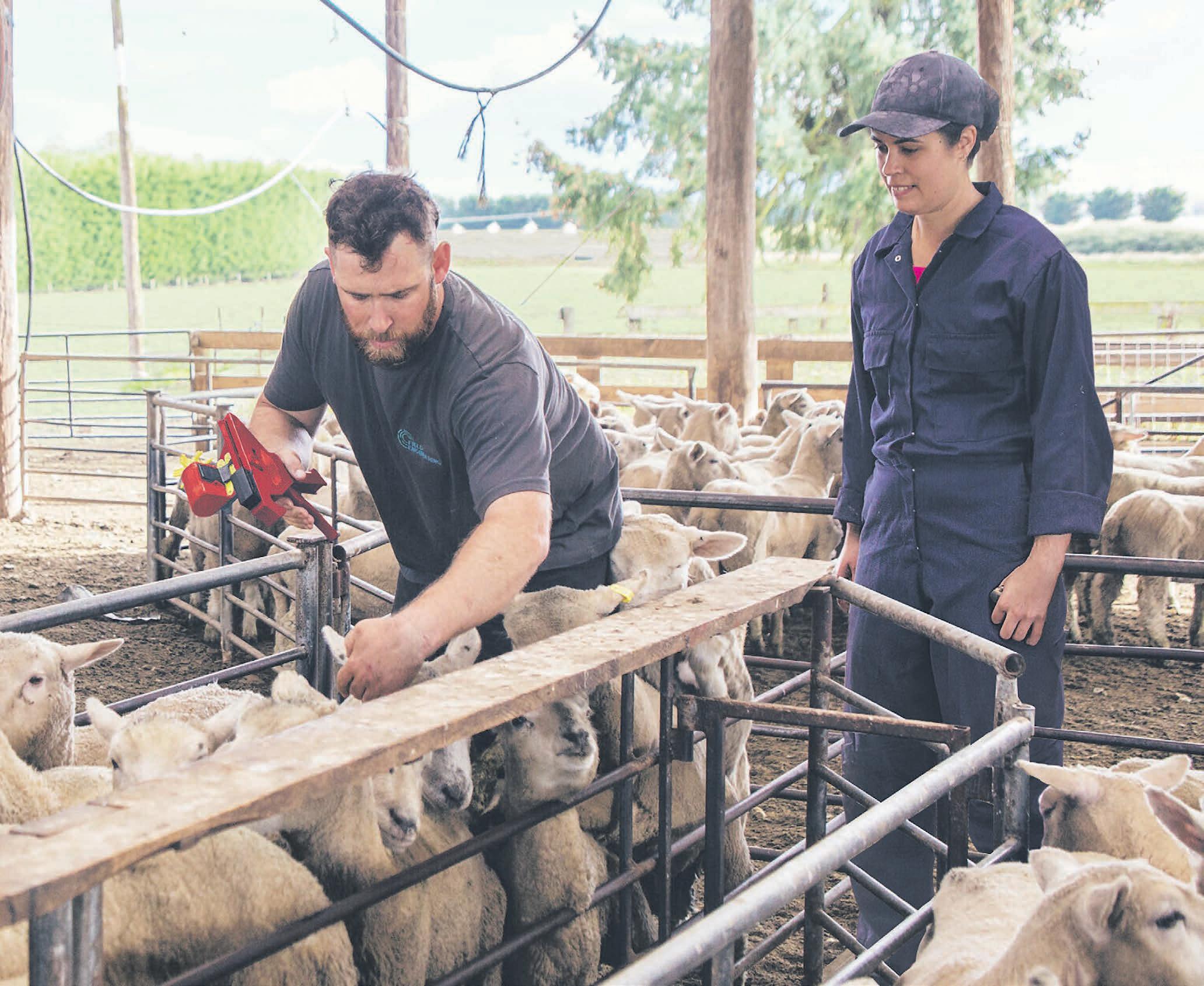
6
Cuts speed up race to bottom in all of OECD science spend
 Richard Rennie NEWS Education
Richard Rennie NEWS Education
THE government’s job chops across the public sector have a Lincoln University professor concerned New Zealand is only going to go from bad to worse in its global rankings for R&D investment.
Jon Hickford, professor at Lincoln’s Department of Agricultural Sciences, said he is watching with concern calls for 6-7% cost cutting measures across all government departments when national research expenditure is already relatively low.
“Between 2019 and 2023 AgResearch dropped from 722 full-time equivalents [FTEs] to 666 FTEs, which came at a time when there was considerable bloat occurring in almost every government department.”
The cost-cutting comes at the same time as $97 million in National Science Challenge funding runs out this June.
At this stage it remains unclear what and how much funding is due to replace it.
In the science area the axe has already fallen across NIWA and science advisers to the
Department of Conservation.
The Callaghan Innovation centre is also looking at a “strategic reset” that may see as many as 30 jobs go from its 382 in full-time employment, but details on where and when have not been made clear yet.
Scientists are nervously eyeing their futures in a country where expenditure on research and development as a percentage of GDP already sits well below the OECD average.
Latest OECD data indicates NZ spent 1.47% of GDP on R&D in 2022, compared to 1.67% for Australia, but well below the OECD average of 2.73%.
Israel has the highest investment of any country, averaging 5.6%, of which agricultural R&D claims a 42% share with an emphasis on a “startup” culture.
If the $97m of National Science Funding money is removed from the country’s R&D budget, NZ’s share of R&D as a percentage of GDP will fall to about 1.37%.
That puts NZ closer to the likes of Lithuania for investment levels, and behind Turkey.
Earlier this month climate scientist and New Zealander of the Year Dr Jim Salinger described NZ’s science spend as “shockingly poor”.

We seem to have been trying to talk ourselves out of primary sector production since Lange declared it a sunset industry back in 1988.
The new government has not yet declared the plans Labour had for science funding through the Te Ara Paerangi Future Pathways reform dead.
The plan aimed to boost funding to 2% of GDP.
It also had almost half a billion dollars earmarked to invest into Wellington, turning it into a “science city” and bringing together three research hubs focused on climate change, pandemic readiness and tech innovation.
But Hickford said he had mixed feelings about that programme.
“It felt like just a bit of a tweak, and I am not sure it really set out to address the base funding problems we have.”
He also believes there is a level of “anti-ag” sentiment in funding philosophies.
“We seem to have been trying to talk ourselves out of primary sector production since Lange declared it a sunset industry back in 1988.”
Then in 2001, Helen Clark’s Knowledge Wave conference aimed to increase growth in areas beyond the primary sector.
Hickford said he found it ironic that since that year the primary sector’s productivity has consistently outstripped all other sectors’ performance.
Labour productivity in the primary sector between 2008 and 2020 has consistently increased at 1.5% a year, over double that of other goods-producing sectors.
SLICED: Further cuts to science funding will only move NZ even further below the OECD average for science R&D spend, says
Hickford pointed to a report completed for the Treasury that valued the return on investment into agriculture between 1927 and 2001 as delivering a 17% per annum return.
While farmers and growers have proven adept at adopting new processes to maintain productivity growth, his concern is a decline in research means that growth will plateau as all existing researched practices are exhausted, and not replenished with new work.
This also comes at a time when demographics are seeing a generation of skilled researchers retiring. Timed with funding cuts, a skills vacuum is now a reality.
“We are already struggling to recruit domestic PhD students with the standard B Ag Science degree.
“We do get overseas students, but NZ’s relatively unique pastoral systems mean they take a decade to really understand.”
Ministry jobs hang on Budget, bargaining

IT WILL be some weeks before final decisions are made on the number of redundancies at the Ministry for Primary Industries and the Ministry for the Environment.
Tina Paterson, director of service delivery and change at the Ministry for Primary Industries (MPI), said initial proposals are for a net reduction of 384 positions, of which around 40% are currently vacant.
“The proposals are currently subject to consultation with our staff. Our focus is on our staff during this process,” she said.
A Ministry for the Environment (MfE) spokesperson said a final decision on the number of people to lose their jobs has not been made.
Paterson said the MPI intends to not reduce frontline services and statutory roles such as veterinarians, animal welfare, fishery and food compliance officers or biosecurity teams at the border.
“However, we are proposing changes to roles and reporting
lines in other areas of MPI, including the disestablishment of some positions.”
Its proposal for Biosecurity NZ is to disestablish or significantly change 130.5 positions, but to create 31 new positions and remove 31 vacancies.
Within Agriculture and Investment Services, 82.6 positions will change or be disestablished, 35 new positions will be proposed and 32 vacancies will be removed.
The proposal will see 48.3 positions change or be removed within Policy and Trade, with 22 new positions created and 28.8 vacant positions removed.
A further 13.5 positions within NZ Food Safety will be removed,
We won’t know how many staff will lose their jobs, or what areas of the organisation these losses will be in, until the government finalises its Budget 2024 on May 30.
Spokesperson Ministry for the Environment
eight created and two vacancies removed.
Numerically, changes at Fisheries NZ will be largely neutral, 21.6 positions significantly changed or disestablished, 20 new roles created and 10 vacancies removed.
The NZ Forest Service is proposing to remove or significantly change 20 positions, create eight new positions and remove 15 vacancies.
Fourteen positions within the Māori Partnerships and Investment arm are subject to significant change or proposed to be disestablished. Ten new positions are proposed and 9.6 vacant positions will be removed.
An MfE spokesperson said expressions of interest in taking voluntary redundancy had to be lodged by Friday, April 19.
It has no specific target for reducing staff numbers but following a review last year, it reduced its Tier 2 and 3 leadership cohort by 20%.
“MfE has also developed costsaving proposals to support the 2024/25 budget reductions the finance minister announced for government agencies in the miniBudget on December 20.
“Ministers are considering these

SERVICES: MPI intends to not reduce frontline services and statutory roles such as veterinarians, animal welfare, shery and food compliance o cers or biosecurity teams at the border.
proposals as part of the Budget 2024 process.”
The spokesperson said the combined impact of the government’s 7.5% savings target for MfE, the return of resource management implementation funding and an already declining baseline, will be significant.
“It is probable that we’ll need to go through a redundancy process to reduce in size.
“We won’t know how many staff will lose their jobs, or what areas of the organisation these losses will be in, until the government finalises its Budget 2024 on May 30.”
7 FARMERS WEEKLY – farmersweekly.co.nz – April 22, 2024 News 7
Jon Hickford Lincoln University
Neal Wallace NEWS Governance
Lincoln’s Professor Jon Hickford.
Flying Kiwi rainmaker welcomed by Thais
 Richard Rennie TECHNOLOGY Exports
Richard Rennie TECHNOLOGY Exports
ANEW Zealand-built aeroplane with rural DNA may be about to get some royal links to weave into its rollercoaster biography, on the prime minister’s latest trade mission.
The NZ trade delegation visiting Singapore, Philippines and Thailand aims to strengthen bilateral ties and with that has come strong interest in the SuperPac XSTOL (for “extremely short take-off & landing”) aircraft, manufactured in Hamilton by NZAero.
NZAero CEO Stephen Burrows said the company has the opportunity to sell the plane to Thailand’s Department of Royal Rainmaking and Agricultural Aviation to work as a droughtbusting, pollution-damping craft seeding clouds to generate rainfall.
“At the start of every year the department initiates a cloudseeding programme to stimulate artificial rain and dampen down fine particulates in the air caused by vehicle emissions and agricultural practices, as well as mitigating dry weather conditions in the main crop-growing areas.” The operation uses a fleet of 30
rainmaking aircraft, preventing forest fires and encouraging precipitation around the country.
The deal could be a $37 million boost to the company’s revenue stream.
The SuperPac is a redesigned version of the 750XL craft that had been manufactured by Pacific Aerospace in Hamilton since 2001.
The 750XL drew media attention in 2016 when one was photographed in North Korea, having been sold to China then illegally exported there.
Pacific Aerospace ultimately pleaded guilty to charges of illegal exporting of aircraft parts indirectly to North Korea.
Pacific Aerospace went into liquidation in early 2021, and was bought out by NZSkydive, changing its trading name to NZAero last November.
The 750XL had its design roots in the PAC Cresco, in turn based on the much beloved Fletcher FU-24 aerial topdressing plane. The Fletcher was an icon in NZ’s aviation history as the first designed specifically for aerial topdressing in NZ.
The SuperPac has been likened to a Hilux for the skies by NZAero’s chief pilot, and was released late last year.
A significant boost to its performance comes from a powerful 900 horsepower turbo

prop engine that delivers 40% faster climb rate and 10% faster cruise speed than its predecessor. Burrows said NZ has a 50-year history of supplying aircraft to the Thai government, having sold 72 planes and many millions of dollars’ worth of parts over the decades.
The SuperPac retails for about $5 million each and has been developed to perform well in hot, humid, high-altitude climates and be capable of carrying a 2 tonne payload over 4000m terrain, with minimal impact on fuel efficiency or performance.
A special feature of the plane is the dust-free hopper that can be
calibrated to release electronically using precise GPS co-ordinates, or manually by the pilot.
“We would be able to migrate them from their current labourintensive process where dry ice and salt are manually fed from sacks through a hole in an aircraft, to our new model,” Burrows said.
The SuperPac offers a variety of configurations beyond aerial topdressing-type applications, including medivac, search and rescue, skydive deployment, firefighting and geophysical surveys.
“They could reduce their fleet size by about 50% with each SuperPac being capable
RAIN MAKER: The NZ-designed and built SuperPAC XSTOL will play a major part in helping Thailand deal with the e ects of climate change, both by putting out res and by making it rain.
of delivering twice the payload of their current aircraft, and convert the aircraft from rain making to pollution control or even firefighting – within half an hour.
“We are also looking at customising rainmaking technology for this market using an aircraft-mounted flare able to be deployed from the back of the plane into the atmosphere, during droughts or periods of intense air pollution,” he said.
The company is also exploring options for sale to the Philippines and Singapore as both countries increase their defence budgets in coming years.
100% MADE IN NEW ZEALAND
As a 100% NZ-owned mutual, we’re not here for the bank accounts of overseas owners. We’re here for the New Zealand farmers and growers who are our members.
Ask around about us, or better still give us call on 0800 366 466.
We’re here for the good of the country.
8 FARMERS WEEKLY – farmersweekly.co.nz – April 22, 2024 News 8
Dry saps some juice from follow-up sale

Alex Coddington MARKETS Livestock
ON MONDAY April 15, Wellsford held a supplementary weaner steer & bull fair. The fantastic results from their first weaner sale in March reflected the strength in demand for weaner calves this season so the follow-up sale this month came with high expectations for success.
Wellsford and its surrounding areas have been one of the better parts of the North Island for feed cover, making for a lot of local competition at this sale.
However, the dryness prevailing over much of the east coast, Northland and the Wellington region has dampened the general appetite for young cattle. Many buyers from the King Country have been busy absorbing the large supply of weaners hailing from these drier regions, forcing some downward pressure on prices.
Weaner traditional steers were mostly Angus, and were lighter than the traditional steers offered at last month’s steer and bull fair.
The top cut of weaner Angus steers, 276-
Aussie heifer makes $63,000 in Otago sale

Hugh Stringleman MARKETS Livestock
A TOP price of $63,000 was paid for an incalf Holstein heifer, Lambda X Footloose, at the Busybrook Holstein Obsession sale conducted in Duntroon, North Otago.
The heifer is a direct daughter of Oakfield Solom Footloose EX97, a United States cow that has been judged supreme champion in recent World Dairy Expos.
She is being farmed in Australia and was bought by a leading Australian breeder as lot 6 of the Busybrook online sale, featuring cattle on both sides of the Tasman.
In total 136 lots were sold, a complete clearance, for an average price of $9246 and a gross of $1.26 million.
PGG Wrightson and Brian Leslie Livestock were agents and auctioneers, and the sale drew over 200 people to Duntroon and more than 500 online.
Second-top price was $35,000 for lot 11, a pick of ET heifers to born at Busybrook in early June.
The dam is Kingsway Caught a Vibe, another US champion, and the sire Farnear Delta Lambda.
Other lots were sold in the range $20,000 to $27,000.
Busybrook is a 1000-cow herd recorded for both NZ and US animals and run by the Bayne family as sharemilkers on a 385 hectare effective Waitaki Valley property. The herd produces 575kg MS per cow annually.
PGG Wrightson national dairy specialists Jamie Cunninghame and Andrew Reyland convened the sale.
“It was one of the best catalogues ever put together for a single vendor sale, the offering included high index New Zealand animals, through to full sisters and direct daughters of some of the best performing North American dairy cows,” they said.
334kg, made $860-$1040. On average, the traditional steers weighed 230kg and made $770 or $3.34/kg.
Weaner Dairy-beef steers close to 170kg returned $770 last month; at this sale these types eased 45c/kg and returned a per head price of $705. Purebred weaner Hereford bulls, 226-236kg, made $756-$770 or $3.26$3.38/kg. Weaner Friesian bulls, 152-164kg, made $670-$710. This has eased since last month by $30-$40 per head.
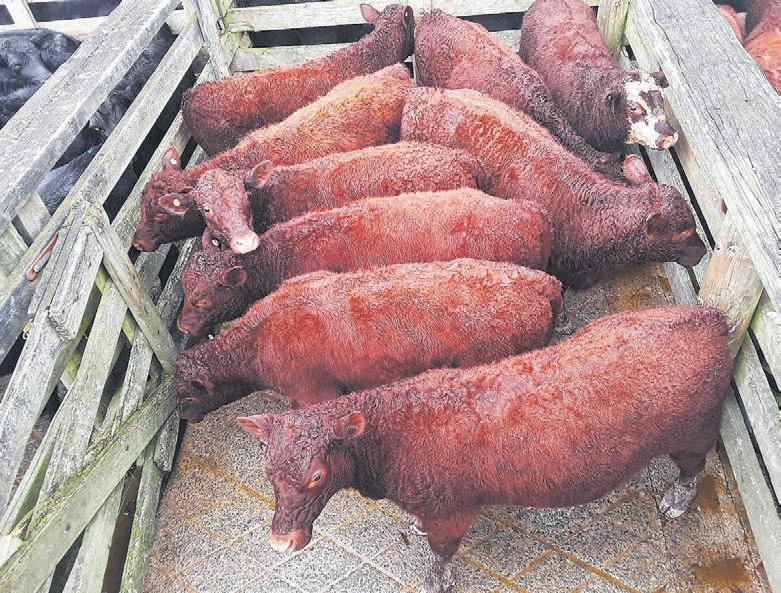









For high quality and convenience you can trust, talk to your vet clinic about Boehringer Ingelheim cattle products to keep your stock at their best and we’ll add these DeWalt cordless tools to your tool box. For more information talk to your vet or visit: futureproducers.co.nz PROUDLY AVAILABLE FROM YOUR LOCAL PARTICIPATING VETERINARY CLINIC. ECLIPSE® and MATRIX® are registered trademarks of Boehringer Ingelheim Vetmedica GmbH, used under license. ACVM Registration Nos. A0101131, A009270, A011151 © Copyright 2024 Boehringer Ingelheim Animal Health New Zealand Limited. All rights reserved. NZ-BOV-0051-2023. FREE * DeWalt 18V XR Brushless Circular Saw, 18V XR Impact Driver or a LED Worklight Torch with qualifying cattle products. *Batteries & charger are not included. Promo ends 30th April 2024. Ask in clinic for qualifying products. GET MORE DONE 9 FARMERS WEEKLY – farmersweekly.co.nz – April 22, 2024 News 9
ANOTHER GO: Weaner Red Devon-cross cattle are penned up ready for auction at the Wellsford supplementary weaner steer & bull fair.
Professional bar may be set for agricultural advisers

Richard Rennie NEWS Agriculture
RURAL professionals may soon have an industry standard to work towards that carries an accreditation, assuring farmers and fellow professionals they meet set requirements for advice and knowledge.
The New Zealand Institute of Primary Industry Management (NZIPIM) has just completed a road show seeking feedback from members about what sort of programme and its content could best meet industry needs and farmer expectations.
NZIPIM CEO Jo Finer said the proposal will see rural professionals have a body with similar stature to the Law Society for lawyers, or engineers’ Engineering NZ body.
She said interest has been greater than initially expected, with a broad range of high calibre,
senior industry people expressing support for the scheme.
“It is not so much that we have a problem now, but this is an effort to raise the kudos and status of professionals who support the primary sector. It allows them to sit alongside the likes of engineers and accountants.”
This is an effort to raise the kudos and status of professionals who support the primary sector.
Jo Finer NZ Institute of Primary Industry Management
Usually, such bodies include a complaints process and disciplinary procedures, but Finer said NZIPIM already has a complaints process in place.
“It is just that most do not know that it is there, and that we have professional standards for them to base a complaint upon.”

She said the institute has enjoyed a positive informal response from the government, which is keen not to foist more regulations on the primary sector.
“There’s been strong support for the proposed programme, with everyone broadly agreeing that there’s value in developing an integrated programme to accredit primary industry professionals to support, develop and deliver the future of farming.”
She acknowledged farm professionals are working in a complex environment today. Bankers, for example, are required to understand their clients’ environmental standards and emissions levels.
“Having someone sign up to a standard that agrees on an integrated approach is valuable. Farm consultants used to be generalists, now they need services of various experts, and having an accreditation provides assurance about the quality of the advice being engaged.”

She said the Master Builders voluntary accreditation programme is a good template for the type of programme rural professionals may sign on to.
POSITIVE: NZIPIM CEO Jo Finer says the institute has had a positive informal response from the government on its proposal.
Finer said the next step is to prepare a full business case for board sign-off. She fully expects it will take several years to develop but is encouraged by the wide crosssector support the proposal has received so far.
Foresta moves on forest contract

Richard Rennie TECHNOLOGY
Forestry
BAY of Plenty forestry tech company Foresta has secured a 150,000 tonnes a year contract with forestry company PF Olsen to cut stumps, logs and slash for the production of resin chemicals and wood fuel pellets.
The agreement comes only a week after Australian-listed Foresta announced its plans to build a forest chemical and wood pelletising plant on iwi land at Kawerau, with full production due to commence in two years.
The 10-year supply agreement with PF Olsen has Foresta overseeing the entire forest
felling process amounting to about 300 hectares a year of pine forest, largely in the vicinity of its Kawerau plant.
Foresta managing director Ray Mountfort said the chemical extraction process Foresta will use generates greater value from higher resin components of the trees harvested, particularly the stumps.
He emphasised the company is not seeking to be a “clean-up” operation, picking up residual slash and waste from other companies’ harvesting sites.
“Our aim is to add value through the entire harvest chain.”
He is awaiting the arrival of a wood pelletising plant from
Europe this spring, while the chemical extraction plant will take over a year to construct once resource consent has been approved.
The higher value of the extracted chemicals, which can be replacements for conventional hydrocarbon sourced chemicals across a range of industrial uses, means Foresta has some flexibility about distance to the processing plant, he said.
For that reason, the company is also keen to talk to more farmers who may have smaller wood lots with older pine trees within them.
“Those old man pine trees you get on farms tend to have a higher resin content within them,
making them more valuable to us.”
The torrefied black wood pellets represent a “drop in” fuel that can be a straight swap for coal in industrial boilers, reducing emissions by 90%.
Foresta has also secured an offtake agreement with South Island based energy supplier Tailored Energy and Resources, to supply 65,000 tonnes of pellets annually to industrial customers.
“The supply agreement represents another piece in the jigsaw which means, pending funding, we can proceed with confidence with our plans to develop our manufacturing plant and begin construction later this year.”




You can find out more about it here: www.agrihq.co.nz/thefarmersvoice To join in with The Farmer’s Voice go to: www.bit.ly/agrihq-tvc The Farmer’s Voice is a new community for New Zealand farmers to share their ideas about what it is like to be a farmer today. We’d like you to tell us what is important to you as a farmer. We’ll share what farmers have to say with everyone who takes part and we’ll let industry and government decision-makers know what is important to farmers. It is FREE to join in and you could win one of three $500 Prezzy Cards just for taking part. Join the conversation, have your say... 10 FARMERS WEEKLY – farmersweekly.co.nz – April 22, 2024 News 10
PLANTED: Foresta managing director Ray Mountfort says securing the PF Olsen forest supply helps underpin the company’s plans for a steady supply of wood fuel pellets.
Velvetleaf found at two sites in Waikato
 Gerald Piddock NEWS Pests
Gerald Piddock NEWS Pests
VELVETLEAF has been rediscovered in Waikato after the invasive weed was found on two new properties for the first time in five years.
The first new detections of the highly invasive pest plant in the region since 2019 were made in a commercial maize block in wider Matamata and a maize paddock near Otorohanga.
“There is a significant amount of work that has gone into controlling velvetleaf in this region since it was first discovered in 2011, so it is extremely disappointing to have these two new outbreaks,” Waikato Regional Council biosecurity pest plants team leader Darion Embling said.
It is unclear how velvetleaf had spread to these two properties. However, tracing has historically identified machinery and infested maize silage as the most common vectors, he said. He said it demonstrates the need for continued vigilance by farmers and growers, as well as rigorous machinery hygiene protocols by the cropping sector.
Our focus is on tracing machinery and crop movement, critical to ensuring the risk of spread is effectively managed.
Darion Embling Waikato Regional Council
“Our focus is on tracing machinery and crop movement, which is critical to ensuring the risk of spread beyond these properties is effectively managed.”
He said they are working closely with the owners/managers on the affected properties to develop biosecurity farm management plans.
“We are also liaising with the cropping industry, in particular, with a reminder around the ongoing risk of velvetleaf in the Waikato region and the importance of good hygiene practices.
“The discovery of velvetleaf on a property can significantly impact farming businesses, as paddocks are unable to be cropped for some time. So we are doing what we can to support these landowners,” Embling said.
Velvetleaf was first discovered in the region in 2011, but the scale of finds escalated in 2016 with the arrival of infested fodder beet seeds imported from overseas.
The majority of the infested properties are in the north Waikato, Matamata-Piako and south Waikato districts.
Pest plant officers have been working with landowners/managers to develop biosecurity farm management plans to manage the risk of spread on 60 properties. Velvetleaf is one of the world’s most invasive pest plants, damaging crops by competing with them for nutrients, space and water. In New Zealand, it is an unwanted organism under the Biosecurity Act.
It is an annual broad-leaved herb that grows between 1 and 2.5 metres tall. It has buttery-yellow flowers about 3cm across. It flowers from spring through autumn.
The leaves are large, heart-shaped and velvety to the touch.
A mature plant can have as many 15,000 viable seeds.
Seedlings are vigorous and the plant grows rapidly in the first few months after germination. Seeds remain viable for up to 60 years.
The seeds are spread by water, farm machinery when harvesting grain, through livestock and as a contaminant of grain.


PROLIFIC: A blackened velvetleaf seedhead. A mature plant can have as many 15,000 viable seeds, which remain viable for up to 60 years.
























PROUDLY AVAILABLE FROM YOUR LOCAL PARTICIPATING VETERINARY CLINIC See product label for full claim details and directions for use. MATRIX is a registered trademark of Boehringer Ingelheim Vetmedica GmbH, used under license. ACVM Registration No. A009390. © Copyright 2024 Boehringer Ingelheim Animal Health New Zealand Limited. All rights reserved. NZ-OVI-0001-2024. For more information, talk to your vet or visit: futureproducers.co.nz Buy two MATRIX® Hi-Mineral 20 Litres and receive a FREE* NJ Phillips 20 mL Metal Oral Drench Applicator. *Promo 1st April - 31st May 2024. While stocks last. Delivering quality time and again 11 FARMERS WEEKLY – farmersweekly.co.nz – April 22, 2024 News 11

Farming brothers’ passing brings unique opportunity


sale in several titles in late April and early May.
Known as the Webb family farm at Ngahau Bay, the total of 660 hectares has pristine beach frontage, conservation covenants, grazing blocks, farm forestry, regenerating native cover and four titles on the largest block of 480ha.

The whole property was farmed for most of their lives by three Webb bachelor brothers, Neville and twins Brian and Peter, until they died within months of each other last year.
Their parents, Aileen and Jack, had bought the property more than a century ago and had the three sons and four daughters.
Two younger generations of the family have since enjoyed holidaying at Ngahau Bay, with a 1980s bach on 5ha including mature beachfront pohutukawa.
That part of the estate is bordered by the Mimiwhangata nature reserve on the south side and Helena Bay resort to the north.
In 1970 Queen Elizabeth, aboard the yacht Britannia, visited the coast and picnicked ashore at Mimiwhangata, run as a farm by the Department of Conservation.
More recently Russian oligarch Alexander Abramov built a $50 million lodge and resort on 325ha at Helena Bay, which opened for guests in 2016.
Agent Lin Norris of Bayleys Whangarei said the Webb family had fiercely pushed back on multiple offers to purchase the property over the years.
“It is unlikely any purchaser would be likely to want to move on, once they have secured such a spot.”
The 5ha coastal holiday property and a nearby 73ha title with development opportunities will be auctioned on May 1. An additional 101ha block for auction also offers similar opportunities for building and is currently run as a grazing block.
Of the entire property further inland, the largest block of 480ha comprises four titles that offer a range of recreational and development opportunities.
Those four titles are subject to tender offers by April 30.

“One of these blocks, consisting of 102ha, has the original Webb family homestead upon it, still in remarkably good order but needing some love and repair work,” Norris said.
“Built from timber felled on the property, the home includes four bedrooms and features the characters of a typical 1920s bungalow design.

“Other buildings on the title include some near-new cattle yards and a disused walkthrough cow shed, while water is sourced from a stony bottom stream and supplied via pumps to a new 25,000 litre storage tank.”
Much of the property has reverted to scrub and mānuka that provides income through beehives and the potential to regenerate native bush and generate carbon credits.

TRIBUTE: A permanent reminder of the Webb family’s ownership of Ngahau Bay, Northland.
For high quality and convenience you can trust, talk to your vet clinic about Boehringer Ingelheim cattle products to keep your stock at their best and we’ll add these DeWalt cordless tools to your tool box For more information talk to your vet or visit: futureproducers.co.nz PROUDLY AVAILABLE FROM YOUR LOCAL PARTICIPATING VETERINARY CLINIC ECLIPSE and MATRIX are registered trademarks of Boehringer Ingelheim Vetmedica GmbH, used under license ACVM Registration Nos. A0101131, A009270 A011151 © Copyright 2024 Boehringer Ingelheim Animal Health New Zealand Limited. All rights reserved. NZ-BOV-0051-2023 F R E E * DeWalt 18V XR Brushless Circular Saw, 18V XR Impact Driver or a LED Worklight Torch with qualifying cattle products. *Batteries & charger are not included. Promo ends 30th April 2024. Ask in clinic for qualifying products. GET MORE DONE 12 FARMERS WEEKLY – farmersweekly.co.nz – April 22, 2024 News 12 ACHIEVEMENT: Two of the Webb brothers and their farm sta members after a lengthy land clearance.
A N EXTRAORDINARY coastal Northland
in a deceased estate an hour northeast of Whangārei is being offered for
property
Hugh Stringleman NEWS Land
Threats and opportunities as US flexes trade muscle


THE threat of United States financial sanctions against China has brought New Zealand a step closer to having to choose which of the competing global superpowers it will continue to do business with.
Two years ago in this newspaper Rabobank global strategist Michael Every warned of the possibility of financial sanctions should China back the Russian war machine in Ukraine.
Every said the US had been incensed by China’s refusal to condemn the invasion and was readying sanctions should Beijing step up its support for its Russian ally.
In December, US President Joe Biden took the next step when he gave the US Treasury the power to bar any banks, from any country, from the US financial system should they be found to have played a role in the Russian war effort.
Returning from Beijing last week, Biden’s Treasury Secretary Janet Yellen singled out Chinese banks specifically.
“Anything that involves aiding Russia’s military in their brutal war against Ukraine is unacceptable to us and we have the ability to sanction it,” she said.
NZ exporters have some recent experience of the chilling effect financial sanctions can have on trade with countries that find themselves in the crosshairs of the US Treasury.
The meat industry’s attempts in 2018 to resurrect trade with Iran were blocked by the reluctance of the Australian-owned banks to repatriate export receipts because of the threat of US sanctions.
They feared enormous fines or losing their ability to tap money markets in New York if they were found to have transferred funds from entities or individuals either blacklisted by the US Treasury or linked to somebody that was.
Given their reliance on offshore money to fund their mortgage books in NZ, facilitating the meat trade with Iran was simply too big a risk for the Aussie banks and they refused to transfer funds for their meat exporting clients.
(Financial middlemen from the Gulf states have handled receipts from the dairy trade with Iran but the service isn’t cheap and is likely to come under more scrutiny from the US as a sanctions loophole.)
And while it played up the moral dimensions of its decision, at least one top-flight lawyer with sanctions experience believed Western sanctions were at the forefront of Fonterra’s thinking when it dumped its Russian customers in the weeks following the Ukraine invasion.

The small amount of trade with Iran and Russia meant the economic damage was inconsequential for NZ exporters when those markets were closed off to them.
The same cannot be said for China, NZ’s single largest export market.
There is a growing rift in world trade, where countries are increasingly trading more with those whose geopolitical and strategic interests align.
Just what would be the reaction of the Australian-owned banks if Chinese counterparties through whom export receipts were repatriated to NZ were found by the US Treasury also to have banked Chinese companies that supplied materials to the Russian war machine and were suddenly blacklisted?
How easy would it be to find a Chinese bank untainted by links to
blacklisted individuals or entities?
How much would that cost and would trade still be economically viable for exporters?
Reassuringly for NZ exporters, the Economist magazine recently noted it would be a major step for the US to fully enforce its Russia sanctions when countries representing 80% of the globe’s population, and 40% of its GDP, continue to trade freely with Russia and ignore the threat hanging over them from the US. To force compliance would risk driving countries to abandon the US-led financial system, the magazine wrote.
Still, even if the US doesn’t follow through on its threats there is mounting evidence of a growing rift in world trade, where countries are increasingly trading more with those whose geopolitical and strategic interests align.
The World Trade Organisation recently analysed the trading patterns of countries according to their votes at the United Nations since the Ukraine invasion.
It found trade between countries
that voted the same way has grown 4% faster than trade between countries that voted against each other.
Some trade observers fret that by strengthening ties with the US through new defence arrangements such as AUKUS, the National-led government risks a backlash from China that could harm our export industries.
But could the jockeying between the global superpowers have a pay-off for NZ exporters? Certainly Australia, as one of AUKUS’s foundation members, has seen its relationship with China thaw significantly in recent months with tariffs on barley and wine exports finally dropped.
What trade concessions might China offer NZ to back its bid to join the Comprehensive and Progressive Agreement for Trans-Pacific Partnership trade agreement?
Could Washington’s eagerness to draw NZ further into its orbit give NZ the leverage it needs to push for a long-awaited free trade deal with the US?
Fonterra Dairy Woman of the Year finalists named
FOUR finalists have been announced for this year’s Fonterra Dairy Woman of the Year award. They are Myfanwy Alexander, Amber Carpenter, Michelle Ruddell and Katrina Roberts.
The award recognises an outstanding woman who has contributed to the dairy sector with passion, drive, innovation and leadership.
The recipient of the Fonterra Dairy Woman of the Year award will receive a scholarship to be part of the Kellogg Rural Leadership Programme. The scholarship covers the programme fee, travel, and accommodation, mentoring and access to Dairy Women’s Network (DWN) and Fonterra platforms to share research.
Myfanwy Alexander is originally from Wales, and came to New Zealand to intern on a dairy farm, 18 years ago, during university and fell in love with the country. For the past decade she has been
contract milking in the Waitaki Valley on a 280ha, 920-cow farm. Well-known in the North Otago community and dairy sector, Alexander is the DWN Regional Leader in North Otago, president of the North Otago Federated Farmers and sits on the South Island Dairy Event governance group.
Amber Carpenter may have grown up a “city girl” in Bucklands Beach, Auckland, but she is right at home in gumboots on the farm sharemilking 450 cows on a Paparimu dairy farm, with a separated beef block.
She is Chair of DairyNZ’s Dairy Environment Leaders, an ambassador for FarmStrong, has held leadership roles within the New Zealand Dairy Industry Awards, completed the Kellogg Rural Leadership Programme, is completing a Diploma in Agribusiness and is in the Agri Women’s Development Trust Escalator programme.
Katrina Roberts is a herd health veterinarian and farm consultant, and has a passion for people and
dairy animal health. She is actively involved in the dairy sector at grassroots and higher industry levels and has been instrumental in helping Waikato farmers improve their farms, businesses and achieve their goals.
Roberts is a mentor of young vets and active with DairyNZ as an InCalf Trainer and member of several steering groups. For the past 20 years she has volunteered with Cambridge Riding for the Disabled and is an active member of the Walton School Board of Trustees, netball coaching, and Matamata Pony Club.
Michelle Ruddell (Ngati Tūwharetoa) runs a large-scale dairy farm near Whangarei and chairs the Northland Rural Support Trust. She has a strong history of working in leadership roles in regional and national organisations and was instrumental in the Northland dairy sector’s recovery after Cyclone Gabrielle, providing hands-on support for those affected, fronting media interviews, and facilitating

responses between various agencies.
DWN trustee Donna Smit said this year’s awards attracted a large number of high calibre entries.
13 FARMERS WEEKLY – farmersweekly.co.nz – April 22, 2024 News 13
SANCTIONS: The US Treasury has been empowered to bar any banks, from any country, from the US nancial system should they be found to have played a role in the Russian war e ort.
Nigel Stirling ANALYSIS Trade
The winner will be announced on Thursday May 2 at a dinner during the DWN 2024 Enhance, Elevate, Evolve conference in New Plymouth.
Staff reporter PEOPLE Awards
TOP FOUR: The Fonterra Dairy Women of the Year nalists are, clockwise from the top, Myfanwy Alexander, Amber Carpenter, Katrina Roberts and Michelle Ruddell.
Record in-calf rates for dairy farmers
 Gerald Piddock NEWS Livestock
Gerald Piddock NEWS Livestock
NEW Zealand dairy farmers have achieved the highest six-week in-calf rate and lowest not-in-calf rate on record, according to data from LIC and DairyNZ.
The average six-week in-calf rate is sitting at 69.3% for the 2023-24 season, up 2.7% from last season (66.6%), and the not-in-calf rate is down to 15% from 16.7%.
The conception rate – the proportion of inseminations that resulted in pregnancy – was up from 50.9% to 53.1%.
The interim data, based on aged pregnancy test results from 4679 herds with a detailed DairyNZ fertility focus report in LIC’s MINDA software, represents 2.5 million cows from across New Zealand.
On a national scale, the DairyNZ InCalf calculator estimates these reproduction improvements could create $130.7 million in extra milk revenue.
DairyNZ senior scientist Chris Burke said improved reproduction performance could also help farmers lower emissions.
“Herd reproductive performance is key in ensuring dairy farming success and in lowering methane
emissions by reducing the number of non-productive cows.
“These results highlight the ongoing sector-wide opportunities to help farmers improve animal efficiency, to continue working towards emissions reduction goals.”
Burke said the challenge for dairy farmers is to maintain this good performance.
“To lock in these gains, farmers should focus on hitting condition score targets at calving and on planning their spring feeding carefully.”
LIC senior reproduction solutions adviser Jair Mandriaza said it is great news for the dairy sector after a couple of tough seasons.
Submission rates (the number of cows that were mated in the first three weeks) also increased compared to last season from 79.3-80.8%
“It seems many farmers have implemented improved management practices to overcome those tough seasons and, coupled with favourable weather in many parts of the country, are now reaping the rewards of their hard work.”
Mandriaza said the improvement in rates was not down to just one factor and there was little difference in body condition score compared to the previous season.

It seems many farmers have implemented improved management practices to overcome those tough seasons.
Jair Mandriaza LIC
“What I think has come through is that farmers in the last couple of seasons have had it pretty tough and we have had some
pretty challenging times, and I think farmers have created some good management strategies. All of these changes are coming to fruition.”
That, combined with the high level of feed availability, meant the cows were in peak condition for mating. The results included sexed semen mating and the semen quality issues LIC had in October last year.
Fonterra’s group director for farm source, Anne Douglas, said the results are particularly encouraging.
UP: The average six week in-calf rate has lifted from 66.6% to 69.3% for the 2023-24 season.
“Animal efficiency can improve farm profitability as well as positively impact a farm’s emissions intensity profile, which is important for our co-op.
“We provide a number of tools and services aimed at supporting farmers, including our tailored Farm Insights Reports, and we also really appreciate the work that LIC and DairyNZ are doing in this space. By working collectively alongside Kiwi farmers we can help them continue to lead the way in sustainable, efficient dairy farming.”
Fonterra closes plants at two Waikato sites

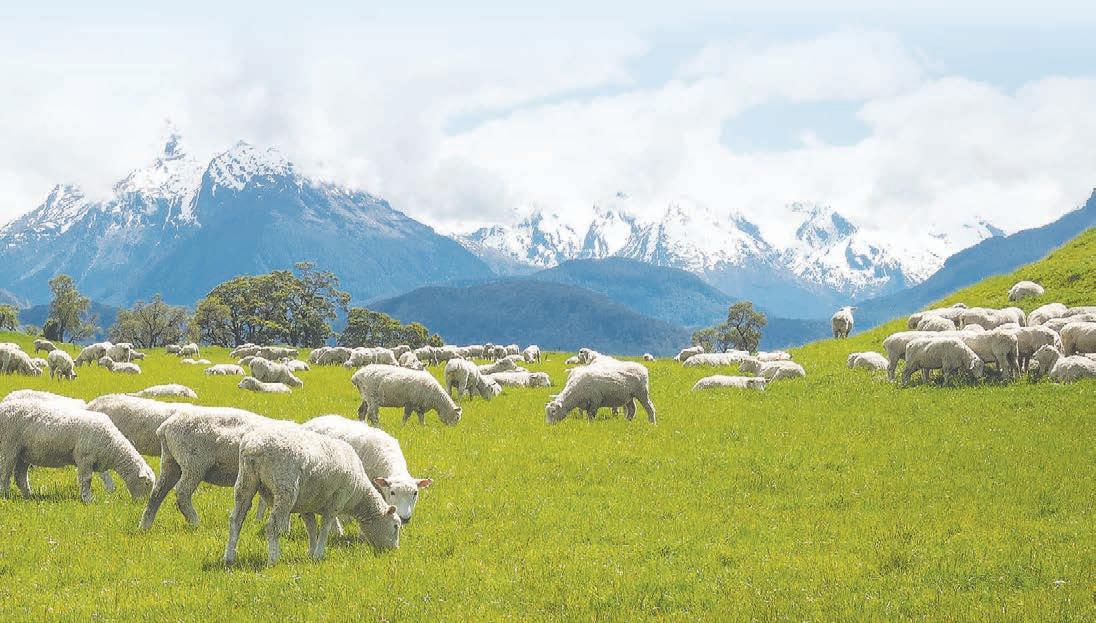 Piddock
Piddock
FONTERRA has announced it will close some of its plants at its Te Rapa and Waitoa sites in Waikato.
Pahiatua we are gearing up to produce more caramelised milk powder for growing future demand. Our priority right now is supporting our teams through this change.” Asked if the closure decision was connected to Fonterra’s Scope 1 and 2 targets, he said:






Its Waitoa PDC (specialty powders) and the site’s coal centre, along with Dryer 1 and 2 at Te Rapa, will close as the co-operative looks to optimise its operations, Fonterra director NZ manufacturing Alan van der Nagel said.
He said that while these plants have served Fonterra well, they are ageing assets and are no longer efficient to operate.
“For these reasons, we have let our teams know of plans to close these plants. Our Waitoa and Te Rapa manufacturing sites will continue to operate.”
At Waitoa, the impacted operations will discontinue near the end of the year, affecting 41 jobs, he said.
“Our decision to close these assets is driven by the need to adapt to changing market demands and pursue our longterm strategic goals, along with the assets being inefficient to run. While not the primary driver of the decision, the closure of the specialty powders plant at Waitoa does mean we will be able to operate the remaining assets on site with the new biomass boiler, which completes our strategy to exit coal in the North Island.”





“We are working with the team on redeployment opportunities within the co-op. We will continue to operate our specialty nutrition dryer and UHT plants at Waitoa.”
At Te Rapa the two impacted dryers will discontinue operations in May and there are sufficient vacancies on site to redeploy the small number of roles that will be affected.
The two dryers at Te Rapa are close to 60 years old while the Waitoa plant is close to 40 years old.
Van der Nagel said the changes allow the co-op to ensure its resources are geared towards high value products.
“For example, we are increasing production capacity at Hautapu to meet growing demand for lactoferrin and at

2 TRO4235 ZAPP PROMO 24 [190h x 129w] $30 indd 1 8/4/2024 4:10 pm 14 FARMERS WEEKLY – farmersweekly.co.nz – April 22, 2024 News 14
Gerald
NEWS Dairy
DISCONTINUED: Fonterra’s PDC (specialty powders) and the coal centre at its Waitoa site are to close later this year.

MPI tracking avian influenza closely
The Ministry for Primary Industries (MPI) is closely following developments in the spread of high pathogenicity avian in uenza (HPAI) overseas, including the detection of the H5N1 strain in cattle in the United States.
“New Zealand has never had a case of high pathogenicity avian in uenza (HPAI) and we have systems in place to prevent HPAI entering New Zealand on the pathways that can be managed, and to ensure early detection if it does arrive. This detection of HPAI in cattle in the US does not change that,” says MPI’s
Tackling facial eczema
A $20 million collaboration between Beef + Lamb NZ, the Government through the Ministry for Primary Industries (MPI), and primary sector partners is aiming to help eliminate the signi cant impacts that facial eczema have on pastoral animals.
It recognises the severe impact facial eczema can have on farm productivity, pro tability, and animal health, and marks a signi cant step forward in helping farmers manage a disease that has been impacting their herds for decades.
It costs New Zealand’s farmers an estimated $332m a year and at present there is no cure.
By bringing together top researchers and building on existing research, the programme will support multiple approaches to tackling this disease.
Work is building towards developing prevention solutions such as early detection, mitigation, and management options for farmers. Decision support tools will also be developed.
The collaboration was announced by Agriculture Minister Todd McClay and Beef + Lamb New Zealand board chair Kate Acland at Central Districts Field Days.
These solutions will complement the facial eczema breeding value for dairy cows recently announced by the Livestock Improvement Corporation (LIC), as part of the $25 million Resilient Dairy Programme – a Sustainable Food and Fibre Futures Fund partnership involving LIC, DairyNZ and MPI.
Chief Veterinary O cer Dr Mary van Andel.
“Information from the American Veterinary Medical Association (AVMA) is that most cattle recover in two to three weeks with supportive care, and there have been no con rmed deaths associated with HPAI in dairy cattle.
“The USDA isn’t issuing quarantine or movement restriction orders yet, but recommends minimising cattle movements as much as possible, and to not move sick or HPAI exposed animals,” says Dr van Andel.
“We will continue to work with international colleagues to learn
everything we can from their experiences. We are keeping a close eye on both the United States Department of Agriculture (USDA) and the Centres for Disease Control and Prevention (CDC) for any new developments with this disease and areas that it has spread to, as well as regular contact with the US Chief Veterinary O cer.”
There are no food safety implications for New Zealand from the current reported outbreak in US dairy herds. Pasteurised milk is safe to drink as pasteurisation kills viruses and other bacteria. The USDA has advised against drinking raw milk.
Dr van Andel says the cases in the US are a good reminder for farmers to be proactive with on-farm biosecurity measures. Early reporting of any suspicions of HPAI is also important.
If farmers, or general members of the public see sick or dying wild birds, they should report the nding to Biosecurity New Zealand‘s Exotic Pest and Disease hotline on 0800 80 99 66.
MPI, the Department of Conservation and the Ministry of Health, along with industry partners are working closely together to ensure New Zealand is ready should HPAI be detected here. MPI’s

Champions celebrated at New Zealand Biosecurity Awards
New Zealand’s biosecurity champions have been recognised for their work protecting the country from damaging pests and diseases, with e orts to help eradicate Mycoplasma bovis among the award winners.
The Biosecurity New Zealand Awards, held earlier this month in Wellington, acknowledge the hard work of people protecting our vital $57.4 billion primary sector.
The supreme award went to two Northlanders, Arana Rewha and Viki Heta (Ngā Hāpu o Te Rāwhiti and Ngāti Kuta rāua Ko Patukeha), for their work with the local community in ghting the spread of the exotic Caulerpa seaweed.
The pair have also championed other biosecurity e orts in Northland.
The GIA Industry Award went to VeritAg, for bringing the private sector into the M. bovis Eradication Programme.
VeritAg and its collaborating partner SVS Labs facilitated the deployment of 220 veterinary practices to support Biosecurity New Zealand’s M. bovis Programme – signi cantly boosting testing capacity and helping to lessen the impact of M. bovis on New Zealand farmers by reducing the time farms spent under restrictions.
Biosecurity New Zealand deputy director-general Stuart Anderson says all those nominated for this year’s Biosecurity Awards represent a high calibre of New Zealanders who are leading e orts to protect our way of life and our unique environment for future generations.
“Their work is preserving and restoring New Zealand’s landscapes, empowering local community groups, fostering innovation, improving pest management practices, and boosting awareness and understanding of biosecurity throughout New Zealand.”
Other category winners included Dr Brian Richardson of Scion who received the Minister’s Biosecurity Award, and Keeley Grantham of Te Arawa Lakes Trust

who was recognised with the AsureQuality Emerging Leaders Award for her work to expand the Cat sh Killa programme in Bay of Plenty.
• A full list of winners can be found at www.thisisus.nz/news-events/ biosecurity-awards/
AWARD WINNERS
Supreme Award & Te Uru Kahika Māori Award
• Viki Heta and Arana Rewha, Ngā Hāpu o Te Rāwhiti, Ngāti Kuta rāua
Ko Patukeha - R.E.P. NZ
For their work to protect their rohe in the Bay of Islands. They have led the community response to the discovery of the seaweed caulerpa, worked towards the eradication of Sika deer in their area, and helped reintroduce native birds in o shore islands.
BioHeritage Challenge Community Award
• Ōkārito GorseBusters Charitable Trust
The community-led trust is protecting the habitat of Ōkārito Lagoon, our largest unmodi ed coastal wetland and a UNESCO World Heritage site, to preserve and restore bird nesting and whitebait spawning under threat from gorse invasion.
Eagle Technology Local/Central Government Award
• Waikato Regional Council – Kauri Protection Programme team
For its work in advocating for the ecologically unique southern kauri, and using science, research, and education to inspire landowners, community groups, iwi, and schools to invest in a future that includes healthy kauri forests.
GIA Industry Award
• VeritAg
The work by VeritAg and its partner SVS Labs to support the M. bovis Eradication Programme has signi cantly boosted testing capacity and helped reduce the impact on farmers by cutting the time farms spend under restrictions.
Kura (School) Award
• Maeroa Intermediate
Involving students, whānau and the community, the Gully Restoration Programme is an inspiring outdoor classroom project transforming a plot of school land through the clearing of pest plants, the planting of native trees, the growing of thousands of seedlings, and creation of a lizard habitat.
Mondiale VGL Innovation Award
• EcoNet Charitable Trust
Its EcoNet CAMS Weeds toolkit
provides a suite of tools to help foster collaboration, innovation and improved pest management practices for conservation volunteers, neighbourhood groups, iwi and communities.
Science Award
• Cawthron Institute
Its Marine Biosecurity Toolbox Research Programme has transformed the detection and elimination of invasive marine pests through molecular surveillance technology and analytical platforms.
AsureQuality Emerging Leader Award
• Keeley Grantham
For her work in expanding the Te Arawa Lakes Trust Cat sh Killa programme into almost 40 Bay of Plenty schools – enabling the next generation of biosecurity champions to look after our environment.
Minister’s Biosecurity Award
• Dr Brian Richardson – Scion
An internationally recognised expert in forest vegetation management who has been recognised for his signi cant contributions to New Zealand’s biosecurity responses, weed science, and research into aerial pesticide applications while working to champion forest protection for almost 40 years.
www.mpi.govt.nz ADVERTISEMENT
chief veterinary o cer, Dr Mary van Andel.
15
Leanne Stewart (left), representing the GIA, with award winners Richard Campbell and Cynthia Northcote.

From the Editor
The show must go on

AVISIT to a local A & P show during the hot summer months is a rite of passage for New Zealand children.
Candy floss is a must, as is a tomato sauce-slathered hot dog while you join the lengthy queues for the merry-go-round or dodgem cars. For the townies, it is a chance to get up close and personal with sheep, cattle and horses – to smell what rural living is all about.
News that Christchurch’s New Zealand Agricultural Show will be postponed this year will have come as a shock to many. On the plus side, livestock judging and competitions will still be held, but it won’t be the show many people are used to.
The three-day event is considered the créme de la créme of A & P shows in this country. From humble beginnings in 1863, it has morphed into a show stopper, with hundreds of exhibitors and more than
100,000 visitors attending each year.
But with size come increased costs and demands, and those tasked with organising the event are well aware of the rising financial risk hosting such an event now carries.
Increased competition for sponsorship dollars and a rise in the cost of living raises questions over how well the event will be supported by spectators and exhibitors. There are also increased wages and rising compliance costs to take into account, all eating into the bottom line.
From an exhibitor perspective, there are now more options to display their wares through the various field days and events such as Agfest. The marketing dollar can only stretch so far.
New Zealand Agricultural Show Board chair Stewart Mitchell says the decision to postpone is disappointing, but after several challenging years it is an opportunity to rethink the event’s strategic direction.
“The association’s ongoing business model is under review to reflect the environment we now operate in, a challenge common to most businesses throughout New Zealand currently,” he says.
“Twelve months of costs and three days of revenue is not a great business model by anyone’s analysis.”
Like most events in this country – and around the world – the show’s momentum was impacted by covid in 2020 and 2021 and it has struggled to regain that lost ground.
That prompted a review of the show’s governance model, which should be completed this year.
But organisers can take heart from what is happening in Britain. The Guardian newspaper reported last year that agricultural shows were booming and record numbers of people were flocking to them, despite a growing number of farmers leaving the industry.
The Association of Show and Agricultural Organisations estimates about 7 million Brits visit agricultural shows every year. It is thought YouTube farming videos and shows such as Clarkson’s Farm have sparked new interest in the sector.
People see agricultural shows as a way to get their rural fix.
What is happening in Britain shows A & P shows are far from a thing of the past, even if – depending on the review outcome – we may have seen the last of the New Zealand Agricultural Show in its current format.
Perhaps a scaled-back, farm-focused event could be the future. When it comes A & P shows, maybe bigger isn’t necessarily better.
Letters of the week
Farming for life
Andrew Luddington Lincoln
I LOVE reading Alan Emerson’s Alternative view, but feel that Farmers Weekly could publish a counterview for balance. In fact, ever since Alan told us that freshwater allowed to go out to sea was a “criminal waste” or “eco sanctuaries are a fad”, the newspaper has been missing a trick. It needs an opposite page to counter him. So I would like to respond to his latest, “I do wish they’d dry up about wetlands” (April 1).
I used to farm on the edge of the Fens in the United Kingdom and rented some land within. The Fens were some 185,000 hectares of wetland between Cambridgeshire, Norfolk and Lincolnshire. The soil type is predominantly peat.
The Earl of Bedfordshire, through a highly skilled Dutch engineer, had it drained for farming. Whilst the newly formed breadbasket of the UK was particularly important in feeding the country and especially so during the wars, the operation took a unique and massive ecosystem and turned it inside out.
Peat, when exposed through drainage and cultivation, will shrink, with the result that most of the fen is now well below sea level. Frightening for those who live there in these times of climate change and sea level rise. You step up to a river in the fen. Drained peat also releases vast amounts of methane. The Fen Tigers, the farmers who live there now, have to pay a considerable fee to pump the water out to sea and so the shrinkage continues and the fees only go up.
Peat is also subject to erosion through windblow and, when caught out in a dry summer, is reasonably flammable. A stubble burn will set it on fire and the land can burn for months. It is also highly trace-element demanding and contains petrified oak trees and well-preserved Viking ships, which tend to ruin machinery. Not actually that easy to farm then. But when the Earl drained it, he didn’t know these things.
Happily, there is an area he did not drain. Its called Wicken Fen and is to be found near Newmarket. It is an eco-sanctuary that Alan would sadly and wrongly call “a fad”. It contains some 9000 species, the highest

16 Editorial
Best letter WINS a quality hiking knife Send your letter to the Editor at Farmers Weekly P.0. Box 529, Feilding or email us at farmers.weekly@agrihq.co.nz FARMERS WEEKLY – farmersweekly.co.nz – April 22, 2024 Opinion 16
farmersweekly.co.nz/premium Get the news delivered daily to your email inbox. TODAY Subscribe to Farmers Weekly Continued next page Craig Page Deputy editor Those tasked with organising the event are well aware of the rising financial risk hosting such an event now carries.
In my view ...
Dairy herd nutrition has to evolve
crucial icing on the cake.
IN THE coming years, the New Zealand dairy industry will face growing pressure to evolve its approach to herd nutrition.
While our pasture-based systems are the foundation of our international competitive advantage, there is a growing realisation that pasture may not be the whole story to enable farmers to meet immediate and future challenges.
We are all well versed in what those challenges are. Environmental obligations that require us to produce more with less while we tread as lightly as possible on our land and reduce emissions. Changing consumer preferences that demand the industry display its social licence, and squeezed margins and rising costs as we navigate the waves of commodity markets.
While NZ has rightly long prided itself on its pasturebased systems, this evolving landscape requires a subtle shift in mindset. We need a mindset that embraces innovation and explores alternative feed strategies tailored to meet the changing needs of our national herd and the challenges ahead.
Pasture will always be king and our industry’s key ingredient, but strategically supplementing our herds’ nutrition to maximise their genetic potential will be the
Letters of the week
Continued from previous page diversity of life in any part of the UK. I repeat, the highest diversity of life in any part of the UK. Some of its native birds, such as the bittern and hen harrier, live there and only there. A little bit of foresight that over in this country saw the protection of Riccarton Bush in Christchurch or many other wetland sanctuaries.
I don’t think that many could argue that we are now in an anthropomorphic mass extinction event. To put that into English, we are destroying the world’s diversity of life for the benefit of just one species and this practice is only going to come with severe or catastrophic consequences.
So no, Alan, I do not agree with you when you say “farmers do not deserve all the pressure from local government to develop or restore wetlands”. I say we should do so willingly in aim to preserve the
Getting ruminant nutrition right will be pivotal to our dairy industry over the next 10-20 years. Embracing new nutritional strategies that support our pasture-first approach will not just be advantageous but imperative.
In fact, I’m confident a wholesale focus on nutrition optimisation across the sector can deliver our 2030 emissions targets.
From enhancing animal efficiency through optimised feeding practices to maximising genetic potential, mitigating environmental impacts by reducing nitrogen leaching and methane emissions, and prioritising animal welfare management through feeding strategies, how we feed our herds is critical.
Historically, NZ’s dairy sector has thrived on an abundance of lush pasture, but the changing dynamics we face call for a more nuanced approach.
The integration of northern hemisphere genetics into our dairy herds has expanded their production capacity. But relying solely on pasture with occasional imported supplements focused only on volume may not optimise these cows’ genetic potential. This approach can lead to inefficiencies and unrealised gains, not to mention the growing challenges being raised around the use of palm kernel expeller (PKE).
In searching for answers, NZ farmers could gain insights
diversity of life that remains. And if we did this, as some of us are indeed doing, there wouldn’t be any pressure.
Household staples
David Field Rotorua
I WAS amused by Felicity Burgers’ letter, “Return to the fold” (April 8 ) about her problem with your staples. Presumably she wasn’t part of the No 8 wire brigade. A list of the things I’ve done with that old wire would take a couple of pages and I’ve almost run out of the stuff now.
I don’t know if Felicity has access to daily newspapers but in the weekends I get Auckland’s NZ Herald and its large pages are great for lighting bonfires and also our living room log fire.
Felicity could always buy a staple remover from a bookshop if she is truly desperate.

The opportunities we can unlock from optimising the national herd‘s nutrition and taking a more strategic approach to feeding our herds are serious and significant.
from the mixed ration approach favoured by our northern hemisphere counterparts. It is marked by a deep understanding of herds’ cyclical and seasonal nutritional needs, supplementing pasture with additional starch and energy sources and key amino acids and minerals during critical stages of lactation.
And while our pasture-based systems have historically been lauded for their environmental
credentials, the reality there is also more nuanced. Greater awareness and optimisation of our feed use could also eventually reduce our overall emissions.
The future of our industry is going to rely on more tailored feed ingredients, whether it’s methane inhibitors, enzymes to help digest grass more efficiently, or other materials that lift animal health and wellbeing along with productivity.
Animal nutrition companies, in partnership with our industry bodies, have an important role to play in delivering these nutritional solutions to farmers and educating them about how to use supplementary feed to get the most out of their pasture.
As we look to the future, collaboration is key.
Industry bodies must adapt
their focus to reflect the evolving needs of farmers and their herds and provide education on nutrition strategies that will optimise productivity and minimise environmental impact.
A balanced, fully fed diet through lactation impacts every aspect of our farming system from health to cow condition, lactation length, and reproductive performance, along with the reduction in environmental impact.
And it will drive the results being expected of our farmers into the future. It makes both common sense and financial sense. Getting our feed ration right 356 days of the year has been shown to increase farm productivity and boost farmers’ bottom lines by up to 30%.
Optimising herd nutrition and building on our pasture-based approach will also give farmers space to diversify their systems and increase on-farm feed grown crops other than grass.
Our industry’s reliance on imported PKE as a supplementary feed is facing challenges amid shifting consumer preferences and environmental obligations to reduce greenhouse gas emissions.
As new environmental targets come into play, farmers will have to look for supplementary feed options closer to home, providing opportunities for domestic maize silage and feed grain growers.
The opportunities we can unlock from optimising the national herd’s nutrition and taking a more strategic approach to feeding our herds are serious and significant.
The future of NZ dairy farming lies in embracing evolving nutrition. Our “grass is king” approach is only part of the story.
While it will always be the foundation of dairy farming in NZ, we need to take a more holistic approach to herd nutrition. Doing so will unlock the full genetic potential of our dairy herds, drive efficiency, sustainability and a prosperous future for our industry.

Do you know someone who deserves a story in Farmers Weekly?
Why not write it yourself?
We’re keen to hear local stories about the innovators, inspirations and characters that keep our communities ticking over.
Farmers tell the best stories and we want to hear yours.
yourstory@agrihq.co.nz
17 In my view
Grant Jackson Jackson is general manager of SealesWinslow
FARMERS WEEKLY – farmersweekly.co.nz – April 22, 2024 Opinion 17
EVOLVE: SealesWinslow general manager Grant Jackson says the New Zealand dairy industry will face more and more pressure to evolve its herd nutrition thinking in the years ahead.
Welcome words as pols work the woolshed
Alternative view

IRECENTLY attended the first of the government’s woolshed meetings, held just south of Masterton with ministers Todd McClay and Mark Patterson. The government is planning up to 30 such meetings around the country.
Andrew Hoggard was due there as well but was in Wellington with the Biosecurity Awards.
More than 100 locals attended, all with an interest in what the coalition government is planning for agriculture and the provinces.
There’s a lot of confusion in farming currently as on one hand the government has strongly signalled its intention to reform while on the other some councils are maintaining their outdated and increasingly irrelevant jackbooted approach.
The rules are changing and councils need to acknowledge that and change with them.
The woolshed meeting came on the heels of the announcement from Climate Change Minister Simon Watts and Agriculture Minister McClay concerning the government’s methane review, where it wants science to rule over ideology.
That’s a major step forward from the previous He Waka Eke Noa (HWEN) exercise, where – while its formation prevented agriculture being put into the Emissions Trading Scheme and the split gas approach was finally acknowledged – nothing much else actually happened. We had the then chair of Beef + Lamb New Zealand and the current chair of Dairy NZ in endless meetings behind closed doors in Wellington, and that seemed to be it.
The government is spoilt for choice regarding qualified NZ scientists for its independent panel. Dr Andrew Reisinger is well qualified as deputy director, (international) of the NZ Agricultural Greenhouse Gas Research Centre. Dr Harry Clark is an internationally recognised authority on the issue. Professors Jacqueline Rowarth and David Frame would also have much to contribute. Watts said that “the independent review [will]
hopefully put to bed, for now, the debate about how potent this gas is and how it contributes to climate change”.
Realistically, I don’t think it will completely shut down criticism whatever it says, as the antifarming lobby will never be quiet and/or rational.
While the government is having a scientifically based evaluation of GHGs, the Climate Change Commission is about to embark on a long public consultation on the issues and its preferred outcomes. That sounds to me like an expanded HWEN. Give me science any time.
Getting back to the woolshed meeting, McClay told us that National campaigned on getting Wellington out of farming and the coalition is going to do just that. That the rural economy is the most important part of the NZ economy and needs fewer rules and regulations.
He explained that in the previous five years over 20 regulations were imposed on farming and they all came with a cost. Farmers are spending too much time filling in forms.
The coalition government’s aim is to bring trust back into farming and that means fewer rules and regulations. It wants simpler forms that farmers can fill in themselves instead of having to spend money on expensive consultants.
The intention is to get the most cost-effective way of meeting objectives.
McClay told us that the rural economy is the most important part of the NZ economy and needs fewer rules and regulations.
generating a lot more heat than light.
Currently, opposition from the likes of Forest and Bird is gearing up but, as Patterson explained, “the fast-tracking legislation is now law and water storage is part of that”.
I found that reassuring as for Wairarapa to thrive both now and into the future, water storage is a must-have. It is the same for the rest of the country, particularly the east coast.
Patterson went on to tell the meeting that “the Regional Infrastructure Fund is there and available for projects like water storage so we need to get the show on the road”.
Both ministers spoke for around 10 minutes and then took questions, which were wide

ranging but relevant. They gave the distinct impression they were both well on top of their portfolios.
And I can’t wait for the day Wellington is totally out of farming.
The CCC is lacking in common sense
Meaty matters

Allan Barber
McClay also spoke about trade, specifically the European Union agreement, which he described as “a high-quality trade deal”.
He concluded by telling the meeting that “we have the most experienced agriculture team that Parliament has ever seen. We have four people from three parties all working hard together.”
I’d certainly agree that they have the most experienced agricultural team ever and as well as the ministers there are some excellent farmer MPs.
He was followed by Rural Communities Minister Patterson from NZ First. He is a South Otago farmer in his own right and was president of Otago Federated Farmers.
In a wide-ranging talk he started with the perennial problem of low wool prices. He was positive about the future of wool, saying “We must get hill country farming back on track”.
As associate minister of regional development he is also committed to water storage. Water storage has been an emotive issue in the past,
THE latest Climate Change Commission advice to the government on New Zealand’s emissions budget for 2036-2040 and its ability to meet targets consistent with the Nationally Determined Contribution under the Paris Agreement is reasonably optimistic about progress. But at the same time it casts serious doubt over agriculture’s capacity to reach budgeted methane reduction targets without major cuts to sheep and beef farming and dairy production.
The CCC’s job is clearly to provide objective advice, which successive governments can choose to pursue in whole or in part, or ignore. It is not employed to take sides or be sentimental about the potentially deleterious effect on particular sectors or indeed on the capacity of the economy to pay the country’s way in the world.
theoretical and seemingly lacking in common sense.
The present coalition has chosen to conduct a separate review of the actual contribution of warming gases by the ruminant animal sector. According to Mark Cameron, chair of the Primary Production Select Committee, the review will adhere to certain clear principles that are to follow the most up-to-date science, to adopt a genuine split gas approach to the measurement of methane emissions, taking into account the actual warming effect produced by falling stock numbers, and to acknowledge on-farm sequestration in all forms.
The review picks up on research conducted on behalf of DairyNZ, Beef + Lamb NZ and Federated Farmers, which claimed new scientific knowledge showed emissions targets should be viewed from a “no additional warming” perspective.
Simon Upton, Climate Change Commissioner for the Environment, reacted to this by saying this finding was merely a rehash of a modelling exercise he had commissioned in 2018.
Rod Carr, chair of the CCC, maintains there has been no change in scientific understanding of methane’s impact and the standard measurement of global warming remains GWP100, in spite of evidence methane is a shorter lived gas for which the sector claims GWP* would be more appropriate.
results connected with the actual warming effects of ruminant farming.
This suggests the imprecise nature of scientific findings allows politicians to choose which ones they want to base their decisions on. The huge gap in the agreed methane target between 24% and 47% indicates the answer is far from absolute, so perhaps it could come down a few percent without destroying either our international reputation or agricultural production.
The sector will be hoping the review provides a stay of execution because Carr stated on RNZ last week that there are only three ways to reduce emissions by enough to meet the targets –plant trees (500,000 hectares), cut livestock numbers (27% for dairy and 12% for sheep and beef), and buy credits.
The first option would automatically help to achieve the second, so hopefully he hasn’t double counted.
The commission did refer to other areas of the economy that are also expected to make contributions, like waste reduction, which would cut methane emissions, and industrial decarbonisation measures, citing specific programmes at NZ Steel and Fonterra supported by subsidies introduced by the previous government.
However, I wonder exactly how much value it contributes to the economy, when its advice is so
Meat industry commentator: allan@barberstrategic.co.nz, http:// allanbarber.wordpress.com Continued next page
All this means the primary sector is unlikely to convince the commission to change its advice to the government, but it has a better chance of getting the coalition government to look favourably at a change in the targets, especially if the review shows more positive
Carr also said NZ is making more progress than expected towards its goals, with a faster uptake of EVs and a spike in pine tree planting, although he conceded the report does not take the new government’s policies into account.
Nor is transport as a whole yet
18 Opinion FARMERS WEEKLY – farmersweekly.co.nz – April 22, 2024 Opinion 18
GET ME
OF
OUT
HERE: Agriculture Minister Todd McClay told the meeting near Masterton that National had campaigned on getting Wellington out of farming and the coalition is going to do just that.
Alan Emerson Semi-retired Wairarapa farmer and businessman: dath.emerson@gmail.com
Christmas on the first weekend in May
Eating the elephant

APRIL is an exciting time of year because it means we are getting really close to Christmas.
Putting out the mānuka tinsel and anatine baubles is very much a part of my autumn, in anticipation of the joy of Christmas come the first weekend of May.
My children think it is mad, but one day they will realise that my April mirrors their December. The start of the month is about preparation, getting the tree up and dusting off the lights, or sighting the gun again after it being in the safe for the best part of 12 months.
Mid-month involves seasonal treats, Christmas mince tarts and Advent calendars, or maize sprinkles for now.
Then, closer to action day, you are shaking the presents under the tree in hope, or religiously
Continued from previous page
able to transition further from fossil fuels. He is firm in his opinion that ambitious action on climate change will offer net social
checking the weather forecast, in preparation for an early morning that you have been looking forward to with festive fervour for so long.
Like Christmas, you can plan and hope as much as you like, but there is a degree of luck about what old Saint Nick will deliver.
Will the cunning mallards head to my place or over to the neighbour’s? Will the 100 ducks that were on the pond at the start of April return, or will all of our work have scared them off? Will the Flapper Splasher, the duck Mojo, the Feeding Frenzy, and all of the plastic versions of mallards, parries and greys scare them off? Will the ducks be cleverer than me?
Duck shooting at our place is likely similar to duck shooting at many rural locations around the motu. It’s all about getting the right people together.
Our group works under the Harapepe Field Sports Association (HFSA). Members of the HFSA come from a range of backgrounds. There is a farmer, a baker, a general manager, an aircraft engineer and a construction tycoon. When meeting in the capacity of the HFSA, we throw away these day-to-day titles and assume a range of other roles. I am the president (the pond is on our farm). We have a vice-president, a director of on-field sports, a director of off-field sports and a treasurer.
You may think this sounds like a government department where there is a fancy title for every role and most of them do very little. Well, there would be some truth to that in regards to the HFSA. The roles may be a bit much, but they help.
and economic benefits, although the short term cost will be higher.
He may be right, although it sounds very much like a fingerscrossed expression of hope that he cannot be held to, at least for

Will all the plastic versions of mallards, parries and greys scare them off? Will the ducks be cleverer than me?
The annual meeting of the HFSA demands performance. Top performance to ensure the first weekend of May is spent having the best weekend of the year with your best mates.
So why the structure, why the titles?
It means that when we turn up, the decoys can be put out by onfield sports, while off-field sports takes care of the menu. Kai is important and consists of shotgun shells, armadillo eggs and KFD
another 10 years.
Another factor in meeting emissions targets is the role of the Emissions Trading Scheme, which covers less than half our emissions, agriculture being

RUMINATION: The primary sector has a better chance of getting the coalition government to look favourably at a change in targets, especially if the review shows more positive results connected with the actual warming effects of ruminant farming, says Allan Barber.
(Kentucky Fried Duck), always delicious.
Critically, off-field sports ensures the beers are cold. The president and vice have oversight, but in practice can be directed where to go by the rest of the team and manage situations like needing a buggle screw or a change to the gas bottle, or to find something from the shed to patch this or cover that.
Structure and systems are important, they enable you to do your job efficiently without thinking. They allow productive silence.
A getting-on-with-it so the treats of duck shooting, the banter, the silence, the calling and the camraderie, are enjoyed without a fuss.
I often hear management-speak
excluded from the scheme.
The CCC has recommended to the government a reduction in the number of ETS units available as the scheme no longer appears to be fulfilling its task of aligning with emissions reduction goals.
The failure to sell any units at auction during 2023 indicates an oversupply that will hinder the achievement of emissions reduction targets.
Its role does not include any recognition ... that it exists in an imperfect world in which ordinary people, especially farmers, have to survive and hopefully prosper.
A recent report by researchers at the University of Auckland finds the ETS is not performing its dual function of stimulating the economy and reducing GHG emissions.
It recommends the government should instead focus on five key sectors – agriculture, transport, energy, petroleum & diesel and waste – which it says are underperforming in lowering emissions, by investing in
that suggests it is all about the people and the right behaviours. I agree – to a degree – but even with my best mates (who are the greatest people), who are coming to have a great weekend (intention of behaviour is certainly right), we need to have clarity about who does what and who is in charge of what.
Yes the on-field team will help the off- and vice versa. We work as a team after all. But if we’re starving or a mechanical duck is not working we know where to look.
Most things in life are a form of team sport and it is nice to know your role in the team.
On the opening weekend of May, I will be crouched in the maimai waiting for my Santa to arrive.
Merry Christmas.
innovation technologies and energy alternatives like hydrogen to encourage growth and lower emissions.
The authors say the present focus on emissions reduction targets runs the risk of slowing economic performance of those industries.
“There’s an assumption that market participants will comply with their emission reduction commitments, but that’s a hard task when no substantial initiatives are available,” says senior research fellow Dr Selena Sheng.
This brings me back to where I started. The CCC has been tasked with providing objective advice to the government and an inspection of its website shows it produces a huge number of different reports, reviews and updates, all on slightly different aspects of the climate change issue.
But its role does not include any recognition, apart from the major issue of climate change, that it exists in an imperfect world in which ordinary people, especially farmers, have to survive and hopefully prosper in the face of significant challenges, whether economic, regulatory or climatic. The sector will continue to hope for a large dose of common sense.
19 FARMERS WEEKLY – farmersweekly.co.nz – April 22, 2024 Opinion 19
Phil Weir Phil Weir is a Waikato sheep and beef farmer and AgFirst agribusiness consultant. eating.the.elephant.nz@gmail.com
JOY: The baubles are anatine and everything rides on the weather, but the first weekend in May is always Christmas to Phil Weir.
Coming home to roost
Royalburn Station has attracted plenty of interest on Seasons 1 and 2 of Nadia’s Farm. One of its growing ventures involves chickens, and the former cowboy vet nurse in charge of them, writes Olivia Caldwell.
AFFECTIONATELY known as Nadia Lim’s “egg lady”, Jodie Humphries has become one of New Zealand’s most prolific poultry people overnight.
Chickens happened by default. Before that Humphries had flown the nest as far as Canada and spread her wings in countless occupations – some rural, some not.
One thing is for certain, the 38-year-old hasn’t taken the easy road.
“When you get into something you realise it is not exactly how you think it is going to be,” she says on a freezing, wet autumn day at Royalburn Station in the Cardrona Valley.
She wasn’t referring to farming.
Having been raised on a dairy farm in Glenham, Southland, Humphries was determined to leave agriculture behind, so she completed a degree in fashion design at the then Otago Polytech.
“I don’t know what the plan was, but I just knew I loved sewing, designing and creating.”
Humphries still sews beautiful garments at moment’s notice. Her face lights up when she talks about making dresses for her six-year-old daughter, Danni.
“Sewing dresses for my daughter is easy and quick and she gets so much satisfaction from it. She just loves dresses and loves picking the fabric. I get joy from it too.”
Humphries wanted to create her own label, but in the meantime she worked the shop floor in retail. Seeing she wasn’t cut out for that industry, she retrained as a veterinary nurse.
“I have more energy when I get home after being around animals than I would in a retail store when I have been around people all day. I can talk to chickens all day.”
Five years into a vet nurse job in Dunedin, a breakup with a boyfriend and a 30th birthday were the catalyst for change.
“I thought I’d be getting married and having children and those things fell through for me so I was just like ‘let’s just do something really out of the blue’.”
Leaving for Canada to become a cowgirl ticked that box.
“I started as a wrangler over at what they call a dude ranch. Then I realised what I was doing was just a guide and I wanted to be a cowboy [men and women in the job are both known as cowboy], so I emailed a ranch.
“I told them I grew up at a dairy farm, I know horses and surely it is not too hard to put it together.”
I have more energy when I get home after being around animals than I would in a retail store when I have been around people all day. I can talk to chickens all day.
Jodie Humphries Royalburn Station
Despite having some tough working hours, 3am to midday, and the “no food on horseback” rule, she says it was one of the best experiences of her life.
“They are quite ‘badge of honour’ in a lot of things, it is a bit ‘this is what we do because this is the cowboy way’.
“You saddle the horse up at 3am then you round up the cows and you push them for eight hours to the next spot and you don’t pack lunch like you do here. Here [New Zealand] you have your saddle bags loaded up, cowboys don’t have that, you have your horse and you have your saddle.”
The ranch was 1 million acres in size with 2000 cows and calves, 150 bulls and 120 horses. Each paddock was approximately 40,000 hectares with barely-fit-forpurpose fences.
The cowboys escort the cows
Southlander leads Beef Shorthorns
on a yearly circuit following the watering holes before they dry up.
Southland weather had set her up well, as Humphries thrived in the relentless winter temperatures of -30degC and 30degC in summer.
A year and a half into the job Humphries was pregnant with her daughter, and moved back home to have family around her.
Calling Humphries hardworking is an understatement.
While pregnant Humphries worked three jobs: night cleaning at New World, a local kennel and on a winery bottling line. With the solo mother benefit not covering costs she went back to work shortly after Danni was born.
“I got a job lawnmowing. I would take her and put her to sleep in a cot upstairs and I would have my baby monitor under my earmuffs.”
It was at her next job she was introduced to chickens.
Owner of Terra Sancta wines and former Mediaworks chief executive Mark Weldon had 600 chickens, a few sheep and two goats. Humphries was hired to manage the eclectic mix.
Approaching two years Humphries, got an unexpected call from Royalburn manager Michelle Wallis.
“Nadia and Carlos were thinking of buying chickens. I was a bit star struck, but Carlos I went to school with. He was head boy in my year.”
A job offer was on the table to manage just 90 chickens. Keeping her grounded, Humphries’ first office would be Nadia and Carlos’s laundry.
“That was great working in the house because I got to test all her recipes. I was fine with a sausage and potato before I met Nadia.” Three years later Royalburn has 5500 brown shavers and is looking at 7000 by the end of 2024. Free Rangers eggs are a recognised brand and the farm produces up to 4000 eggs a day.
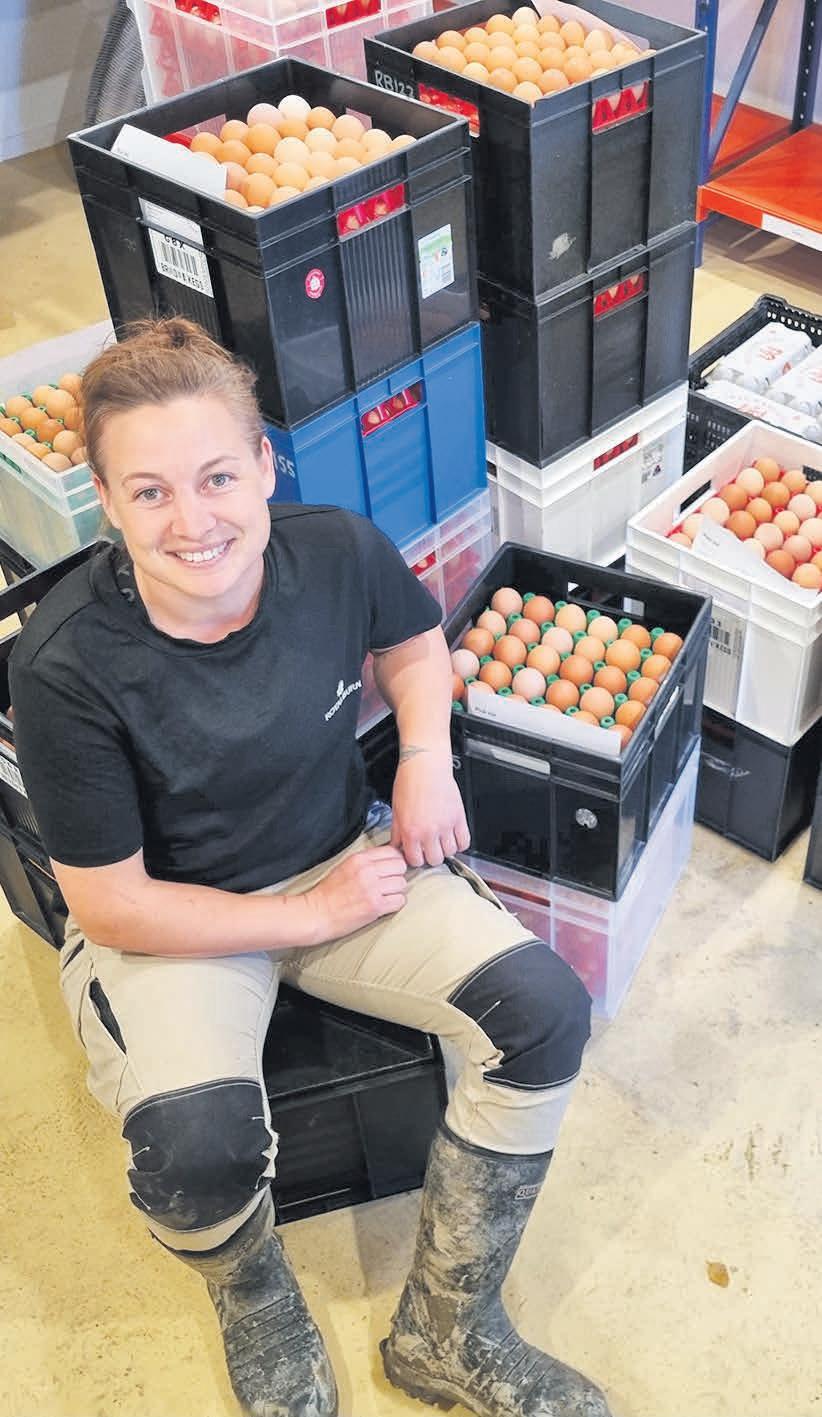
I
“The sales team could sell triple what I make,” Humphries says; $11 will get you a carton.
“There’s some good days and bad days here. It is farming and then it is a high-profile farm and when they decide to do something we go hard and fast, and that can equal hard days.”
Being a poultry manager at Royalburn means perfection for Humphries.
“Chicken feed is very scientific. They must have a certain amount of nutrients, to the perfect percent.
If you get it wrong you can put them off lay.”
Throw in television cameras, and the pressure heightens.
“It was very nerve-racking at the start, my lip would shake. I tried to shy away from anything like that in my life. That’s why I work with animals so I don’t have to talk to people.”
And she really does love her hens.
“I do get attached. I have named a few, but sometimes it is the same name, usually Lucy.”
THE New Zealand Beef Shorthorn Association has elected as its new president Anita Erskine, from Westwood Farm, Tuatapere, Southland.
With her two brothers, Quinton and Eric, Erskine farms 120 Beef Shorthorn breeding cows and replacements together with 2550 Romney ewes and replacements on 455 hectares.
Family ownership of one block of the farm dates back to 1885. Erskine is the second woman to
be elected to the office. In 2010-12 Judy Austin was breed president. She and her husband Bill of Rolleston are life members of the association and now run Austins scanning service.
Eskine takes over from Russell Profitt, of Mahoenui, who had six years as president and remains on the council.
Profitt was instrumental in establishing the Shorthorn progeny trial now being run on his brother Bevan’s farm near Whanganui, visited by the association’s field trip after the recent annual general meeting.
The first offspring of this trial

have been weaned and are now at Russell’s farm for finishing, as interested farmers await the second crop of calves this coming spring.
“It is hoped that the trial will back up the research from overseas, therefore helping the association members sell more bulls, and in the long run will
benefit the Shorthorn Association as more farmers go back to using Shorthorn genetics in their breeding programmes,” Erskine said.
20 People FARMERS WEEKLY – farmersweekly.co.nz – April 22, 2024 People 20
LOVE LUCY: After a stint riding herd in Canada, Jodie Humphries is the ‘egg lady’ on Nadia Lim’s Royalburn Station, in charge of a large flock, several of whom are named Lucy.
Staff reporter PEOPLE Livestock
CAPTIVATING: Newly elected NZ Shorthorn breed president Anita Erskine leading a heifer at the Gore Show.
Confirming the benefits of cow wearables
You can add vets to the Halter fan base for the system’s efficiencies and effect on animal welfare. Hugh Stringleman reports.
ENHANCED communication, real-time monitoring and improved cow efficiency are among the benefits of dairy cow Halters, Kaipara Farm Vets’ veterinarian Rory Dean says.
Working with several of his dairy farming clients using Halter technology, Dean says the farmer-veterinarian relationship is transformed and animal health outcomes improved.
He is reporting back to the Halter company on aspects of the new working relationships, including one farm adopting collars on heifers, a first for Northland.
“Monitoring of the reproduction performance and the animal health treatments and responses have been considerably enhanced.
“Cow observation has been taken to a new level, for my clients and for me.”
The collars measure changes in rumination and movement and any severe fluctuations trigger a health event that is responded to quickly.
“Farmers have an opportunity for early intervention, request an examination and get started on treatment and management.
“Picking cow heats and identifying those struggling to conceive and those that can be pregnancy scanned have also been accelerated.
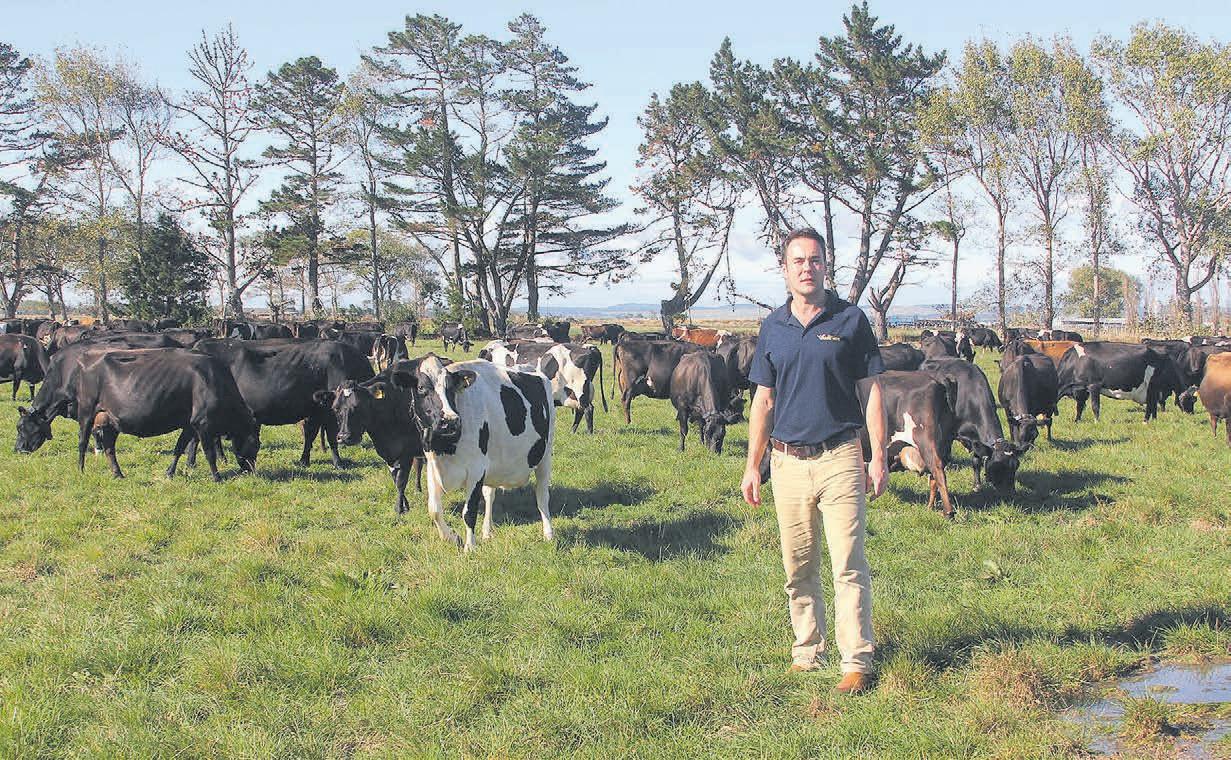
Collars are minimising disease, which is a strong factor in animal welfare.
Rory Dean Kaipara Farm Vets
“Lameness is almost nonexistent because cows now walk at their own pace as they respond to the collar cues and learn their way around.”
Sub-clinical milk fever after a drop in rumination is another early intervention that saves money and improves cow condition.
“We are picking up the disease
far earlier and avoiding the costs of loss of milk production and prolonged cow recovery.”
Dean is well-placed to comment on the animal welfare matters concerning Halters. He is a member of the Australian and New Zealand College of Veterinary Scientists – Dairy Medicine Chapter.
The collar beeps and vibrations in no way compere with impulses from power fencing.
“The cows are getting cues from their collars, supplementing their normal cues from humans, noises and feeding times, and quickly learn to navigate and respond pre-emptively.
“Collars are minimising disease, which is a strong factor in animal welfare, and making health treatments timely and more effective.”
Dean says farmers with Halters gain considerable benefits from management, mapping, pasture utilisation and cow efficiency.
The farmer with Halters on heifers from one year onwards says time management and herd security benefits are additional to improved growth rates from better pasture utilisation.
The heifers are on a run-off, which now receives fewer personal inspections, and the collars are strong deterrents to theft and
illegal slaughter. Should a heifer be moved, injured or killed, an alert from the collar is sent to mobile phones.
Heats are identified earlier and heifers are in better condition to conceive and carry.
Dean says his interactions with dairy farmer Halter clients have been helping them to trust the data and the alerts.
He monitors research and trial work on “wearables” around the world and passes data observations and reports back to his clients.
“In Northland with our smaller herds and labour shortages, the biggest immediate benefits from Halters come from time management and the saving on hours spent moving animals and temporary power fences.
“I have no doubt that the savings more than outweigh the costs of collar leasing.”
Halter recently reduced its prices by 37% to $9.90 per cow per month and published reproductive performance figures from its clients.
The company says Halter farms achieved a median 70.9% six week in-calf rate, 4.1% higher than the 15-year industry median of 66.8% reported by Dairy NZ.
Founder and chief executive Craig Piggott says Halter’s top 10% performing farms achieved an average of 80%.
Halter has launched new Graze, Grow and Mate calculators on its website where farmers can see the potential pasture, mating and milk production gains based on their region, herd size, farm size, supplement costs and milk price.
‘Act now to boost agricultural resilience’
Staff reporter TECHNOLOGY Energy
NEW Zealand needs to act now to boost food and fuel resilience for future global catastrophes, researchers say.
As they outline in a study published in the international journal Risk Analysis, building capacity for biofuel production would not only safeguard NZ’s food supply in the event of a global disaster, it would also make the nation’s fuel supply more resilient to lesser shocks.
However, planning and investment are needed well ahead of any crisis to secure those benefits.
The study estimated the agricultural land area and biofuel volumes needed to feed the population in the absence of trade caused by such catastrophes as nuclear winter, massive volcanic eruptions, or extreme pandemics.
The researchers detail how it would be feasible for NZ to make enough biodiesel from locally grown canola to power agricultural machinery should fuel imports cease – and how without such investment, food could soon run short.
Lead author Dr Matt Boyd of Adapt Research said the research puts a focus on the value of investing now to get ahead of risks that are rising globally.
“There is simply not enough diesel fuel held locally for NZ to ride out a protracted catastrophe, or even a protracted fuel shortage.
“We need to act now to secure local food production against global catastrophes,” he said.
Currently the canola grown in places like Canterbury is used only for producing oil for food purposes.
Co-author Professor Nick Wilson of the University of Otago, Wellington, said the study considers the option of expanding canola cultivation to allow production of enough biodiesel to run the farm machinery that then produces enough food to feed all New Zealanders after a catastrophe.
The study considered the example foods of wheat, potatoes and dairy, with wheat production requiring the least amount of biofuel to produce, harvest and transport to refineries.

FUEL: The study considers the option of expanding canola cultivation to allow production of enough biodiesel to run farm machinery.
“In the long-term, agricultural machinery is likely to all become electrified – but we need assured capability to run diesel-powered farm machinery for quite a number of years.
“Our findings also offer a roadmap for countries worldwide to evaluate their agricultural resilience and take decisive steps toward self-sufficiency.”
The potential to also enhance fuel supply resilience is
highlighted by NZ’s complete dependence on fuel imports, with just 21 days’ worth of diesel in the country at any time. The biofuels option could form part of wider plans for food and energy resilience and needs to be assessed against alternatives in that context.
We need assured capability to run dieselpowered farm machinery for quite a number of years.
21 Tech FARMERS WEEKLY – farmersweekly.co.nz – April 22, 2024 Technology 21
MONITORING: Kaipara vet Rory Dean among the cows with Halters on the dairy farm of John and Stephanie Glass, Ruawai.
Prof Nick Wilson University of Otago
Sector Focus Arable Business is blooming on sunflower farm

AROADSIDE sunflowerselling venture that started as a side income earner has bloomed into a full-time tourist business for Deanne and Phil Crowder.
The Crowders rear calves and grow maize for silage on their 34 hectare farm near Taupiri in Waikato.
They started growing sunflowers in one of their maize crops in 2019 purely for aesthetic value and would sell them via an honesty box at the roadside.
Growing the flowers was also a way for Deanne to honour her sister, who died in a car accident in 2001.
“Sunflowers were her theme at the funeral and it became her flower.
“It wasn’t until we picked them and started the flower cart at the end of the road that we realised how popular they were just as single sunflowers,” Deanne said.
The flowers were meant to be planted on the edge of the crop, but instead were mixed in with the maize seed.
This made retrieving them a challenge in the heat of the summer as they searched for the flowers among the maize, which is almost as tall, Phil said.
“We were walking through the maize crop, holding them up in the air trying not to knock their petals off.”
They started researching sunflowers online and came across sunflower tourism in other countries and took a punt by planting half of a 2ha maize paddock in sunflowers.
Over the course of the next three years it steadily grew as a business where people can pick their own flowers to become the major income earner on what is now known as Taupiri Sunflower Farm.
Last year they grew 245,000 sunflowers and in 2021 had 11,223 visitors through the farmgate.
It’s not been without its challenges and they quickly learnt they have to maximise the flower’s 10-day bloom period by getting local contracting business Gavins to stagger the planting dates through mid-October to early December.
The business is also heavily reliant on the weather, so staggering the dates also reduces the risk if they do get hit by a weather event.
“It’s so hit and miss – the weather is everything with this. If you get high winds or a random storm that comes in, your crop’s done,” Deanne said.
Summer heat can also be a problem. In the season just finished, the intense heat sped up the bloom of the crop.
Also factored into their planting decisions are sunflower varieties. The Crowders use six different varieties, each with its own characteristics around colour, height and flowering length.
People like their photos taken

While the cash they received at the time was small in the context of total farm income, it did give them the confidence that they might have a money earner on their hands.
“It was a pretty good uptake. We were having to run backwards and forwards to fill the cart,” Deanne said.
emergence spray to keep bugs away.
They have also had germination failures, which they believe were caused by a wet spring, meaning a whole block had to be replanted.
“It’s got to the stage where I’ve rung the seed company and we have gone through the varieties and we were trying to find ones that flowered in 40 days instead of 60 days,” Deanne said.
After 10 days of bloom, the flower’s petals begin to fall off as the head continues to grow.
The seeds are offered to anyone who wants them and what is left is mulched back into the ground. They do not collect the seeds because they do not produce enough volume to make it commercially viable to produce oil.
The 2023-2024 season was extremely successful thanks to the good weather with 3.5ha planted into sunflowers, running from December 27 to February 14.
The Crowders worked for 50 days in a row over that period, which was both exhausting and satisfying.
Then there is the work that occurs once the season ends –mulching the flowers and putting away photo props.
On top of that, they were also rearing both autumn and spring calves.
The income derived from this six-week window is enough to keep the business afloat all year.
The couple were rearing autumn and spring Friesian calves but have gradually shifted away from this due to the costs and poor returns.
They have dropped autumn rearing altogether and will only rear spring calves as they focus on tinkering with the sunflower business.
They have also stopped growing maize because the returns are too volatile. Instead the land has been put into pasture for animal grazing.
“We’re making as much out of a hectare of sunflowers as we were out of 20ha of maize.
“Having a block like this, we have to keep thinking outside the box and sunflowers are part of our outside the box,” Deanne said.
They created Taupiri Sunflower Farm through a mix of trial and error and looking online at how sunflower farms operate in other countries.
They also take on board suggestions from visitors.

CASH CROP: Deanne and Phil Crowder grew 245,000 sun owers last year, staggering the planting dates in spring to maximise the plant’s bloom length and reduce the risk of damage from the weather.
which has become popular for family gatherings over Christmas. These are gatherings with at least 25 people who bring their own barbecues or food and then go and look at the flowers, Phil said. The Crowders provide the picnic tables and umbrellas. The visitors book and pay for their tickets online and these are scanned on entry.
The farm’s location – on the main road from Gordonton just before Taupiri – makes it highly accessible.
We’re making as much out of a hectare of sunflowers as we were out of 20ha of maize.
Deanne Crowder Taupiri
Many of the visitors are Chinese or from south Asia. In China, the plant symbolises long life, vitality and good luck, and plays a significant role in Hindu culture.
The sunflower fields also attract lots of families who book it for photoshoots, with the vast majority of people coming from urban backgrounds.
between farmers and those who live in cities.
As well as the personal connection to her sister, for Deanne, the feel-good factor of standing in a paddock full of sunflowers in full bloom is a strong drawcard.
“You can’t be glum in a field of sunflowers.”
Deanne said they try to keep it relaxed as possible with a few farm animals scattered around for people to see and interact with, such as kunekune pigs and goats.
This year also saw the first tour bus stop at the farm, which shows how popular they have become as a legitimate tourist venture.
The farm is booked for music videos, fashion shoots and even as a background set for a circus promotion.
“They set their trapeze up, it’s crazy they’re up high doing flips and stuff.
“My absolute favourite is every year we’ll get a couple of proposals coming through,” Deanne said. They get told in advance and prepare an area among the flowers for the couple.
next to the varieties that grow to eye level and walk through the giant ones, Phil said.
Some varieties take 80-90 days to flower while others take only 60 days.
“It’s a juggling act,” Phil said.
Insects such as slugs and clover flea are another challenge and the Crowders give the crop a pre-
Deanne said what stood out for her this year was that there were far more Waikato visitors. In the past, most of the visitors have come from Auckland. They have also for the first time had repeat visitors.
“We now have regulars and that’s really exciting.”
They have created a picnic area,
“We worked out in the first year that people come for the photos – so we put little props out and we have them all through the sunflowers,” Phil said.
They also planted some sweetcorn to allow tourists to pick their own. Many had never seen a maize plant and had no idea that was how that variety of sweetcorn was grown, Phil said.
The Crowders firmly believe their farm is helping build better bridges
They also created a maze in the crop that opened up to a platform in its centre, which was a huge hit, she said.
Looking ahead, they will plan each crop on a year-by-year basis and will use the rearing to supplement their income.
If the sunflower crop gets hit with bad weather, they still have the option of increasing their calves to handle any income shortfall.
“We’re already planning. As soon as the gates shut, we start planning for next season.”
22 Arable Focus
Gerald Piddock ON FARM Food and bre
CROWDER PLEASER: ‘You can’t be glum in a eld of sun owers,’ say Deanne and Phil Crowder, who run the Taupiri Sun ower Farm in Waikato.
Arable
Will the arable sector still exist in 2050?
Ironically, a tendency to work in silos represents one of the biggest challenges to the arable sector in the years ahead
Sector perspective

NEW Zealand arable growers face many similar challenges to other ag sectors – burgeoning interest rates, increasing input costs and weak contract prices.
We also have our own, sectorspecific challenges such as the recent oversupply of grass seed and maize grain and silage, as well as increasing biosecurity threats, agrichemical resistance issues and environmental compliance costs.
One might be forgiven for thinking that the situation is dire. But it’s not – the arable sector has a number of positive things going in its favour.
Firstly, the diversity of arable farming systems provides a level of resilience to market and environmental extremes that many monoculture-based sectors don’t have. The ability
of arable growers to bounce back after Cyclone Gabrielle and other extreme weather events is testament to that.
Secondly, the integration of diverse cropping rotations and livestock provides the exemplar of what “regenerative farming” espouses. We just need to work out how to extract value from this situation.
And thirdly, if we are to believe the hype around plant proteins, we could be in a position to take advantage of a number of new crop/ product/ market opportunities.
But none of this will come to fruition if we cannot get other sectors to come on the journey with us.
For example, dairy farming has a challenging environmental footprint that arable could help to alleviate. Integrating homegrown grain and silage into the dairy platform has numerous welldocumented benefits, yet the dairy industry struggles to move away from its “grass fed” mantra; even though it could tell an even more compelling story targeting 100% New Zealand origin, improved animal health, and sustainability.
Poultry could do the same. Surely using home-grown feed is a better selling point than importing overseas soy meal, maize grain and PKE?
Despite the obvious links between NZ’s many primary sectors, there is an apparent inability to plan and work together to ensure that growth opportunities for one sector don’t negatively impact others.
The plant protein space is a classic example. I am tired of reading reports about how developing a plant protein industry in NZ will help address the negative environmental impacts of livestock farming and add value to cropping farmers.
Land-use change away from

GROWING DOUBT: FAR CEO
add value to cropping farmers’.
livestock will not help arable farmers, firstly because the livestock sectors are our biggest markets, and secondly because food processors want plant protein crops at commodity prices. Where is the value to arable in reduced markets and commodity prices? Plant protein crops will only be viable in NZ if they attract a premium based on their provenance, sustainability credentials and/or unique selling proposition and I haven’t seen, as yet, any strong evidence for any of these factors.
Mixed cropping/livestock farming systems do have potential to mitigate many of the challenges facing agriculture in NZ, so we need our livestock, arable, vegetable and forestry sectors to start working together to develop them. History has shown that working in silos will create all sorts of unintended consequences.
Encouraging a home-grown approach to food marketing seems
Researchers toast record Canterbury barley yields

CANTERBURY barley yields hit a record high this past harvest season – not necessarily meaning greater beer production but certainly keeping researchers happy.
Based on Cultivar Performance Trial (CPT) results, yields this harvest were the highest ever recorded.
Autumn-sown barley yields for 2023-24 were well above the four-year mean in Canterbury, at both the irrigated site, where an average of 13.2 tonne a hectare was recorded, and dryland site at 13.0t/ha.
These are the highest recorded autumn-sown barley yields in a CPT trial since records began, Foundation for Arable Research
CPT manager Tabitha Armour said. “As this is an average. Some individual trials approached yields of 14t/ha.
“This is close to the former world record barley yield of 13.8t/ha set by South Canterbury growers Warren and Joy Darling in 2015.”
Irrigated feed and milling wheat yields were also above average in Canterbury this harvest.
In comparison, the four-year mean for trials sown from 2020 to 2023 is 10t/ha for irrigated barley at Chertsey, near Ashburton, and 10.9t/ha for dryland barley at St Andrews, just south of Timaru. Irrigated feed and milling wheat yields were also above average in Canterbury this harvest.
Feed wheat recorded 14.8t/ha, averaged across four irrigated trial sites, up 1.8 t/ha on the four-year mean. Milling wheat was 12.2t/ha, up 1t/ha.
Dryland feed wheat yields in Canterbury, Southland and the southern North Island were similar to the four-year mean, although this depended on location, with most sites experiencing below average rainfall for several months during the season.
New feed wheat entry KFW2201 was in the top yielding group in all locations tested and out-yielded all other entries in four of the six Canterbury trial sites.
Some cultivars producing good yields are susceptible to disease, as shown in fungicide treated versus untreated trials, Armour said.
Hail in the Methven region damaged a milling wheat trial
efficiencies of scale, cheaper labour and, dare I say it, in some cases, lower production standards.
NZ needs to recognise that having free trade agreements with other countries doesn’t mean that it can’t support, facilitate and promote the production and purchase of homegrown food. Food security is a legitimate justification used by many countries to support their food producers, so where are NZ’s policies on protecting the production of grain, milk, meat and fresh fruit and vegetables?
If the government provided incentives (not subsidies) to improve existing food supply chains or create new food production systems, this would most certainly enhance the future sustainability of arable and vegetable production in NZ.
Despite the obvious links between NZ’s many primary sectors, there is an apparent inability to plan and work together.
another potential solution, but unfortunately, NZ consumers don’t seem to care as much as overseas consumers do about buying local. While some customer segments will go out of their way to access local produce and may be prepared to pay a very small premium, it is nothing like the situation you see in Australia, the United States, the United Kingdom and Europe where “buying local” is absolutely on trend.
Market research suggests that price is still the driver for consumer behavior in NZ and so we will continue to struggle to compete with imported produce whose pricing is influenced by
If NZ consumers preferentially bought locally produced bread and were prepared to pay an extra 10 cents on a $3 loaf, with three cents of that going back to the grower, this would make a huge difference to the profitability of growing wheat in NZ and make the food supply chain secure.
So, coming back to the title question: do I believe that arable will still exist in 2050? Yes, I do, but probably in two forms. There will still be farms in the main grain growing areas of the South Island that are truly “arable”, but they will be fewer in number and larger in size to create the efficiencies of scale needed to maintain profitability.
And then there will be a multitude of small, medium and large mixed farming systems across the country of which grains and seeds will form a component to a greater or lesser extent.
At that point, are these still called arable farms? Possibly not. But does it really matter if it involves growing arable crops in a profitable and sustainable way?

and another trial in Fairlie was compromised because of rainfall events during establishment. For more information, visit the FAR website www.far.org.nz and search for Harvest Snippets 2024. FAR also produces autumn
and spring cultivar evaluation booklets, which highlight the performance of new cultivars entering the industry. The autumn edition will be online in early April and in farm mailboxes later in the month.
23 FARMERS WEEKLY – farmersweekly.co.nz – April 22, 2024
23
Alison Stewart
Dr Stewart is CEO of the Foundation for Arable Research
Dr Alison Stewart says she is ‘tired of reading reports about how developing a plant protein industry in NZ will
Annette Scott NEWS Crops
NEW HIGH: This past harvest recorded the highest autumn-sown barley yields since FAR trial records were started.
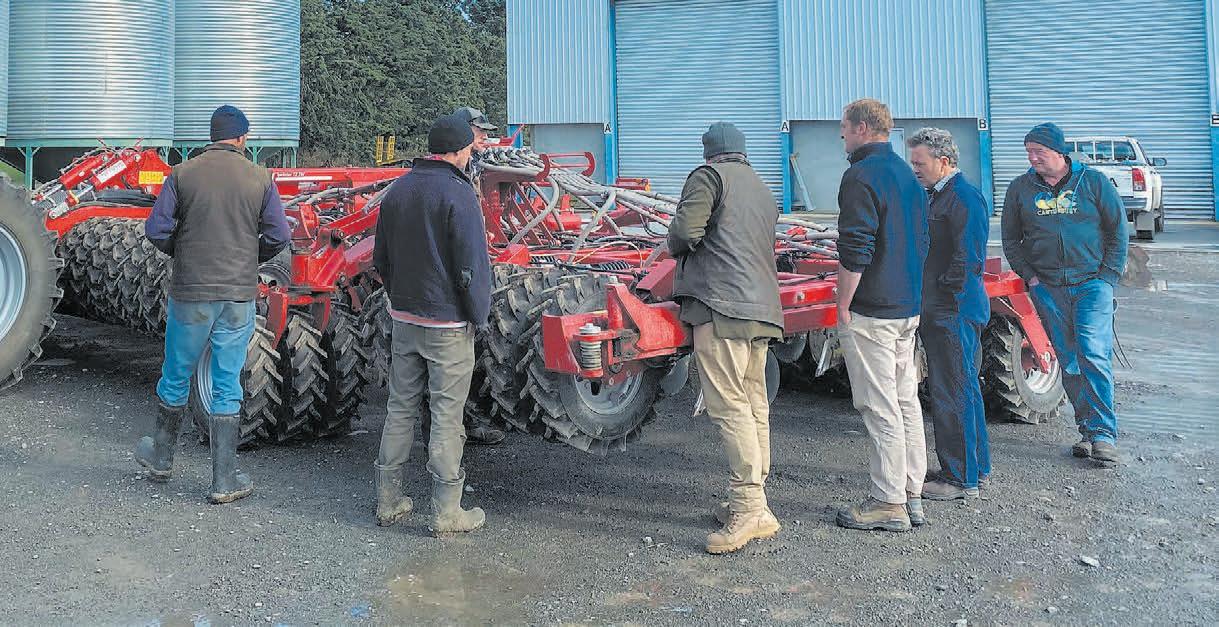


A DV E RT I S E M E N T 24
Resistance rides in on imported seed: survey
 Annette Scott TECHNOLOGY Crops
Annette Scott TECHNOLOGY Crops
FIVE years of random weed surveys have identified the extent of herbicide resistance in weeds on arable farms in New Zealand, with imported seed lots providing a pathway for the resistance.
The region with the highest level of herbicide resistance was South Canterbury, with 71% of farms recording at least one instance of herbicide-resistant weed.
In contrast, in the eastern North Island, herbicide-resistant weeds were found on just 11% of farms.
While it has been suspected for some time, the numbers prove that herbicide-resistant weeds are widespread on arable farms, Foundation for Arable Research (FAR) senior field officer Ben Harvey said – “with very high levels in some regions”.
The confirmation comes after five years of random herbicideresistant weed surveys on arable farms, each year in a different region taking in Wairarapa, Manawatū, Hawke’s Bay, Canterbury, South Otago and Southland.
Farms were randomly selected with the aim of visiting 20%-30% of all arable farms in each region. Surveys were carried out in
January prior to harvest when weeds that had survived herbicide application were most likely to have produced viable seed.
Seed was collected from any weeds that appeared to have survived normal herbicide application, with a focus on grass species that had known resistance overseas.
Seeds were sent to AgResearch to be grown out and the resulting plants tested for resistance to a range of appropriate herbicides. About 4000 individual plant herbicide interactions were tested from 63 species of weed collected across 168 farms.
FAR has published an Arable Extra summarising the results. It shows all cases of resistant weeds were to herbicides in Modeof-Action Groups 1 and 2, with regions often having their own difficult-to-control weeds.
The most common resistant weed is the ryegrass Lolium species.
Group 1 herbicides are used to control grass weeds in a range of broadleaf and cereal crops. Group 2 herbicides have activity on a wide range of grass and broadleaf weeds and are also used widely in cereals.
Both classes of herbicides are used post-emergence on the weeds.
Worldwide, resistance to Group 2 herbicides is the most widespread
form of herbicide resistance.
No resistance to glyphosate (Group 9), the world’s most popular herbicide, was recorded on arable farms, although it has been detected outside of the random surveys.
As well as South Canterbury, also recording a high level of resistance were Mid Canterbury farms at 60%, the Selwyn District, 54% and Southland 59%.
Harvey said regional differences appear to relate to differences in farming systems, as areas where crop rotation options are limited tend to have higher levels of resistance.
Growers should always be vigilant and follow up on any patches of weeds that appear to have survived herbicide application.
Ben Harvey FAR
Other factors include whether pasture is commonly included in rotations, the prevalence of grass seed crops, particularly ryegrass, in the rotation, and whether spring crops, which can disrupt weed life cycles, are commonly included in rotations.
Ryegrass, both annual and

perennial, is the main offender with resistance to Group 1 and 2 herbicides.
“Resistance seems to be everywhere, but especially in South Canterbury.”
Imported ryegrass seed lots have provided a pathway for introducing herbicide resistance onto NZ farms.
In addition, rare individual plants can gain resistanceconferring mutations.
Wild oats is another weed growers need to keep on top of, particularly in Canterbury, with rogueing required to eliminate plants resistant to Group 1 herbicides.
Southland has two particularly problematic weeds: chickweed, which is resistant to chlorsulfuron (Glean); and Rayless chamomile, resistant to Group 2 herbicides.
In North Island maize-growing areas, fathen is resistant to atrazine.
While arable growers in Canterbury, Southland and Otago are more likely to be affected by herbicide resistance, Harvey said it is worth noting that all the regions surveyed had some degree of resistance.
“Growers should always be vigilant and follow up on any patches of weeds that appear to have survived herbicide application.”
Assistance is available through FAR and agrichemical company representatives.
More funding is being sought to further investigate integrated weed management to support growers to find ways to combat herbicide resistant weeds on their farms.
Cultural control approach may spell doom for pests

CONTROLLING pests with minimal use of pesticides was the focus of an industry seminar presented to arable farmers by Australian entomologist Paul Horne in Ashburton.
Organised by the Foundation for Arable Research (FAR), the seminars, with the focus on integrated pest management (IPM), were replicated in Gore and Timaru
Horne established Melbournebased IPM Technologies more than 20 years ago to help farmers get better value out of fewer insecticides and improve control of insect pests by using IPM.
Specialising in facilitating adoption of IPM using a participatory approach, Horne has developed and implemented practical IPM strategies to manage invertebrate pests in a wide range of both protected and outdoor crops including cut flowers, berries, vegetables, tree and vine crops, nurseries, broad-acre crops and pastures.
“We have worked on a wide range of projects across Australia and overseas with clients including small and large farming operations, R&D corporations, Australian and multinational chemical companies, agronomy

companies, landcare groups and catchment management authorities.
“We help farmers and decision makers to control pests with minimal use of pesticides working across a whole range of different crops.”
IPM is the successful integration of all available methods of controlling pests, rather than just relying on pesticides.
An IPM strategy deals with all pests, harnessing biological and cultural controls as the first line of defence and using compatible chemicals, those that are least disruptive to the key biocontrol agents, as a support tool only when necessary.
Cultural controls are any
management methods that either enhance populations of beneficial species or disrupt populations of pest species.
“In some cases cultural controls can be the most effective control of all and eliminate the need for pesticides all together,” Horne said.
Some examples of cultural controls are variety selection, time of planting, weed control, crop rotation and irrigation.
“The list of options for IPM is endless and is often determined by the individual requirements and possibilities on each farm.”
Chemical control in an IPM system means that the choice of which pesticide to use is not only based on the efficacy on the pest
EVALUATION: In an interactive session pest specialist Paul Horne evaluated speci c pests put forward by farmers into a possible IPM strategy.
but also on the impact the product might have on beneficial species.
“There are many selective pesticides available but that does not mean that they are all safe to all beneficial species.
“It is important to understand the impact that each product will have on the key beneficial species for each crop type.”
The aim of IPM is not to eliminate all pesticide use, but to use pesticides as support tools for when biological and cultural controls are not enough on their own.
Some pesticides are not synthetic chemicals and include bacterial, viral and fungal pathogens that are formulated
The list of options
for IPM is endless and is often determined by the individual requirements and possibilities on each farm.
Paul Horne IPM Technologies
to be sprayed in the same way as chemical insecticides.
“The aim of monitoring is to decide if a crop needs a pesticide application or not, and if so, which one.”
For IPM crop monitoring this involves looking for both pest and beneficial species.
Horne said the best way to do this is by direct searching and using a hand lens.
Pheromone traps and sticky traps can also be useful tools.
The frequency and intensity of monitoring is determined by many factors including time of year, pest pressure, value of the crop and the needs of each farm.
“It is important that the monitoring programme is simple, practical and achievable. It is better to a do a little bit often than none at all.”
Horne emphasised IPM is about accepting all three: pesticides, cultural control and biological.
25 FARMERS WEEKLY – farmersweekly.co.nz – April 22, 2024
25
Arable
WAY IN: FAR senior eld o cer Ben Harvey says imported ryegrass seed lots have provided a pathway for introducing herbicide resistance onto New Zealand farms.
Annette Scott TECHNOLOGY Pests


Here for emergencies (and ever y thing else)







Okay, we don’t actually have rescue helicopters, but we do have expert local knowledge and round-the-clock parts and service support for emergencies.
And that means we’re always there to keep you moving, no matter what.
66 79 663
nor wood.co.nz 0800
CBN0705 Norwood Pr nt Ad 380x262 indd 1 Nor 38 x2 16/04/2024 8:39 AM 26
FARMERS
Immigration changes a Ministerial misstep?
Federated Farmers is set for an urgent meeting with the Government to discuss recent changes to work visa rules that are causing huge concern and confusion among farmers.
On April 7, the Government announced several changes to the Accredited Employer Work Visa (AEWV) scheme, which came into e ect immediately and retrospectively.
Richard McIntyre, Federated Farmers immigration and labour spokesperson, says his phone has been running hot ever since with calls from distressed farmers across the country.
“What’s concerned farmers the most is just how suddenly the changes have been made. For many employers, they came out of the blue and have caused a lot of confusion.
“It’s already challenging enough to nd and keep farm sta . These sudden changes will only make things harder for those trying to bring in sta from oversees to ll a gap in their team.
“For those farming families already short-sta ed and under real pressure, it’s the last thing they wanted to see before the start of the new dairy season.”
Changes include a shorter visa length of two years, with a maximum continuous stay period of three years, and the introduction of a
12-month stand-down period at the end of the visa.
“This means sta will essentially need to get two separate visas if they want to stay for the full three years: a two-year visa and then a further oneyear visa,” McIntyre says.
“That adds a lot of unnecessary cost and uncertainty for both the employer and the sta . It will also mean more work for alreadystretched immigration sta who need to process the visas.”
Employers will need to advertise vacancies on their farm for 21 days, up from 14 days previously, and will now have an obligation to engage with Work and Income.
There are also new minimum requirements that applicants need to prove they have at least three years’ relevant work experience, or a relevant quali cation at Level 4 or above.
Workers applying for some roles will also now be required to prove they can speak and understand English.
“It’s safe to say Federated Farmers don’t support all of the Government’s changes and have concerns that we want to see addressed,” McIntyre says.
“Because the changes came into e ect immediately, they have put a number of farmers in a di cult and unforeseen situation where they may not be able to ll roles this season.
“Sta shortages are a serious issue that can have a huge impact on health and safety, animal welfare, environmental compliance, and farmers’ mental health.
“Whether you’ve got sta or not, the work still has to be done. It’s not like you can just not feed or milk your cows for a few days.
“You just end up working longer hours or taking less days o . That’s when you start to get tired, your mental health su ers, and you come under real pressure.”
McIntyre is also concerned about the impact the 12-month standdown requirement will have on New Zealand’s ability to attract and retain talent in a competitive global market.
“What kind of e ect is that going to have on on-farm work ow, and to the migrant themselves, if they have to leave New Zealand for a year before they can progress into a skilled role or visa?
“We aren’t the only farming country struggling to ll farming roles. Our international competitors like Australia and Canada are facing the exact same labour shortages.
“There’s a very real risk that any standdown period will see skilled employees, who Kiwi farmers have invested a lot of time and money in, picked up by those other countries.”
We need to be making it as smooth as possible for these farming families





















There’s a very real risk that any standdown period will see skilled employees, who Kiwi farmers have invested a lot of time and money in, picked up by those other countries.
Richard McIntyre Federated Farmers immigration and labour spokesperson
to put down real roots and properly integrate into our rural communities, McIntyre says.
“If we create too many hoops for them to jump through, or make things too di cult, they might
just choose to call somewhere else home.”
McIntyre says he’s also concerned about how the changes will increase wait times and costs to farm employers, and how they’ll add further pressures to the immigration system.
“Farmers have already been experiencing huge delays when it comes to processing visas, and these changes are only going to make that worse.
“The ongoing impact of these changes is likely to result in a need for increased processing e ort across visa applications.
“That means farmers should be factoring in more time, rather than less, for applications to be processed by immigration.”

27 Fed Farmers FEDERATED
Vol 2 No 14, April 22, 2024 fedfarm.org.nz
DOUBLE TROUBLE: Under the new Accredited Employer Work Visa scheme, sta will essentially need to get two separate visas if they want to stay for the full three years, Federated Farmers immigration and labour spokesperson Richard McIntyre says.
Farm plans must be practical and cost-effective
Overhauling the farm planning system is a positive and pragmatic step forward from the Government, Federated Farmers say.
The Government has announced it intends to improve freshwater farm plans, creating a system that enables farmers to find the right solutions for their farm and catchment.
Farmers will be cautiously optimistic about this news, Federated Farmers freshwater spokesperson Colin Hurst says.
“It’s 100% the right thing to do. Farmers support farm plans as a tool for improving environmental outcomes, but they need to be practical and cost-effective.
“The current system is incredibly frustrating, with a lot of unnecessary cost, complexity and duplication. There are huge opportunities for the Government to make improvements.
“We’ve been calling for urgent and significant changes to make the whole process simpler and more affordable for farmers, so it’s good to finally see some movement.”
Fixing unworkable freshwater rules was one of Federated Farmers’ 12 key policy changes for restoring farmer confidence during last year’s General Election.
“It’s absolutely critical for the Government to get this right,” Hurst says.
“Farmers don’t want another expensive ‘box ticking’ exercise that ties us up in endless red tape and arbitrary paperwork for very little environmental gain.
“Farm plans allow farmers and rural communities to tailor their environmental improvement actions to match their specific local needs.”
Hurst says this will lead to
much better outcomes, and more community buy-in, than impractical and expensive one-size-fits-all rules driven out of Wellington.
“At face value, this is a really positive step forward for both farmers and the environment, but the devil is always going to be in the detail.
“It’s good to see the Government talking about taking a risk-based approach, where the level of plan you need to put in place is determined by your specific catchment and farming activity.
“It’s also really encouraging that they’re looking at how existing sector or council farm plans could be recognised or integrated, because over 10,000 farmers already have a plan in place.”
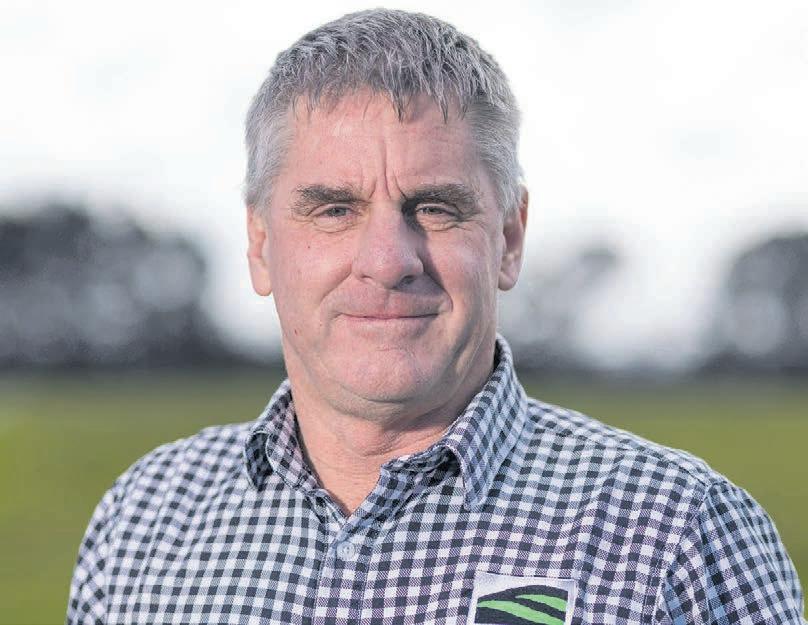
practical on-farm actions to manage those risks.
“The current system is too costly and complex, and too broadly applied. We want to make sure the cost of completing a farm plan, in both time and money, is matched with the level of risk.”
WORTHY: Farmers support farm plans as a tool for improving environmental outcomes, but they need to be practical and costeffective, Colin Hurst says.
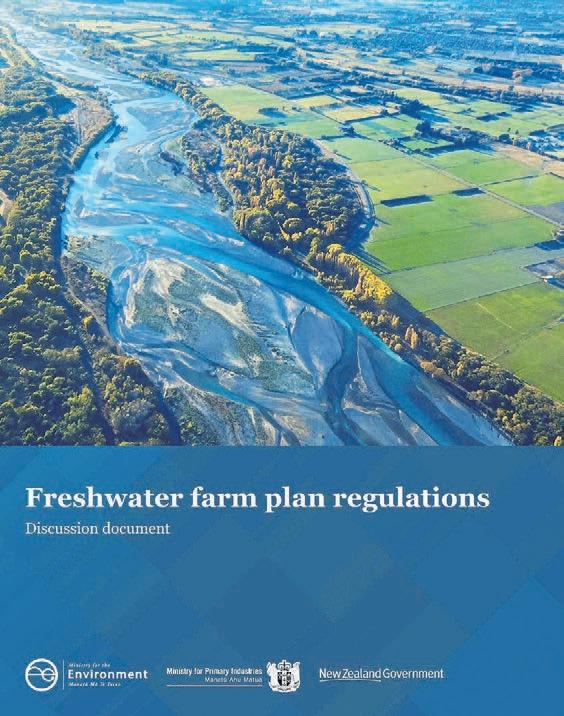
Hurst says this announcement will leave many farmers in a state of limbo, wondering if they should get a freshwater farm plan under the current rules or wait for changes.
“The Government needs to address this uncertainty by extending timelines in regions that already have freshwater farm plan requirements in place.
“Councils have already started implementing freshwater farm plan rules, but it makes no sense to force farmers to comply when we know the rules are about to change.”
In the Government’s announcement on April 10, Associate Environment Minister Andrew Hoggard said farmers faced an avalanche of regulation under the last Government, including its national Freshwater Farm Plans system.
“Using property and catchment specific farm plans makes sense because they can be used to identify environmental risks and plan
The current system is incredibly frustrating, with a lot of unnecessary cost, complexity and duplication. There are huge opportunities for the Government to make improvements.
Colin Hurst Federated Farmers freshwater spokesperson
Hoggard said it’s important that councils and the community can have confidence in the robustness of the freshwater farm plan system as an alternative to local rules and consents, where and when appropriate.
“We believe farm plans should be able to highlight the work many farmers and growers are already doing to reduce the impact of farming activities on the freshwater environment.”
Several regions have already started implementing freshwater farm plans in specific areas, including Waikato, Southland, the West Coast, Otago, and Manawatū-Whanganui. The Government wants an enduring system that builds on the good work of farmers in those regions, while ensuring any improvements to the system don’t result in sudden changes to plans already being developed, Hoggard said.
“We are exploring how to make any changes fair for all farmers. As part of this, we may look into whether current requirements to complete a freshwater farm plan could be paused while improvements are developed.”
Agriculture Minister Todd McClay said decisions will be considered alongside the Government’s overall approach to freshwater management, including stock exclusion and winter grazing.
“We have heard that many in the sector would like existing environmental programmes to be recognised in the freshwater farm plan system.”
He said officials are considering ways to integrate existing farm environment plans or industry assurance programmes in the system.
Fostering producer confidence and harnessing innovation for a resilient primary sector






PRIMARY INDUSTRIES NEW ZEALAND SUMMIT & AWARDS
TĀKINA WELLINGTON
2-3 JULY 2024,
28 April 22, 2024 – fedfarm.org.nz Federated Farmers 28
FAIR: Federated Farmers wants to make sure the cost of completing a farm plan, in both time and money, is matched with the level of risk, Freshwater Spokesperson Colin Hurst says.







































29 PROVINCE DATE VENUE TIME North Otago Monday 29 April Brydone Hotel Oamaru 6 00pm South Canterbury Monday 29 April Pye Group Ltd 276 Rise Rd Winchester 2 00pm Mid Canterbury Wednesday 1 May Jack Brand Room, Federated Farmers Buildings, West Street, Ashburton 7 30pm Southland Thursday 2 May Ascot Park Hotel in Invercargill 1 30pm Northland Thursday 2 May The Butter Factory on Butter Factory Road 2 00pm Manawatu/Rangitikei Thursday 2 May Te Matapihi, the Bulls Community Centre 3 00pm Marlborough Thursday 2 May Woodbourne Tavern Restaurant 1 00pm Auckland Friday 3 May BNZ Partners Highbrook 12 00pm Taranaki Friday 3 May TET Stadium Inglewood 1 30pm Ruapehu Monday 6 May Rusty Nail Tavern, Taumarunui 5 30pm North Canterbury Wednesday 8 May Thirsty Acres Kirwee 4 30pm Otago Thursday 9 May Luggate Memorial Centre 4 00pm Hawke’s Bay Thursday 9 May Venue Elwood Function Centre, 15 Otene Road 4 30pm Gisborne/Wairoa Friday 10 May BDO, 1 Peel Street, Gisborne 12 00pm Golden Bay Tuesday 14 May Nikau Cafe in Pohara 5 30pm Nelson Wednesday 15 May Club Waimea in Richmond 1 00pm Bay of Plenty Wednesday 15 May Edgecumbe Hall 10 00am Wairarapa Thursday 16 May The Farriers Bar & Eatery, Masterton 2 30pm West Coast Thursday 16 May The Ashley Hotel, Greymouth 2 00pm Hauraki/Coromandel Thursday 16 May Ngatea Rugby and Sports Club, Hugh Hayward Domain 1 00pm Waikato Friday 17 May JetPark by the Hamilton Airport 2 00pm Tararua Wednesday 22 May Tui Brewery Mangatainoka 5 00pm Rotorua/Taupo Wednesday 29 May Commercial Travellers Club on 26 Moncur Drive 1 00pm G E T A L O N G TO Y O U R L O C A L F E D E R AT E D FA R M E R S A G M W A N T A S T R O N G E R VO I C E F O R FA R M I N G ?
Southland’s rates still heading north
Alooming double-digit rates hike is enough to raise Southland farmers’ hackles, but proposed changes to flood protection are also proving a hot topic.
Environment Southland’s LongTerm Plan (LTP) includes a move to replace 140 existing catchment rates with a single new flood protection infrastructure rate, based on property capital value.
Federated Farmers Southland life member David Rose is deeply concerned by this “one bucket” approach to catchment management.
“This proposal undermines the important principles that people who benefit most from a service should pay the most, and people paying deserve a close say in how the money is spent,” Rose says.
“Call it socialism, regionalisation, ‘we’re all in this together’ or whatever else you like but it doesn’t seem right that someone sitting behind a stopbank in Gore, for example, pays the same rate on capital value as someone 100km away with little or nothing by way of flood protection.”
Rose, a former Federated Farmers national board member, is also concerned that Environment Southland is presenting only one option for catchment expenditure.
“I attended several council LTP workshops and I remember a specialist saying best practice for genuine consultation is to present different options – not too many, but two or three, and not the only alternative being the status quo.
“Presenting just one option versus the status quo has a feel of railroading us towards what Environment Southland want to do.
“Most people haven’t even woken up to the fact such a big change is being talked about,” he says. The current catchment rating
system has its roots in the formation of catchment liaison committees in 1979. There are 17 schemes under eight such committees.
Environment Southland says the schemes’ boundaries are based on old flood analysis, and don’t provide for upstream solutions or downstream consequences.
More than 2300 rural ratepayers will be paying more, with 160 of them paying an extra $500 a year or more.
Rose, who co-chairs the Oreti River catchment liaison committee, says there could be options for more fairly spreading the costs of stopbanks and their maintenance, floodgates, warning systems and the like.
But moving to a region-wide system and one pot of money would dilute transparency and accountability, he says.
“While the catchment committees are only for liaison, and the council has the final say, we’ve proved our worth with common sense input into budgets and plans. Significant savings have resulted.
“Is the end game a ‘one Southland liaison committee’, diluting the existing local scrutiny?” he asks.
“Will they then start rolling the reserves we’ve built up into one pot as well?”

Those funding processes are “narrowly focused and overly complex”, the council’s LTP consultation document says.
As at June 30 last year, the Oreti catchment alone had a disaster reserve of $1.6m and another $3.5m in lease reserves.

Rose says there’s also nothing in the council documents that accounts for the special circumstances of the Waiau catchment.
Power company Meridian pays an annual contribution (around $400,000 this year) to account for the fact it diverts all but 10% of the river’s flow for power generation.
It’s seen as compensation for farmers for the consequences of the negative effects of that lower flow.
“That’s pretty unfair if Waiau area farmers end up paying considerably more in rates for work that will never happen in their area,” Rose says.
The LTP proposes an increase in flood operational spending of $2.3m per annum. Future improvements would be debt-funded, with debt rising from $18.9 million in 2025 to $73.2m by 2034.
Rose says about half of that 2025 debt relates to the “massive blowout” in the Lake Hawkins pumping scheme, from $750,000 to $9m.
“That’s a debacle ratepayers still haven’t had a satisfactory explanation for, nor assurances it can’t happen again.”
Federated Farmers president Chris Dillon says, according to council

Join us for this one-day event that includes captivating keynote speaker Philippa Cameron, engaging workshops, a chance to connect with sector organisations, and rounding the day off with the Casino Royale Gala Dinner! THURSDAY
figures, the flood rate proposals will mean a decrease for 3500 rural property owners and, overall, the rural sector’s share of the total rates take will drop from 45% to 41%.
“But it’s a case of swings and roundabouts. More than 2300 rural ratepayers will be paying more, with 160 of them paying an extra $500 a year or more.
“Longer term, we’ll likely have more focus on urban stopbanks and higher costs, with less debt headroom if there’s a big flood.”
Proposed overall rates increases of 23% in 2025, 11% in 2026 and 13% in 2027 “shows the council isn’t doing the belt tightening and cost cutting many of the region’s households and businesses are having to do”, Dillon says.
The switch to capital value rating means farmers who’ve invested in improvements, such as expensive wintering barns to lessen environmental impact, will now be slapped with higher rates.
“Federated Farmers Southland will have a lot to say in our submission on this LTP,” Dillon says.
“We urge individual farmers to also look at the impacts on them, and to speak up.”


30
2 MAY, NEW PLYMOUTH T s & C s Apply GO INTO THE DRAW FOR REGISTER OR FIND OUT MORE! A PINK U B BY REGISTERING & AT TENDING THIS YEARS CONFERENCE A CHANCE TO WIN April 22, 2024 – fedfarm.org.nz Federated Farmers 30
TIGHTER: There’s plenty of scope for Environment Southland to do some more belt-tightening, Federated Farmers Southland president Chris Dillon says.
CHARGED: The switch to capital value rating means farmers who’ve invested in improvements, such as expensive wintering barns to lessen environmental impact, will now be slapped with higher rates, says Chris Dillon.
Chris Dillon Federated Farmers Southland president




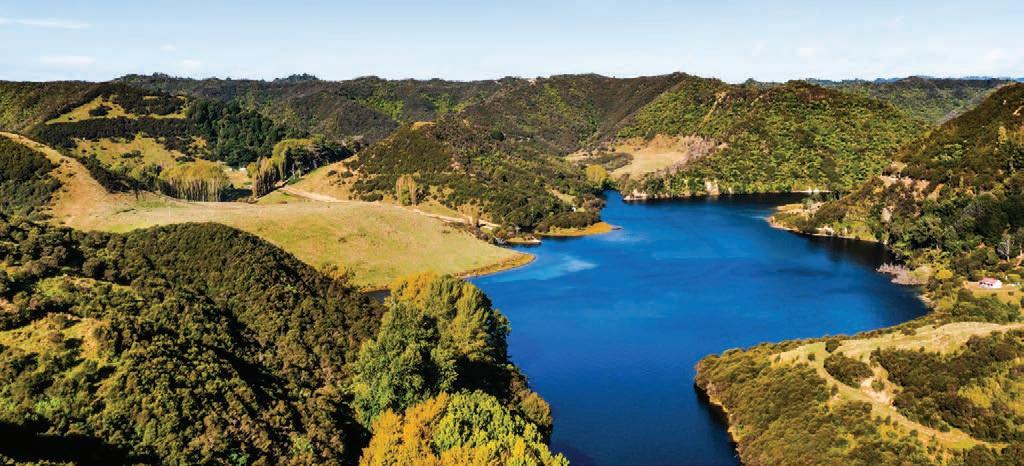

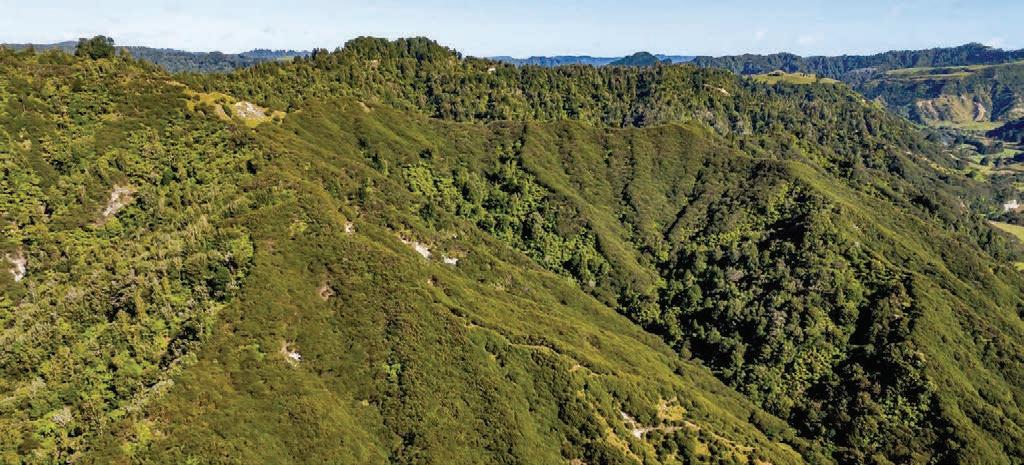

Scale, value and options
This 621ha property of strong hill country presents a range of options with exposure to different markets.
Planted in 2017, 193ha of Mānuka is entered in the ETS, attracting carbon and honey income, with potential to increase this. The property has a history of pastoral farming, with regular rainfall. On a separate title, the 4-bedroom home offers comfortable accommodation, along with a single garage, a three stand woolshed, satellite sheep yards and implement shed.
Makuri wilderness
The 186.96 ha Makuri wilderness property includes large areas of Mānuka, with around 30 hectares planted in 2017, and regenerating native bush. This Mānuka produces high quality honey with MGS values consistently above 20. The 2-bedroom lodge provides options for recreational enjoyment and hunting or ecotourism ventures, supported by the Department of Conservation land that surrounds it.
761ha paradise
Unlock the potential of this property nestled across two titles, boasting 761ha (more or less) of versatile land. Located in proximity to the renowned Hawera water-ski club and camping area, convenience meets leisure at the end of the road. With two huts, two woolsheds, and well-maintained access tracks, the property is equipped for both lodging and utilizsation for honey production and recreation.
Bush block boasting Manuka honey production
Located 80km east of New Plymouth, Okau Road is a 429ha (more or less) bush block, currently utilised for manuka honey production. Okau Road provides good access year-round to the northern side and the property has a central valley track providing ground access to hive sites. Eco-tourism possibilities can be explored.
Discover the potential: multi-title property
Unlock the possibilities of this diverse property spanning six titles, currently optimized for manuka honey production and grazing. With the option to expand grazing pasture on the valley floor and






FIVE BLOCKS, MULTIPLE OPPORTUNITIES
explore the potential of establishing a pine plantation for carbon sequestration, the opportunities are endless. Benefit from a well-maintained track offering easy access to hive sites throughout the property. Tender (unless sold prior) 1pm, Wednesday 15th May 2024 186 Chapel Street, Masterton Andrew Smith 027 760 8208 Lindsay Watts 027 246 2542 EASTERN REALTY (WAIRARAPA) LTD, BAYLEYS, EASTERN REALTY (WAIRARAPA) LTD, BAYLEYS, LICENSED UNDER THE REA ACT 2008 bayleys.co.nz/3151206 Tender (unless sold prior) 1pm, Wednesday 15th May 2024 186 Chapel Street, Masterton Andrew Smith 027 760 8208 Lindsay Watts 027 246 2542 EASTERN REALTY (WAIRARAPA) LTD, BAYLEYS, EASTERN REALTY (WAIRARAPA) LTD, BAYLEYS, LICENSED UNDER THE REA ACT 2008 bayleys.co.nz/3151219 Tender (will not be sold prior) 1pm, Wednesday 15th May 2024 256 High Street, Hawera Tim Dwyer 027 277 3231 tim.dwyer@bayleys.co.nz SUCCESS REALTY LTD, BAYLEYS, LICENSED UNDER THE REA ACT 2008 bayleys.co.nz/2601801 Tender (will not be sold prior) 1pm, Wednesday 15th May 2024 15 Courtenay Street, New Plymouth Tim Dwyer 027 277 3231 tim.dwyer@bayleys.co.nz SUCCESS REALTY LTD, BAYLEYS, LICENSED UNDER THE REA ACT 2008 bayleys.co.nz/2601802 Tender (will not be sold prior) 1pm, Wednesday 15th May 2024 256 High Street, Hawera Tim Dwyer 027 277 3231 tim.dwyer@bayleys.co.nz SUCCESS REALTY LTD, BAYLEYS, LICENSED UNDER THE REA ACT 2008 bayleys.co.nz/2601800 621.49ha 186.96ha 760.73ha 428.81ha 1,607.58ha 737 Waihoki Valley Road, Pongaroa 3257 Pahiatua-Pongaroa Road, Pongaroa 1519 Tangahoe Valley Road, Hawera 1870 Okau Road, Urenui Okara Road, Stratford Sounds 31 Real Estate

Winks is a proven winner





Manaia 119 Winks Road 54 5466 ha Tender (will not be sold prior) Closing 1pm Tue 30 Apr 2024 15 Courtenay Street, New Plymouth Brendan Crowley 027 241 2817 brendan crowley@bayleys co nz SUCCESS REALTY TARANAKI LTD BAYLEYS L CENSED UNDER THE REA ACT 2008
Located on Winks Road in Manaia this exceptional dairy farm offers 100 hectares (more or less) of premium flat land in a strong dairy farming area, complete with a 36-aside herringbone cowshed, support sheds, two houses, a massive feedpad and two maize bunkers With the potential for high production in the hands of committed farmers, this well-set-up property boasts excellent fencing and is well raced, awaiting a passionate farmer to maximize its potential Don't miss out on this opportunity to own a meticulously maintained dairy farm—call for further details bayleys co nz/2601797 32 FARMERS WEEKLY – farmersweekly.co.nz/realestate – April 22, 2024 Real Estate 32











CENTRAL NORTH ISLAND
Oraukura Station (Oraukura No 3 Incorporation)
• Approx 998 effective hectares, 10,000+ stock units sheep, cattle and deer
• Flat to easy rolling ash and pumice approx 35km from Taumarunui and Turangi Well developed with full facilities including two dwellings, 330ha deer fenced, approx 100 paddocks, reticulated water throughout
• 6 years from 1 July 2024 (flexible)
TREES


Trees produce truffles at around year 7, producing up to 1kg a year by year 15. Currently black truffles are selling at $2,500$3,000 per kg, with high demand.
Great stock shade and shelter with 0%





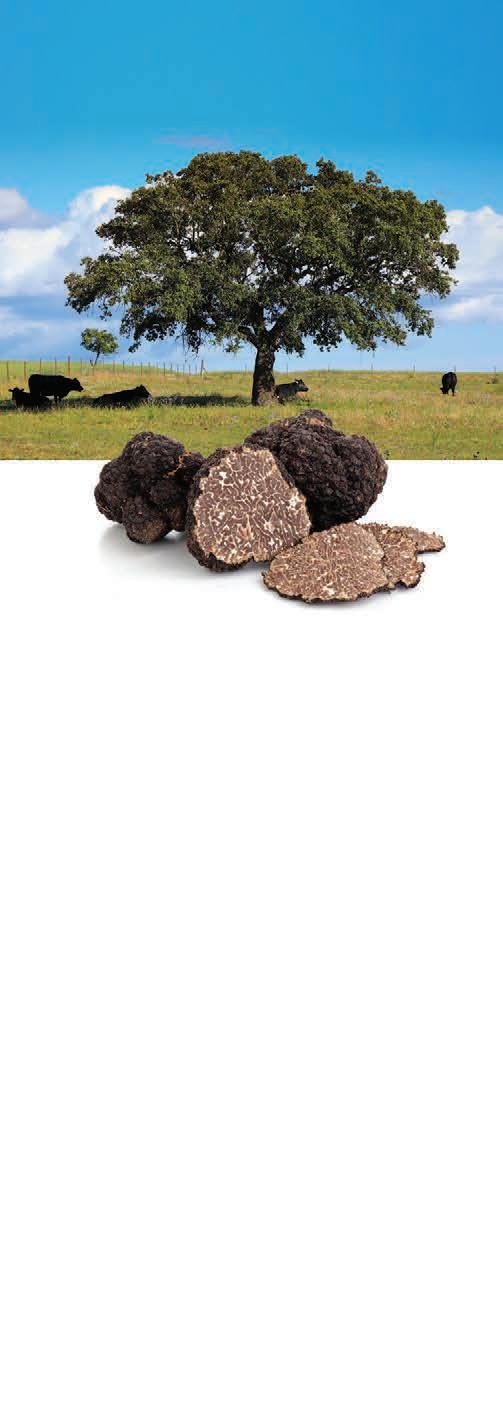
• First Right of Refusal offers potential for longer term relationship with compatible Tenant
• Possibility of 1200ha adjoining property becoming available for lease in 2025
• Joint inspections proposed 1pm Thursday 18 April and Thursday 2 May Information pack with basic lease terms & conditions, proposal requirements and inspection details available from: Geoff Burton Farm Business Management

Independent Director
Passion, integrity, and a genuine desire to do our best for farmers is what drives us at Beef + Lamb New Zealand (B+LNZ). We are 100% farmer-owned and funded and work on behalf of New Zealand’s sheep and beef producers. Our vision is for thriving sheep and beef farmers, now and into the future. Beef + Lamb New Zealand’s investments play a critical role in underpinning New Zealand’s second biggest export sector.
The Independent Director position will bring independent judgement, outside experience, and objectivity to the board table. We want to strengthen the board in key areas of Māori Agribusiness and Information Technology. The successful candidate will have proven experience in governance and be committed to a successful and thriving New Zealand sheep and beef sector, be collaborative in nature, possess sound judgment and be willing to demonstrate strong leadership to the sector, and B+LNZ management.
The qualities and skills we are looking for are:
• Close connection to sheep and beef farmers and their rural communities.
• Independence in thinking; be prepared to challenge and be challenged.
• Be future-focused, value continuous improvement, innovation and responsiveness to the sector’s challenges and opportunities.
• Proven and effective governance and/or executive level expertise, strategic planning and execution.
• Effective, persuasive and respectful communicator.
• A role model for the values of the organisation.
This is a remunerated position and will commence 1 July 2024 and is for a three-year term. The commitment required will be approximately three days per month.
For further information, contact Bridget McIlraith, B+LNZ People & Culture Manager on bridget.mcilraith@beeflambnz.com or 027 220 7789.
Please apply via the B+LNZ job site: https://beeflambnz.com/about-blnz/work-for-us Applications close 5pm Monday 6 May.
LK0118429©
It grows under them. CORK OAK TRUFFLE
loss of grazing land. Stock protector options are available for cattle, sheep & deer. Fantastic stock feed which is low tannin and high in carbohydrates. Produces up to 1 ton of acorns per tree each year. Extremely resilient. Fire resistant, stabilises erosion, frost & snow resistant to -9 degrees. Drought & heat tolerant over 40 degrees. Add value far into the future. Trees last over 200 years. Cork harvest income at year 25, then every 10 years. Potential carbon credits at 30% with a minimum 1ha canopy cover. For tree availability call 021 327 637 or visit truffles.nz LK0118466©
ATTRACTIVE LEASE OPPORTUNITY
Taumarunui
LK0118305© Heavy duty, long lasting incinerators Three sizes available Phone 021 047 9299 irontreeproducts.co.nz LK0117142© To find out more visit www.mowermaster.co Phone 028 461 5112 Email: mowermasterltd@gmail.com Topper / Finishing Mower Genuine 11.5HP Briggs & Stratton Motor. Electric start. Belt driven. Cutting Height 30mm - 300mm LK0118355© $4200 $3900 GST INCLUSIVE MOWER MASTER TOWABLE MOWERS APRIL SPECIAL Find primary sector vacancies at: farmersweeklyjobs.co.nz To advertise phone Julie 027 705 7181 LK0117420© Jeenks Group Ltd - www.jeenksgroup.com 33 Marketplace FARMERS WEEKLY – farmersweekly.co.nz – April 22, 2024 Marketplace 33 Advertise with us
every farmer in New Zealand every week
Julie 027 705 7181
Phone 07 895 8052 gtb@xtra.co.nz
Reach
Call

The Forest Growers Levy Trust is conducting a national round of meetings to discuss the proposal to renew the Forest Growers Levy for 2026 to the end of 2031.
Come along to your local meeting to hear what is proposed and have your views heard.

The meetings scheduled for next week are:






WE OFFER
100 ANGUS BREEDING COWS of four age groups
Available to share farm, graze, or wanting a lease property in the South Island


• This is your chance to gain some pure breed Angus genetics. Size of mob can be tailored to suit.
• Very quiet temperament, foothill bred, with consistent calf growth rates.
• Calving starts 6th September.
• As owners we will provide sire bulls, transport, a proportion of animal health costs, and share of labour.
These girls have become available due to farm sale and change of farming practice. All we are asking is a chance to retain these girls and share the reason they are worth holding on to. This is your opportunity to build some breeding stock or retain fattening cattle as you desire, without any cash outlays.
A suitable tailored agreement to meet the specific needs of both parties can be discussed further, confidentiality assured. If you have a lease possibility, then we would very much like to hear from you. Any enquiry of interest would be appreciated sooner rather than later. Please phone/txt

LK0118340©
di.tim@farmside.co.nz OFFERING:
fully recorded stud 34 MPlace-Livestock
1 x 6 foot bale
2m diameter
15 feed positions
15 - 30 animals $1100
Tim 022 077 0040 Email
140
Marketplace 34 Livestock •
•
•
•
Nelson/Marlborough Dates Town Time Address Tue 23 April Nelson 10.30am Putangitangi Greenmeadows, cnr Main Road and Songer St, Stoke Tue 23 April Blenheim 3.30pm Emergency Management Rooms. 4 Wither Rd Wed 24 April Hanmer 11am Hanmer Springs Retreat, 35 Hanmer Springs Rd For more information
LEVY VOTE 2024 Forest Growers FOREST GROWERS LEVY VOTE 2024 LK0118436© DOLOMITE For a delivered price call .... NZ’s finest BioGro certified Mg fertiliser 0800 436 566 ATTENTION FARMERS ZON BIRDSCARER electro-tek@xtra.co.nz Phone: 06 357 2454 ELECTRO-TEK ENGINEERING FLY OR LICE problem? Electrodip – the magic eye sheepjetter since 1989 with unique self adjusting sides. Incredible chemical and time savings with proven e ectiveness. Phone 07 573 8512 www.electrodip.com ANIMAL HANDLING BALAGE FOR SALE ROUND BALES - Baled December 2022. Excellent quality. $90/bale excl GST. Located Maraekako SH50 Hawke’s Bay. Phone 027 4863 906. GOATS WANTED. All weights. All breeds. Prompt service. Payment on pick up. My on farm prices will not be beaten. Phone David Hutchings 07 895 8845 or 0274 519 249. Feral goats mustered on a 50/50 share basis. GOATS WANTED GRAZING AVAILABLE TOP GRAZING AVAILABLE. All at farm, Hauraki Plains West. Experienced in grazing top heifers. Inspection welcome. Phone 027 244 7939. HAY/BALAGE FOR SALE HAY SQUARE AT $75, Rounds at $85 plus GST. Wheat and barley straw available now. BALAGE EXCELLENT QUALITY, $75 per bale plus GST. Unit loads available for hay and balage. Phone 021 455 787. NZ KELP. FRESH, wild ocean harvested giant kelp. The world’s richest source of natural iodine. Dried and milled for use in agriculture and horticulture. Growth promotant / stock health food. As seen on Country Calendar. Orders to: 03 322 6115 or info@nzkelp.co.nz HORTICULTURE HIGH PRESSURE WATER PUMPS, suitable on high headlifts. Low energy usage for single/3-phase motors, waterwheel and turbine drives. Low maintenance costs and easy to service. Enquiries phone 04 526 4415, email sales@hydra-cell.co.nz PUMPS WILTSHIRES-ARVIDSON. Self shearing sheep. No1 for Facial Eczema. David 027 2771 556. RAMS FOR SALE SHEEP SCANNING AVAILABLE SERVICING SOUTH WAIKATO. King Country, Ruapehu, Taihape areas. Experienced operator. EID and Foetal Ageing. Phone 027 479 4918. STOCK FEED SILAGE BALES for sale. 10 bale equivalent, Otorahanga based. Enquiries please phone 027 471 3856. SAWN SHED TIMBER including Black Maire. Matai, Totara and Rimu etc. Also buying salvaged native logs. Phone Richard Uren. NZ Native Timber Supplies. Phone 027 688 2954. WANTED TO BUY Advertise with us Call 0800 85 25 80 wordads@agrihq.co.nz Advertise with us Reach every farmer in New Zealand every week Call Andrea 027 602 4925 FOR ONLY $3.30 + gst per word you can book a word only ad in Farmers Weekly Classi eds. Phone 0800 85 25 80. WORD ONLY ADVERTISING. Phone 0800 85 25 80.
go to https://fglt.org.nz
Dave was bragging to his boss one day, “You know, I know everyone there is to know. Just name someone, anyone, and I know them.”
Tired of his boasting, his boss called his bluff, “OK, Dave, how about Tom Cruise?”
“No drama boss, Tom and I are old friends, and I can prove it.” So Dave and his boss fly out to Hollywood and knock on Tom Cruise’s door, and Tom Cruise shouts,
“Dave! What’s happening? Great to see you! Come on in for a beer!”
Although impressed, Dave’s boss is still skeptical. After they leave Cruise’s house, he tells Dave that he thinks him knowing Cruise was just lucky.
“No, no, just name anyone else,” Dave says. “President Obama,” his boss quickly retorts. “Yup,” Dave says, “Old buddies, let’s fly out to Washington,” and off they go.
At the White House, Obama spots Dave on the tour and motions him and his boss over, saying, “Dave, what a surprise, I was just on my way to a meeting, but you and your friend come on in and let’s have a beer first and catch up.”
Well, the boss is very shaken by now but still not totally convinced. After they leave the White House grounds he expresses his doubts to Dave, who again implores him to name anyone else. “Pope Francis,” his boss replies.
“Sure!” says Dave. “I’ve known the Pope for years.” So off they fly to Rome.
Dave and his boss are assembled with the masses at the Vatican’s St. Peter’s Square when Dave says, “This will never work. I can’t catch the Pope’s eye among all these people. Tell you what, I know all the guards so let me just go upstairs and I’ll come out on the balcony with the Pope.” He disappears into the crowd headed towards the Vatican.
Sure enough, half an hour later Dave emerges with the Pope on the balcony, but by the time Dave returns, he finds that his boss has had a heart attack and is surrounded by paramedics.
Making his way to his boss’ side, Dave asks him, “What happened?”
His boss looks up and says, “It was the final straw... you and the Pope came out onto the balcony and the man next to me said, ‘Who the heck is that on the balcony with Dave?’




• 58 Friesian/Friesian X R1yr Heifers, BW 314, PW
Freephone 0800 10 22 76 | w w w.pggwrightson.co.nz Helping grow the countr y Key: Dair y Cattle Sheep O ther Tuesday 23 April | 11.30am Approx 2000 Weaners: • 1150 Traditional steers • 100 Exotic steers • 50 Exotic bulls • 550 Traditional heifers • 200 Exotic heifers Annual Lines: B&C Berkahn P/Ship, B&E Besley, SG&LM Bradley, I Cummings, Stewart Eames, RP Erni, PDJ&PJ Erni, Hillview Grazing Ltd, Russell Johnson, Kilmister Farms Ltd, Lochlinnhe, Ngatiapa Farm, F&S Pritchard, Pukeko Land Co, Hayden Tapp, Tapuae Ltd, Frew Family P/ Ship, Lowery Farms, A&SK Knight, B McDougal, G Rowe, H&C P/Ship, JE&MF Ward, Dixie McCarthy, Onawe Farm, Chrosshills Station, KW&R Best, Ohukia Trust, J&R Batley, Arapata Holdings Renfield Farm P/ Ship, DW Contracting For more details please contact: Maurice Stewart 027 246 9255 Tony Gallen 027 590 1711 FEILDING WEANER FAIR FEILDING SALE YARDS Tuesday 30 April | 11am Te Awamutu Saleyards, Paterangi Road A/C C & D Perrott Comprising: 80 Inmilk Autumn Calved Jersey Cows, BW 344, PW 298 40 Incalf Spring Calving Jersey Cows BW 344, PW 334 These high producing cows become available as the Perrott’s are shifting this season and there is no winter milk collection There is also all the spring content of cows purchased last season from different highprofile sales Many of the cows on offer have production in excess of 600MS Great opportunity to purchase quality Jersey cows that come forward in great condition and have been bred for longevity and type Cows can go back to vendors farm if transport needs to be arranged out of the area at the purchaser’s expense Catalogues available on AgOnline and Bidr Enquiries: Phil Martin 027 648 6711 Andrew Reyland 027 223 7092 LINDSAY PARK AUTUMN HERD DISPERSAL AND HIGHPROFILE SPRING CONTENT SALE Monday 29 April | 10.00am Machinery | 11.00am Livestock On Farm – 747 Puketarata Road, Otorohanga Dairy # - 74376 A/C Grant & Karen Brierley Comprising: 250 Friesian/Friesian X Incalf Cows, BW 245, PW 272 RA 100% (Inc 10 Incalf Carryover Cows) • 11 Friesian/Friesian
BW
X Inmilk MT Cows,
208, PW 234
• 81 Friesian/Friesian X R2yr Incalf Heifers, BW 303, PW 310
304 Our vendors have instructed us to offer at auction, their outstanding Friesian/Friesian X herd, Carryovers, and all heifer replacements They have not been offered for sale in the paddock
up to 435, PW up to 926 Grant & Karen have used nominated semen for the last 10 years focusing on type, udders, and production This herd consistently produces 450 MS/Cow and 1240 MS/HA on a system 3 Calving from 15 July to 20 September using 100% AI Friesian, and some Hereford and Short Gestation Cows scanned to dates Ave SCC 140,000, TB Status C10, BVD Negative, EBL Free, Herringbone shed Incalf Heifers very well grown and are calving from 15 July to Jersey bulls, Bulls out 15 December R1yr Heifers are extremely well grown and outstanding for size
you want a commercial cow with the quality of a pedigree, then this sale is not to be missed Machinery | 10 00am Visit www agonline co nz/upcomingsales for full machinery details For more information contact: Shay Egan 027 473 5856 Andrew Reyland 027 223 7092 OUTSTANDING FRIESIAN/FRIESAN X COMPLETE DISPERSAL AUCTION NZ’s Virtual Saleyard | bidr.co.nz NZ’s Virtual Saleyard bidr.co.nz Sheep Wanted for Lice Testing Replacement Ewe Hoggets
LK0118353© 801 Raetihi Road, Ohakune. 12 Noon Start Thursday 16th May 2024 ANNUAL BULL SALE John & Helen Hammond | Ph 06 3858 040 John 0274 314 992 027 319 2581 Email john_helen@xtra.co.nz www.ruaview.com Ruaview Monty 220017 Ruaview Knockout 2232 Advertise with us We wish to advise that due to the ANZAC Day public holiday, advertising deadlines will move forward one business day. Contact your partnership manager for deadlines. LK0117696© FOR SALE R3&4YR Fries Cow s VIC Sim Bul l 17/01 200 MA Ang Co ws VIC Sim Bul l 17/01 40 days STOCK REQUIRED 250 Pere or Pere X M A Ewe s Male Entire Lambs 32-37kg R2YR Fries or Beef Bulls 330 -400kg R2YR Steers 400-440kg R2YR Fries Bulls 400-480kg R2YR Fries/Here Heifers/Steers 350 -420kg Phone Ross Dyer 0274 333 381 www dyerlivestock co nz A Financing Solution For Your Farm www rdlfina nce co nz 35 Livestock FARMERS WEEKLY – farmersweekly.co.nz – April 22, 2024
35
BW’s
If
– not in lamb Mobs of >300 On farm study All animals treated for lice This study would be at no cost to you with compensation for all yarding and handling costs. Enquiries to Sean Daly 027 332 3462 sda@donaghys.co.nz
Livestock
SALE TALK
Markets
Proudly sponsored by
Stream of calves mooves north to buyers
As the dry bit hard, South Island vendors found support and keen buyers across the strait for their crop of calves.
 AFiona Quarrie MARKETS Livestock
AFiona Quarrie MARKETS Livestock
S WE cruised through spring and this season’s crop of calves were hitting the ground, it was hard to believe that forecasters’ warnings of a dry summer caused by El Niño would come to pass.
In hindsight, the excess of feed was also a warning. As many will say, nature always provides and if there is surplus at one point, you will need it later.
It was February 9 when the first beef calves from Seddon started heading north to the Feilding saleyards. Larger groups made the trip in the following two weeks. This was just the start of the trend that saw multiple, early, uncalendared sales throughout the South Island held to relieve the pressure.
These early sales often produce strong results and Joe Higgins, Mid South Canterbury Livestock Manager for PGG Wrightson, expected it to only be downhill from there, especially as the dry held on.
It has been a pleasant surprise, then, to see the market rebound slightly through the middle of the season.
It would be fair to assume that the early sales would have poached numbers from further sales to produce an overall similar number of calves. This has not eventuated, and Higgins puts this down to the dry, too.
For those who would usually
hold onto calves through winter and sell on the spring market, a lack of feed has wiped this from the plans.
“There seemed to be more heifers come out too,” Higgins said, “because they don’t have the feed to cart them through.”
While this is the main driver, in a tough economic climate the need for some cashflow also contributed.
Looking at Coalgate, Canterbury Park and Temuka, the current running total plus last years’ tallies for the two High Country calf sales to come, the final number will look something like 18,500-head just at these three yards. This is 4000-head above last year’s total.
It is worth noting that some normal vendors of the Coalgate High Country calf sale sold earlier due to the dry conditions.
The beauty of the beef cow is that even under trying conditions she is good at feeding her calves.
There has been some decline in the average weight in the yards, but this is to be expected, especially in comparison to the good growing season last year.
Higgins noted that this was particularly noticeable at the top end of well-known annual consignments. He pointed out that by the same token “we can’t expect weights to keep going up each year either”.
Looking at Angus steers and heifers as a benchmark, average weights for steers are back just 5kg to 220kg and heifers slightly more at 197kg, 10kg lighter.
All these extra calves hitting the
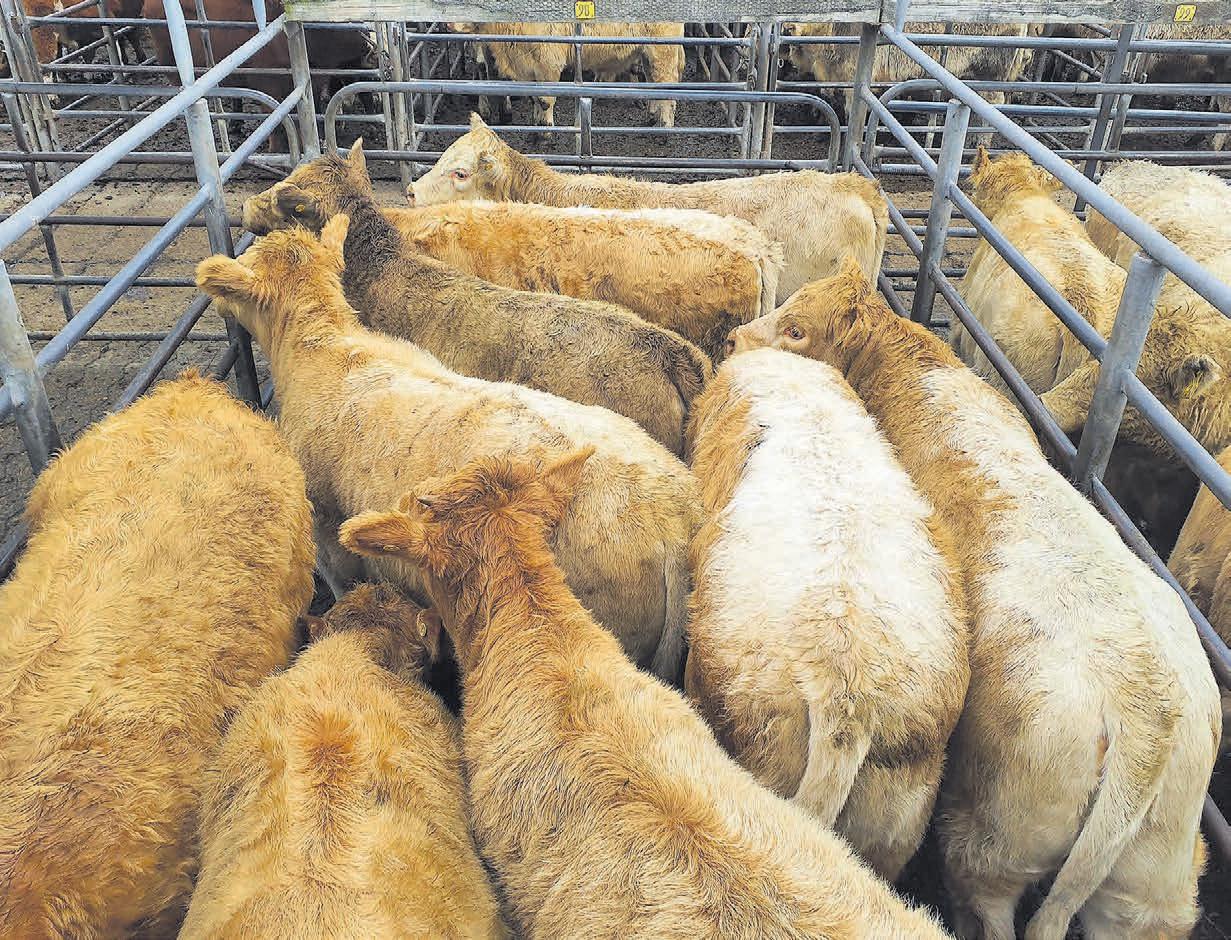
The beauty of the beef cow is that even under trying conditions she is good at feeding her calves.
market in a tough season for grass was never going to have a positive impact on returns. Across the South Island, Angus steer calves have averaged $813, or $3.70/kg. This is back $82 and 28c/kg on last year.
In the heifer camp, the average return is $579, which is back a massive $115 on last year and
shows the impact of increased supply. On a per kilogram basis, this comes out at $2.94/kg, back 42c/kg on 2023.
A lot of this comes down to demand, and where it is coming from.
There has been some buying power from Southland, though on a small scale. An Invercargillbased buyer took a selection of calves home from Canterbury Park last week.
It is common knowledge that North Island buyers have played a very active role in calf sales, more so than in previous years.
The contrast in schedules, feed
and moisture between the north and the south is the driver for this.
Last Wednesday at Temuka’s Fairlie Basin sale there were three North Island buyers underpinning the market.
While price is a major factor, Higgins commented that “they seem to like our calves for whatever reason”.
The consensus among vendors and agents is that they are very grateful for this support and without it our South Island beef breeders would be hurting, significantly more than they already are.


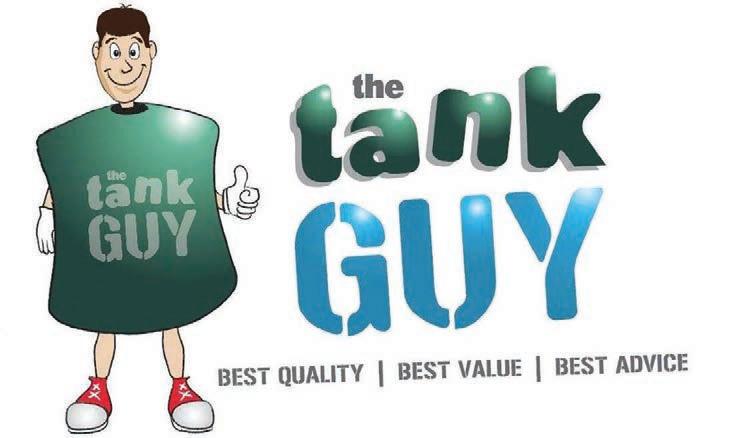



WATER TANKS, PUMPS & FILTRATION Call now for a better deal P: 0508 326 8888 30 Turners Road, Feilding thetankguy.co.nz DEVAN • RX • CALPEDA • AQUA • OASIS CLEARWATER LK0117767© | BEST QUALITY | BEST PRICE | BEST ADVICE 36 Markets
TAKING THE CAKE: Charolais heifers have often held up better than their traditional sisters this year. These Charolais-cross at Temuka in the Fairlie Basin sale were no exception and they fetched $1010 at 326kg, $3.10/kg.
Markets
Weekly saleyards
Some decent rain through Manawatū was just what the farmer ordered. What started out as a sprinkle turned into a soaking downpour and relief for lamb finishers. Those who purchased lambs at the April 12 sale at Feilding had to pay a bit more than the previous week, particularly for ewe lambs, but they will likely be glad they did. At this sale, ewe lambs averaged $75 at 30kg and males $82 at 33kg. The east coast hasn’t been as lucky on the rain front and at Stortford Lodge ewe lambs averaged $68 at 30kg.
37
Pukekohe | April 13 $/kg or $/hd R2 heifers 2.80-2.90 Weaner steers and heifers 610-830 Prime steers 2.90-2.93 Prime heifers 2.78-2.85 Store ewes 37-98 Store lambs 30-88 Tuakau | April 11 | 520 cattle $/kg or $/hd R3 Hereford-Friesian steers, 522-595kg 2.79-3.01 R2 Hereford-Friesian steers, 310-377kg 3.42-3.67 R2 Hereford-Friesian heifers, 405-456kg 2.87-2.94 Weaner dairy-beef steers, 160-209kg 750-850 Weaner dairy-beef heifers, 154-198kg 580-650 Rangiuru | April 16 | 356 cattle, 95 sheep $/kg or $/hd R2 dairy-beef steers, 307-472kg 2.76-2.91 Weaner Hereford-Friesian steers, 173-196kg 745-760 Prime steers, 585-618kg 2.98-3.03 Boner Friesian cows, 491-530kg 1.74-1.88 Store lambs, all 59-80 Frankton | April 16 | 746 cattle $/kg or $/hd Mixed-age Angus cows, 555-622kg 2.47-2.64 R2 beef, dairy-beef steers, 451-515kg 3.01-3.15 R2 dairy-beef steers, 382-443kg 3.25-3.30 R2 Hereford, beef-Friesian heifers, 341-404kg 2.84-3.04 Weaner Hereford, Hereford-Friesian steers, 202-286kg 910-965 Weaner Friesian bulls, 205-240kg 3.60-3.63 Prime Hereford-Friesian steers, 576-660kg 2.97-3.03 Prime beef-cross heifers, 500kg average 2.86 Boner Friesian, Friesian-cross cows, 461-509kg 1.80-2.05 Frankton | April 17 | 205 cattle $/kg or $/hd R2 dairy-beef, Friesian steers, 445kg average 2.95 R2 dairy-beef heifers, 376-426kg 2.81-2.91 Weaner exotic-Friesian bulls, 215-243kg 740-780 Weaner dairy-beef, Friesian bulls, 151-173kg 570-615 Weaner dairy-beef heifers, 151-186kg 530-620 Prime dairy-beef steers, 575-670kg 2.90-3.03 Prime Hereford-Friesian heifers, 477-533kg 2.91-2.95 Boner Friesian, Friesian-cross cows, 462-563kg 1.81-1.92 Boner crossbred cows, 407-440kg 1.70-1.78 Matawhero | April 12 | 2156 sheep $/kg or $/hd Store male lambs, good to heavy 90.50-114.50 Store ewe lambs, medium to good 56-80 Prime ewes, medium to good 52-70 Prime lambs, heavy 100-136 Prime lambs, medium 74-90 Matawhero | April 16 | 799 cattle $/kg or $/hd Mixed-age exotic-cross cows, RWB, 375-470kg 740-1000 R3 traditional, exotic-cross steers, 397-515kg 3.00-3.17 R2 traditional heifers, most, 350-439kg 2.73-2.88 Weaner traditional steers, 237-294kg 850-1000 Weaner bulls, 201-330kg 750-950 Weaner traditional heifers, 179-193kg 470-500 Weaner exotic heifers, 222-277kg 600-790 Taranaki | April 17 | 430 cattle $/kg or $/hd R2 Hereford-Friesian steers, 387-430kg 3.11-3.21 R2 dairy-beef heifers, most, 400-480kg 2.81-2.90 Weaner dairy-beef steers, 117-182kg 550-760 Weaner Friesian bulls, 165-206kg 560-690 Weaner dairy-beef heifers, 170-238kg 500-620 Boner Friesian cows, 510-581kg 1.61-1.74 Stortford Lodge | April 15 | 812 sheep $/kg or $/hd Prime ewes, heavy to very heavy 81-94 Prime ewes, medium to good 61-80 Prime ewes, light 38-56 Prime lambs, heavy 125-140 Prime lambs, medium 101.50-121 Stortford Lodge | April 17 | 2160 sheep $/kg or $/hd Store male and ewe lambs, heavy 89.50-113 Store male lambs, medium to good 68-89 Store ewe lambs, good 73.50-88.50 Store ewe lambs, small to medium 40-68 Dannevirke | April 11 | 617 sheep $/kg or $/hd Store cryptorchid lambs 70-100 Store ewe lambs 75-92.50 Prime ewes, all 20-62.50 Prime lambs, all 41-132.50 Feilding | April 12 | 604 cattle, 7345 sheep $/kg or $/hd R3 Angus steers, 547-622kg 3.22-3.33 R2 traditional steers, 463-547kg 3.08-3.16 R2 dairy-beef heifers, 355-498kg 2.79-2.87 Store male lambs, heavy 100.50-110 Store male lambs, shorn, good 70-94 Store ewe lambs, shorn, good 69-95 Store ewe lambs, medium 63.50-81 Feilding | April 15 | 248 cattle, 1390 sheep $/kg or $/hd Prime Angus, Shorthorn cows, 500-544kg 1.72-2.01 Prime Angus, Hereford-Friesian heifers, 545-550kg 2.88-3.06 Boner Friesian cows, 466-581kg 1.62-1.86 Boner Jersey, Jersey-cross cows, 436-480kg 1.39-1.59 Prime ewes, good 50-94 Prime ewes, medium-good 41-49 Prime mixed-sex lambs, heavy to very heavy 100-161 Prime mixed-sex lambs, medium to good 71-98 FARMERS WEEKLY – farmersweekly.co.nz – April 22, 2024
37
See what sold today REPORTS EYE LIVESTOCK Results from the saleyards, including per kilo prices for store lambs, delivered straight to your inbox. Subscribe from only $35* per month agrihq.co.nz/livestock-reports * Prices are GST exclusive 38 FARMERS WEEKLY – farmersweekly.co.nz – April 22, 2024 Markets 38 Coalgate | April 11 | 4397 sheep $/kg or $/hd Mixed-age ewes, all 70-101 Store crossbred, terminal-cross lambs, good 60-96 Store crossbred, terminal-cross lambs, medium 38-72 Store Halfbred lambs, medium 50-67 Prime ewes, medium to good 49-77 Prime lambs, very good 116-135 Canterbury Park | April 16 | 141 cattle, 1799 sheep $/kg or $/hd Prime traditional cows, 500-752kg 1.61-1.77 Prime dairy-beef steers, 507-595kg 2.58-2.80 Prime beef heifers, 466-595kg 2.58-2.71 Store mixed-sex lambs, woolly, good 60-75 Store mixed-sex lambs, shorn, good 72-96 Prime ewes, good 64-74 Prime lambs, heavy to very heavy 127-145 Temuka | April 15 | 815 cattle, 6055 sheep $/kg or $/hd Prime Hereford-Friesian (black) steers, 495-640kg 2.65-2.82 Prime Hereford-Friesian heifers, 438-575kg 2.51-2.73 Boner Friesian cows, 489-676kg 1.38-1.62 Boner crossbred cows, 461-593kg 1.40-1.57 Store male lambs, heavy 93-121 Store mixed-sex lambs, good 66-90 Prime ewes, most 61-86 Prime mixed-sex lambs, most 100-139 Charlton | April 11 | 372 sheep $/kg or $/hd Store lambs, all 73-80 Prime ewes, all 31-70 Prime lambs, all 74-129 Lorneville | April 16 $/kg or $/hd Prime cows, 500-550kg 1.15-1.28 Prime steers, 450kg 2.50-2.60 Prime dairy heifers, 300-400kg 1.20-1.90 Store lambs, all 50-100 Prime ewes, all 36-81 Prime lambs, all 95-141 Beef Weaner Fairs | April 11 - April 17 Kaikohe | April 17 | 828 cattle $/kg or $/hd Weaner traditional, exotic steers, 220-376kg 780-1135 Weaner dairy-beef, exotic-cross steers, 128-217kg 500-710 Weaner beef-cross bulls, 260-425kg 950-1210 Weaner dairy-beef, exotic-cross bulls, 118-238kg 540-790 Wellsford | April 15 | 747 cattle $/kg or $/hd Weaner Angus steers, 276-334kg 860-1040 Weaner Red Devon steers, 180-227kg 615-730 Weaner Hereford-Friesian steers, 132-297kg 710-1020 Weaner Friesian bulls, 152-192kg 640-710 Te Kuiti | April 11 | 1107 cattle $/kg or $/hd Weaner traditional steers, 236-341kg 945-1270 Weaner traditional steers, 143-230kg 680-935 Weaner exotic, exotic-beef steers, 214-323kg 870-1200 Te Kuiti | April 12 | 1022 cattle $/kg or $/hd Weaner traditional heifers, 217-310kg 715-1020 Weaner traditional heifers, 144-214kg 510-745 Weaner exotic-beef heifers, 170-303kg 550-950 Taupo | April 15 | 673 cattle $/kg or $/hd Weaner traditional steers, 184-301kg 750-1140 Weaner dairy-beef, exotic-cross steers, 154-280kg 635-1060 Weaner traditional bulls, 260-352kg 1040-1300 Weaner Friesian bulls, 160-202kg 620-820 Weaner traditional, dairy-beef heifers, 153-288kg 550-935 Weaner exotic-cross heifers, 193-290kg 640-910 Stortford Lodge | April 16 | 991 cattle $/kg or $/hd Weaner Angus steers, 275-279kg 980-1005 Weaner Angus steers, 220-221kg 830-845

“ I read it, and the value for me from the provincial president angle is we can get our messages out there and reach all farmers.”
David
Hayes Federated Farmers Wairarapa president
LK0118207© 39 FARMERS WEEKLY – farmersweekly.co.nz – April 22, 2024 Markets 39 Weaner Angus & Angus-Hereford steers, 168-278kg 680-1040 Weaner Simmental-beef steers, 171-261kg 640-910 Stortford Lodge | April 17 | 962 cattle $/kg or $/hd Weaner traditional bulls, 185-279kg 700-1000 Weaner traditional heifers, 206-291kg 655-835 Weaner Angus heifers, 157-201kg 520-640 Weaner Charolais heifers, 234-295kg 780-890 Weaner Simmental-beef heifers, 217-283kg 715-880 Sue Brothers | April 17 | 797 cattle $/kg or $/hd Weaner traditional steers, 257-319kg 1100-1340 Weaner traditional steers, 215-250kg 950-1145 Weaner traditional steers, 128-174kg 480-790 Weaner traditional heifers, 222-285kg 790-955 Weaner traditional heifers, 100-106kg 250-770 Coalgate | April 11 | 1244 cattle $/kg or $/hd Weaner Angus steers, 230-279kg 880-1020 Weaner traditional steers, 215kg average 795 Weaner exotic-beef steers, 198-287kg 700-1020 Weaner traditional heifers, 201-298kg 550-800 Weaner exotic-beef heifers, 170-242kg 510-725 Canterbury Park | April 17 | 1612 cattle $/kg or $/hd Weaner traditional steers, 244-344kg 800-1220 Weaner traditional steers, 143-240kg 530-840 Weaner exotic-beef steers, 183-300kg 610-960 Weaner Charolais-cross heifers, 183-239kg 570-745 Weaner traditional, exotic-cross heifers, 145-304kg 430-820 Temuka | April 17 | 1823 cattle $/kg or $/hd Weaner Angus steers, 151-172kg 585-650 Weaner Simmental-cross steers, 196-233kg 674-790 Weaner Angus heifers, 133-161kg 470-515 Weaner Simmental-cross heifers, 201-253kg 535-745 Oamaru |April 11 | 971 cattle $/kg or $/hd Weaner traditional steers, 172-277kg 620-960 Weaner exotic-beef steers, 169-316kg 605-1080 Weaner Hereford bulls, 168-313kg 585-1040 Weaner traditional heifers, 162-284kg 510-815 Weaner exotic-beef heifers, 168-303kg 485-910 Palmerston | April 12 | 1440 cattle $/kg or $/hd Weaner traditional steers, 234-306kg 855-1120 Weaner traditional steers, 141-222kg 530-790 Weaner Simmental-Hereford steers, 199-281kg 710-990 Weaner traditional heifers, 139-289kg 470-800 Weaner Simmental-beef heifers, 185-281kg 530-810 Castlerock | April 11 | 831 cattle $/kg or $/hd Weaner traditional steers, 207-298kg 760-1060 Weaner exotic, exotic-beef steers, 239-340kg 870-1200 Weaner traditional heifers, 163-280kg 520-830 Feeder calves | April 15 - April 16 Frankton | April 16 | 1024 cattle $/kg or $/hd Friesian bulls, small to good 150-300 Hereford-Friesian bulls, small to good 155-370 Exotic-Friesian bulls, small to good 190-365 Hereford-Friesian (black) heifers, small to good 140-230 Hereford-Friesian (red), Angus-Friesian heifers, small to good 50-205 Exotic-Friesian heifers, small to good 140-230 Feilding | April 15 | 75 cattle $/kg or $/hd Friesian bulls, small to good 60-150 Hereford-Friesian (black) bulls, medium to good 190-320 Exotic-Friesian bulls, small to good 80-320 Hereford-Friesian, exotic-Friesian bulls, small to good 40-150
AgriHQ market trends
Cattle Sheep Deer
Fertiliser Forestry
40 FARMERS WEEKLY – farmersweekly.co.nz – April 22, 2024 Markets 40
Meat Slaughter price (NZ$/kgCW) Last week Last year North Island lamb (18kg) 6.15 7.35 North Island mutton (25kg) 2.70 4.25 South Island lamb (18kg) 5.90 7.20 South Island mutton (25kg) 2.50 4.20 Export markets (NZ$/kg) China lamb aps 8.63 11.62 Wool (NZ$/kg clean) 12-Apr Last year Crossbred eece 3.08 2.75 Crossbred lamb 2.98 2.71 Courtesy of www.fusca.co.nz Beef Slaughter price (NZ$/kgCW) Last week Last year North Island P2 steer (300kg) 5.90 6.00 North Island M2 bull (300kg) 5.90 5.90 North Island M cow (190kg) 4.00 3.95 South Island P2 steer (300kg) 5.35 5.40 South Island M2 bull (300kg) 5.35 5.30 South Island M cow (190kg) 3.40 3.35 Export markets (NZ$/kg) US imported 95CL bull 10.76 10.07 US domestic 90CL cow 12.67 9.71 Venison Slaughter price (NZ$/kgCW) Last week Last year North Island AP stag (60kg) 8.60 8.80 South Island AP stag (60kg) 8.50 8.80 Fertiliser NZ average (NZ$/tonne) Last week Last year DAP 1187 1594 Super 474 442 Urea 897 1135 Urea (Coated) 946 1184 Exports NZ Log Exports (tonnes) Feb Last year China 2,080,903 1,501,228 Rest of world 2,213,767 193,790 Carbon price (NZ$/tonne) Last week Last year NZU 52.1 62.5
Sheep
Steer slaughter price ($/kgCW) Lamb slaughter price ($/kgCW) NZ lamb average export value (NZ$/kg) Stag Slaughter price ($/kgCW) NZ beef average export value (NZ$/kg) Data provided by
Get ahead of the market Take advantage of New Zealand’s most trusted independent agricultural market data reporting and analysis, with a range of insightful agriculture and forestry reports. Subscribe from only $100 per month agrihq.co.nz/our-industry-reports 5.0 5.5 6.0 6.5 Apr Jun Aug Oct Dec Feb North Island South Island 5.5 6.0 6.5 7.0 7.5 8.0 Apr Jun Aug Oct Dec Feb North Island South Island 8.0 8.5 9.0 9.5 10.0 Apr Jun Aug Oct Dec Feb North Island South Island 6.0 7.0 8.0 9.0 10.0 11.0 Sep Nov Jan Mar May Jul 5-yr ave Last year This year 8.0 10.0 12.0 14.0 Sep Nov Jan Mar May Jul 5-yr ave Last year This year
NOTE: Slaughter values are weighted average gross operating prices including premiums but excluding breed premiums for cattle.








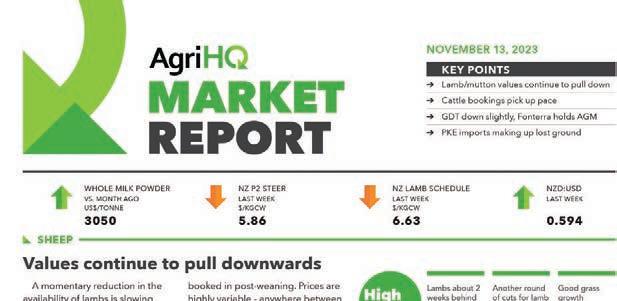

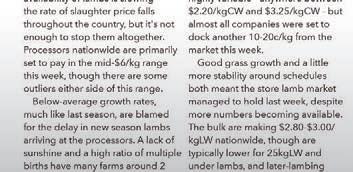






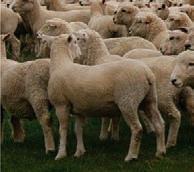





+64 6 323 6393 info@agrihq.co.nz agrihq.co.nz LOG PRICE REPORT MARCH 2022 EXPORT PRUNED A-GRADE P1 S1 PULP NZ$/JASM3 NZ$/JASM3 NZ$/TONNE NZ$/TONNE NZ$/TONNE 181 132 191 132 55.5 WHARFGATE LOG PRICES NZ$/JASm3 Weighted Average*, Delivered to Wharf Grade Export P A K KS KI KIS Pruning Pruned Unpruned Unpruned Unpruned Unpruned Unpruned SED (minimum) cm 40 30 40 22 20 - 26 26 10 Knot size (maximum) cm 0 10 15 15 15 25 No limit Length m 4.0 5.8 4.1 + 4.1 12.1 3.6 - 4.0 4.0 + 3.7 Northern North Island 183 134 126 124 116 115 124 122 115 111 125 123 116 113 116 115 107 102 123 121 113 105 118 117 109 103 124 122 115 111 -26% -26% -27% -29% -19% -19% -20% -21% -22% -23% -24%* Weightings are calculated on the volume of softwood logs traded through each port in the past 12 months, as indicated by available data. This month's report is weighted as follows; Port Weightings - +2 - - +0.5 Port(s) Regions Region Level Island Level National Level Marsden 33% 16% 13% Tauranga 67% 34% 27% Northern Nth Isl. - 51% 40% Gisborne/Napier 66% 33% 26% New Ply/Wellington 34% 17% 13% Southern Nth Isl. - 49% 39% North Island - - 80% Nelson/Picton 67% 43% 9% Lyttelton/Timaru 33% 21% 4% Northern Sth Isl. - 64% 13% P.Chalmers/Otago 61% 22% 5% Bluff 39% 14% 3% Southern Sth Isl. - 36% 7% South Island - - 20% +64 6 323 6393 info@agrihq.co.nz agrihq.co.nz LOG PRICE INDICATOR MARCH 2022 EXPORT PRUNED UNPRUNED PULP NZ$/TONNE NZ$/TONNE NZ$/TONNE NZ$/TONNE 117 184 119 56.0 105 110 115 120 125 Mar-17 Ten year NZ Combined Log Indicator ($/Tonne) 10 year average +1 - - +1 Log Indicator Trends FORESTRY MARKET REPORT ph S1 DOMESTIC LOGS (NZ$/TONNE) 132 A-GRADE EXPORT LOGS US$/JAS [CFR]) 150 SHIPPING – CHINA (US$/JAS) 47.2 CARBON (NZ$/NZU) 80.0 NZD:USD 0.672 FEBRUARY 2022 Omicron slows NZ production Wharfgate log prices firm Shipping starting to rise again Key Points VIEWPOINT -4 +14 -3.4 +4.7 +0.6C ...there's finally been a bit of life injected into log export markets. Reece Brick After a three-month price lull there's finally been a bit of life injected into log export markets. This largely comes from China getting back into the game after coming back from break, supported by mildly weaker shipping costs and the exchange rate. Reduced supplies out of NZ in recent months has been key for reengaging Chinese buying, particularly when other parts of the world aren't offering any more volumes than normal, usually noticeably less. Short-term we are unlikely to see much more upside than has already been reported. Shipping costs are starting to increase as of late-February due to a mixture of demand changes and increasing bunker costs partly brought on by the Russia-Ukraine situation. China wakes up Sara Hilhorst 12 mths ago 185 128 119 165 122 112 180 127 56 117 C d ti d h b t h b Mid-winter market s mellow VIEWPOINT 41 FARMERS WEEKLY – farmersweekly.co.nz – April 22, 2024 Markets 41 NZX market trends Company Close YTD HighYTD Low ArborGen Holdings Limited 0.1660.1730.147 The a2 Milk Company Limited 6.246.784.25 Comvita Limited 2.112.661.71 Delegat Group Limited 6.656.95.68 Fonterra Shareholders' Fund (NS) 3.63.73.34 Foley Wines Limited 0.951.20.95 Greenfern Industries Limited 0.0370.0580.034 Livestock Improvement Corporation Ltd (NS) 1.191.190.98 Marlborough Wine Estates Group Limited 0.1440.180.141 NZ King Salmon Investments Limited 0.260.3050.225 PGG Wrightson Limited 1.943.441.91 Rua Bioscience Limited 0.0690.1210.068 Sanford Limited (NS) 4.034.183.72 Scales Corporation Limited 3.23.49 3 Seeka Limited 2.92 3 2.42 Synlait Milk Limited (NS) 0.54 1 0.54 T&G Global Limited 1.81 2 1.73 S&P/NZX Primary Sector Equity Index 10448108089961 S&P/NZX 50 Index 118751210511571 S&P/NZX 10 Index 121361225411672 Close of market Listed Agri shares Grain Dairy Dairy Futures (US$/t) Nearest contract Last price* Prior week4 weeks prior WMP 324032803125 SMP 253025602630 AMF 685068506500 Butter 655065505750 Milk Price 7.867.847.84 * price as at close of business on Wednesday Data provided by Canterbury feed wheat ($/tonne) 5pm, Wednesday Milk price futures ($/kgMS) Canterbury feed barley ($/tonne) Waikato palm kernel ($/tonne) WMP futures - vs four weeks ago (US$/tonne) S&P/NZX 10 INDEX 12136 S&P/NZX PRIMARY SECTOR EQUITY 10448 S&P/NZX 50 INDEX 11875 Mar-12Mar-13Mar-14Mar-15Mar-16Mar-17Mar-18Mar-19Mar-20Mar-21Mar-22 56 56 MO HLY SHEEP BEEF KE POINTS JULY2022 US TE 95CL NZ SLAUGHTER TEE NA ORE NZ A E L B NZD:US 2.67 6.1 0 9.18 0.621 Cal and(relatively dercontroli the remain arisk butthere’ beennomajor Mid-winte llow Sentimen poorerfo exportsales Backlogsdevelopon lambs FMD theradarforAus/NZ 6.5 7.5 8.5 9.5 Apr JunAug Oct DecFeb Apr Sep-2024 Sep-2025 400 450 500 550 Apr JunAug Oct DecFeb Apr 400 450 500 550 Apr JunAug Oct DecFeb Apr 2950 3000 3050 3100 3150 3200 3250 3300 Apr May JunJulAug Latest price 4 weeks ago 300 350 400 450 Apr JunAug Oct DecFeb Apr
Still trying to shake that dry pattern

RAIN has fallen, but more is needed for those in the driest parts of New Zealand. Some regions still have a “late summer/early autumn” look to them despite the rain that has fallen so far this month.
El Niño has officially gone now – but autumn’s usual westerly driven weather means many may not notice an immediate change, and we’re still seeing eastern parts and northern parts of both main islands leaning drier.
Soil moisture deficit maps show the eastern half of Northland, the eastern side of Auckland, the Hauraki Plains, Coromandel Peninsula, much of Bay of Plenty, Gisborne, East Cape, Hawke’s Bay, eastern Manawatū, southern coastal Taranaki to Whanganui, Wairarapa, southern inland parts of Marlborough, and a decent chunk of Canterbury are all “thirsty”.
Some of these places are much drier than normal right now and need at least 100mm of rain
(preferably not in one day!) to change things.
Meanwhile, on the wetter side of the scale, the western side of Northland, western Waikato, King Country, the northern half of Taranaki, northern coastal Marlborough, Golden Bay/Tākaka, Southland and Central Otago all lean wetter than usual right now. In particular, Southland and King Country have both had heavy rain and showers in recent weeks.
This set-up means that, ideally, we need a rain event that comes in from the north or northeast. This would “fix” many of these dry areas.
Unfortunately the wet easterly flow is north of New Zealand, lining up with Brisbane and southern Queensland over the coming week. They have 100mm to 200mm possible, whereas in NZ some eastern areas have almost none in the next week due to more high pressure and westerly driven wet weather. However, the month of April does have some chances of ending wetter for NZ. As El Niño’s weather pattern continues to fade it will allow for much larger breaks in high pressure zones west of NZ. With the rain hitting Brisbane
this week, all it takes for that wet easterly to come into NZ is the high over the Tasman to be replaced by a southerly and the two flows can merge to spin a low.
Some long range modelling shows this – but I’m always nervous about locking in rain for those in need when it’s on the hunch of one long range computer model.
But still, the fact some models are picking it shows there is enough uncertainty in the atmosphere – a sign that the stubborn dry highs of El Niño may finally be breaking up to some degree in our part of the world.
The air is still fairly mild –there’s been a distinct lack of frosts so far, though a few over the past few days have popped up.
Highlights this week
• High pressure kicks off this week
• High pressure exits the country mid to late week, allowing for warm sub-tropical winds for many
• Possible large low for NZ in the final days of April (not locked in)

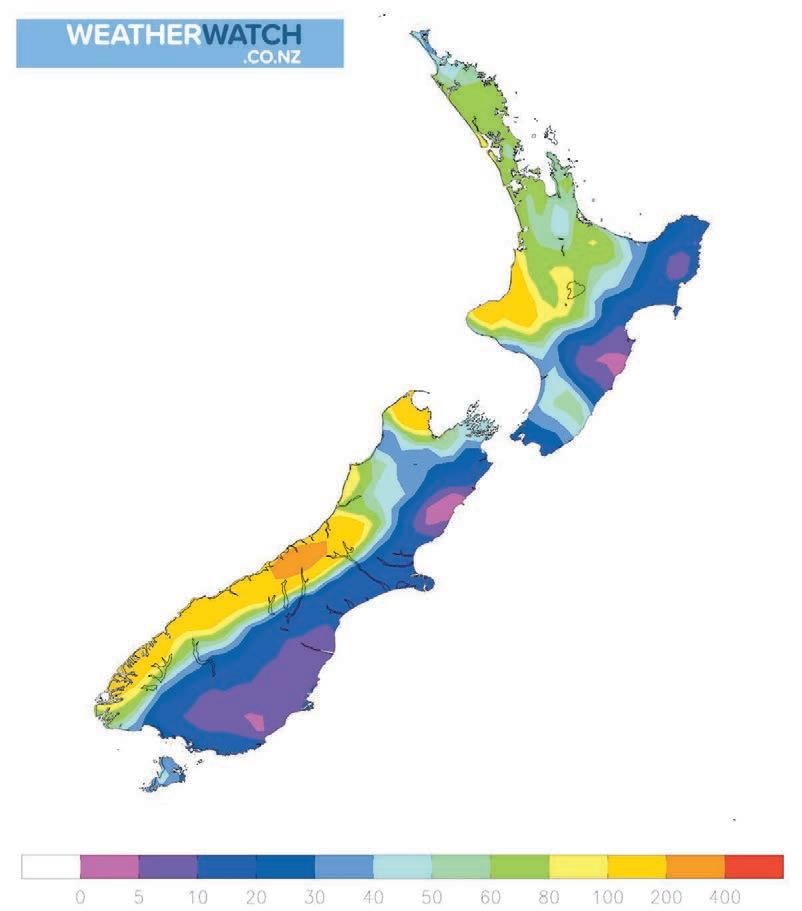
PROSPECTS: This rain map, for 6am Sunday April 21 through to 6am Sunday April 28, captures the next possible low, which is not locked in yet. Use RuralWeather.co.nz for hyper-local forecast totals that are updated hourly.

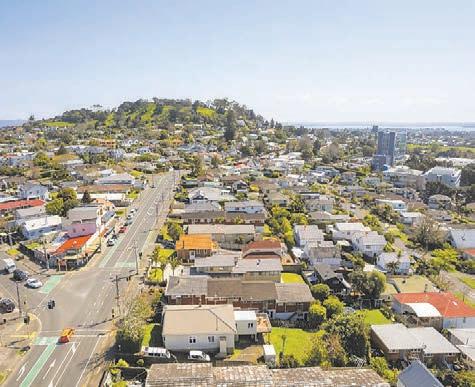

Recently funded investments: ADVERTISEMENT Minimum investment of $100,000 Wholesale investors only No costs or fees deducted Returns are pre-tax Finbase provides private investors, family offices and high net worth individuals who meet relevant wholesale investor criteria an investment backed by First Mortgage Security Investor security: Funds are utilised to provide First ranking mortgages to commercial borrowers for the purposes of short term property projects, maximum 12 month term of any loan Maximum lending of 60% of proper ty value. We will cover your legal and accounting fees of up to $2,500 to discuss this investment opportunity with your professional advisors, with no obligation for you to invest after doing so * Finbase is proud to have never missed an investor interest payment nor suf fered a single loss of investor capital. Earn a fixed return of 11-12% p.a. with interest paid monthly secured by first mortgage. For investment opportunities contact our portfolio managers Fo r m o re i nfo r m at i o n v i s i t o u r we bs i te at w w w fi n ba s e n z 021 143 4291 pernell@finbase nz 021 253 7816 hayden@finbase nz 021 375 636 jordan@finbase nz Pernell Callaghan Hayden Thompson Jordan Evans Finbase is registered as a Financial Services Provider under the Financial Service Providers (Reg stration and D spute Resolution) Act 2008 of New Zealand Its registered number is FSP1003560 *Terms and conditions apply For marketing purposes the images are of suburb locations, not the specific proper t y Eastbourne, Lower Hutt First mortgage security Security description: 140m2 residential home on circa 610m2 of freehold land CV: $1,100,000 Loan request: $565,100 Loan to value ratio (LVR): 51% Term: 12 months Interest rate: 11%p a paid monthly in arrears Purpose of funds: Equity release for the borrower to use on another one of their projects Exit strategy: Sale of security asset to repay the debt Manurewa, Auckland First mortgage security Security description: Circa 140m2 brick and tile home, located on a circa 610m2 freehold site CV: $790,000 Loan request: $445,000 Loan to value ratio (LVR): 56% Term: 6 months Interest rate: 11%p a paid monthly in arrears Purpose of funds: Refinancing the current lender, plus a top up to renovate the property Exit strategy: Sale of security asset to repay the debt Mount Albert, Auckland First mortgage security Security description: Two bedroom residential home with a floor area of circa 100m2, on 630m2 of freehold land CV: $1,850,000 Loan request: $829,600 Loan to value ratio (LVR): 45% Term: 12 months Interest rate: 11%p a paid monthly in arrears Purpose of funds: Equity release to get consent for subdivision, plus working capital Exit strategy: Refinance to specialist construction lender once the consents have been approved 42
ruralweather.co.nz
Weather
Philip Duncan NEWS Weather
































































 Neal Wallace MARKETS Events
Neal Wallace MARKETS Events



 Gerald Piddock TECHNOLOGY Exports
Gerald Piddock TECHNOLOGY Exports









































































 Piddock
Piddock































































































































 AFiona Quarrie MARKETS Livestock
AFiona Quarrie MARKETS Livestock
































